
Notice to ASX Investor Seminar presentation 6 December 2023 Attached is the presentation to be given at the investor seminar today in Sydney at 4.00pm (AEDT) / 5:00am (GMT) by Rio Tinto Chief Executive Jakob Stausholm and other executives. The presentation slides and the live webcast can also be accessed at https://www.riotinto.com/en/invest/investor-seminars. EXHIBIT 99.8
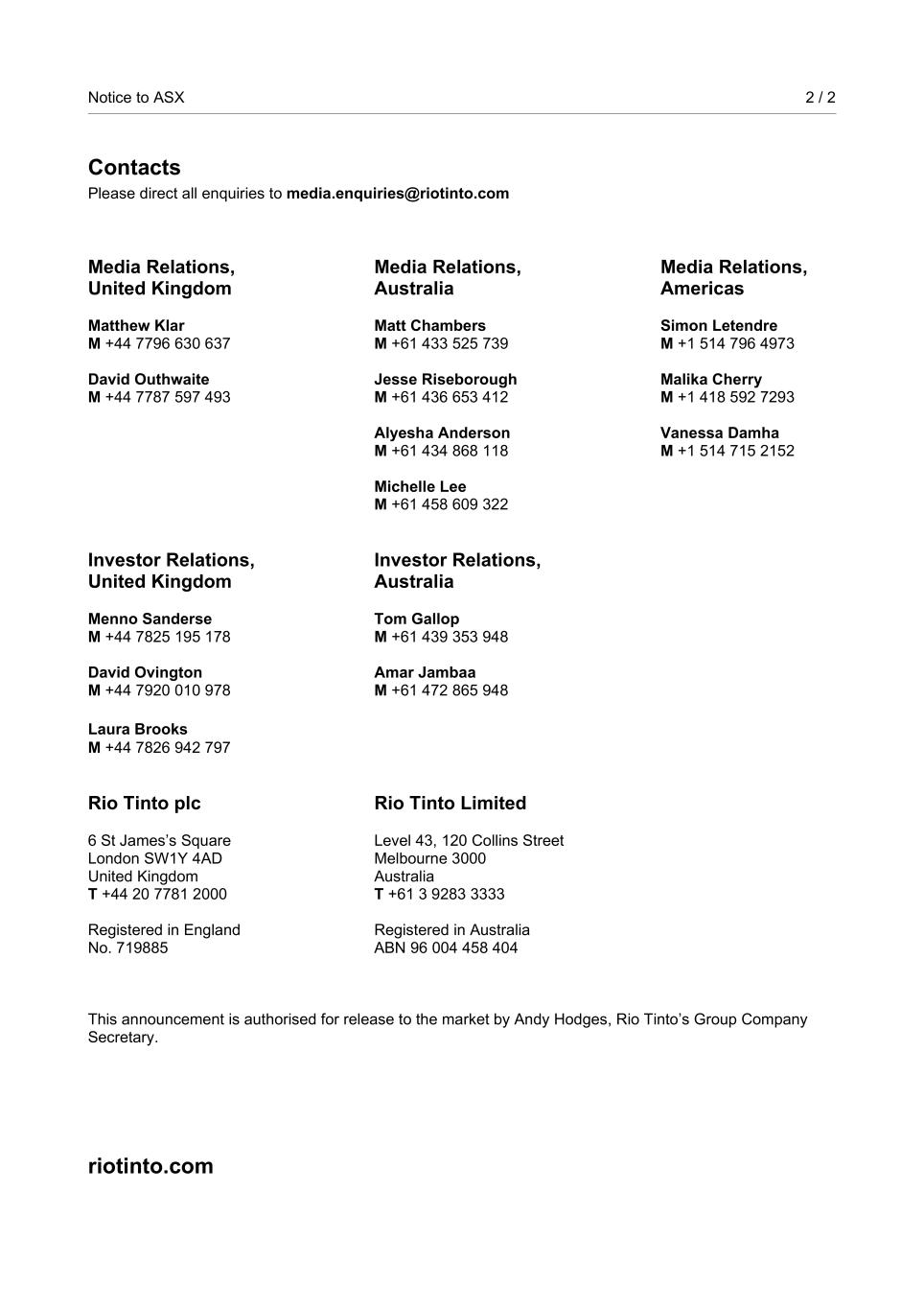
Notice to ASX 2 / 2 Contacts Please direct all enquiries to media.enquiries@riotinto.com Media Relations, United Kingdom Matthew Klar M +44 7796 630 637 David Outhwaite M +44 7787 597 493 Media Relations, Australia Matt Chambers M +61 433 525 739 Jesse Riseborough M +61 436 653 412 Alyesha Anderson M +61 434 868 118 Michelle Lee M +61 458 609 322 Media Relations, Americas Simon Letendre M +1 514 796 4973 Malika Cherry M +1 418 592 7293 Vanessa Damha M +1 514 715 2152 Investor Relations, United Kingdom Menno Sanderse M +44 7825 195 178 David Ovington M +44 7920 010 978 Laura Brooks M +44 7826 942 797 Investor Relations, Australia Tom Gallop M +61 439 353 948 Amar Jambaa M +61 472 865 948 Rio Tinto plc 6 St James’s Square London SW1Y 4AD United Kingdom T +44 20 7781 2000 Registered in England No. 719885 Rio Tinto Limited Level 43, 120 Collins Street Melbourne 3000 Australia T +61 3 9283 3333 Registered in Australia ABN 96 004 458 404 This announcement is authorised for release to the market by Andy Hodges, Rio Tinto’s Group Company Secretary. riotinto.com
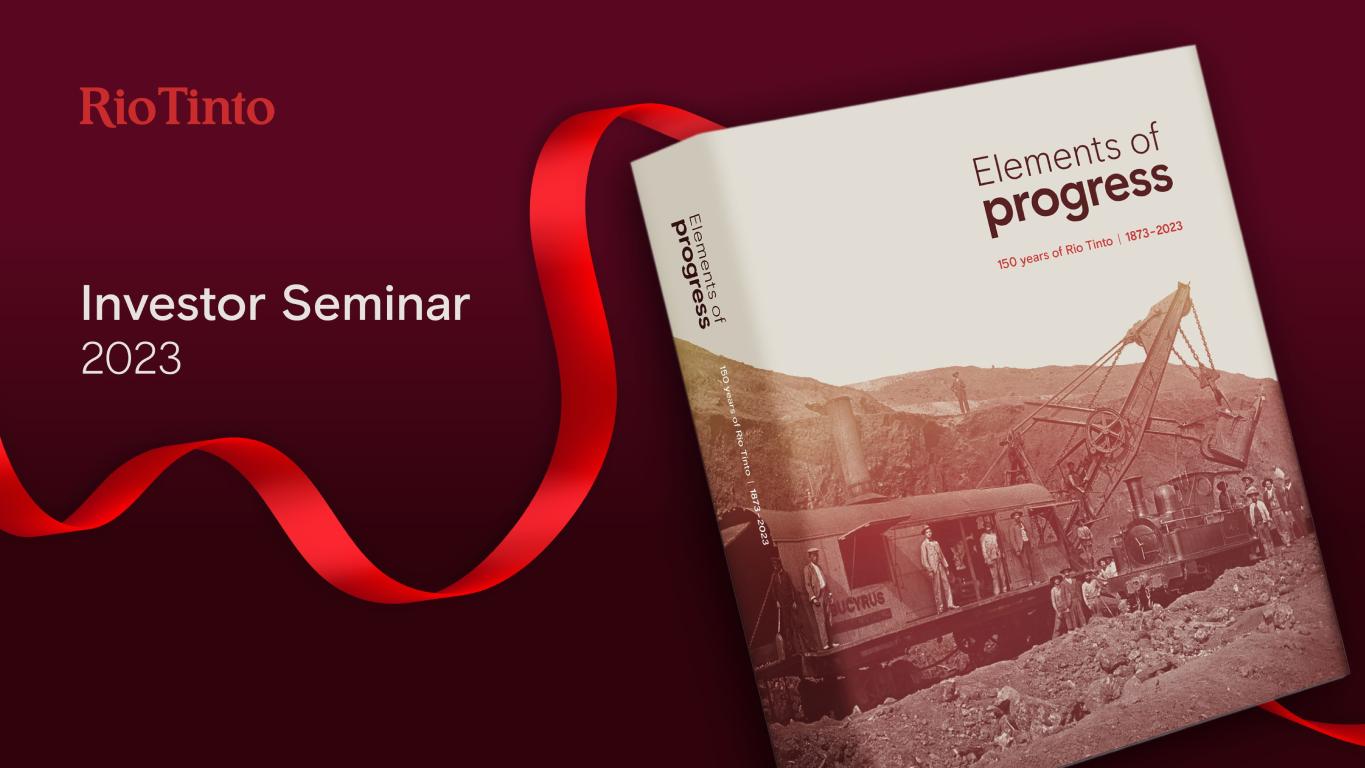
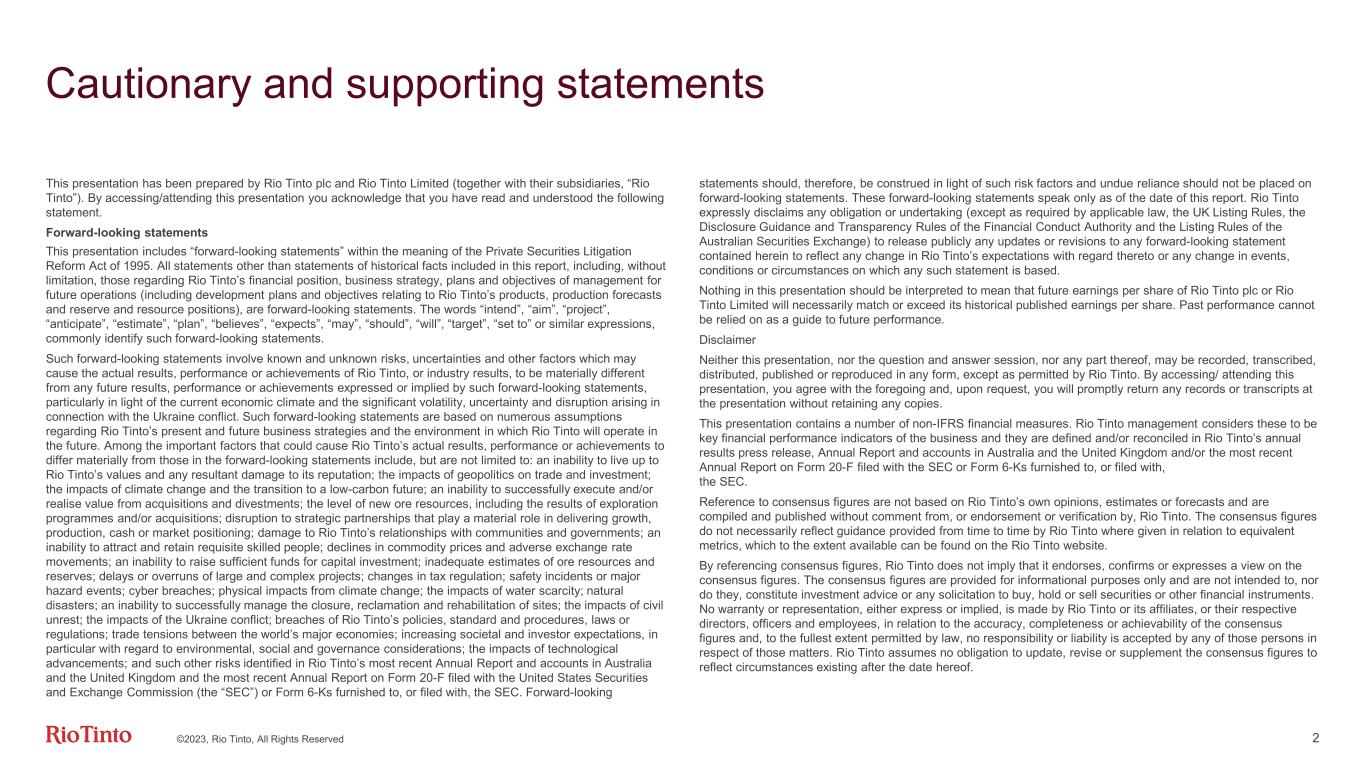
©2023, Rio Tinto, All Rights Reserved 2 Cautionary and supporting statements This presentation has been prepared by Rio Tinto plc and Rio Tinto Limited (together with their subsidiaries, “Rio Tinto”). By accessing/attending this presentation you acknowledge that you have read and understood the following statement. Forward-looking statements This presentation includes “forward-looking statements” within the meaning of the Private Securities Litigation Reform Act of 1995. All statements other than statements of historical facts included in this report, including, without limitation, those regarding Rio Tinto’s financial position, business strategy, plans and objectives of management for future operations (including development plans and objectives relating to Rio Tinto’s products, production forecasts and reserve and resource positions), are forward-looking statements. The words “intend”, “aim”, “project”, “anticipate”, “estimate”, “plan”, “believes”, “expects”, “may”, “should”, “will”, “target”, “set to” or similar expressions, commonly identify such forward-looking statements. Such forward-looking statements involve known and unknown risks, uncertainties and other factors which may cause the actual results, performance or achievements of Rio Tinto, or industry results, to be materially different from any future results, performance or achievements expressed or implied by such forward-looking statements, particularly in light of the current economic climate and the significant volatility, uncertainty and disruption arising in connection with the Ukraine conflict. Such forward-looking statements are based on numerous assumptions regarding Rio Tinto’s present and future business strategies and the environment in which Rio Tinto will operate in the future. Among the important factors that could cause Rio Tinto’s actual results, performance or achievements to differ materially from those in the forward-looking statements include, but are not limited to: an inability to live up to Rio Tinto’s values and any resultant damage to its reputation; the impacts of geopolitics on trade and investment; the impacts of climate change and the transition to a low-carbon future; an inability to successfully execute and/or realise value from acquisitions and divestments; the level of new ore resources, including the results of exploration programmes and/or acquisitions; disruption to strategic partnerships that play a material role in delivering growth, production, cash or market positioning; damage to Rio Tinto’s relationships with communities and governments; an inability to attract and retain requisite skilled people; declines in commodity prices and adverse exchange rate movements; an inability to raise sufficient funds for capital investment; inadequate estimates of ore resources and reserves; delays or overruns of large and complex projects; changes in tax regulation; safety incidents or major hazard events; cyber breaches; physical impacts from climate change; the impacts of water scarcity; natural disasters; an inability to successfully manage the closure, reclamation and rehabilitation of sites; the impacts of civil unrest; the impacts of the Ukraine conflict; breaches of Rio Tinto’s policies, standard and procedures, laws or regulations; trade tensions between the world’s major economies; increasing societal and investor expectations, in particular with regard to environmental, social and governance considerations; the impacts of technological advancements; and such other risks identified in Rio Tinto’s most recent Annual Report and accounts in Australia and the United Kingdom and the most recent Annual Report on Form 20-F filed with the United States Securities and Exchange Commission (the “SEC”) or Form 6-Ks furnished to, or filed with, the SEC. Forward-looking statements should, therefore, be construed in light of such risk factors and undue reliance should not be placed on forward-looking statements. These forward-looking statements speak only as of the date of this report. Rio Tinto expressly disclaims any obligation or undertaking (except as required by applicable law, the UK Listing Rules, the Disclosure Guidance and Transparency Rules of the Financial Conduct Authority and the Listing Rules of the Australian Securities Exchange) to release publicly any updates or revisions to any forward-looking statement contained herein to reflect any change in Rio Tinto’s expectations with regard thereto or any change in events, conditions or circumstances on which any such statement is based. Nothing in this presentation should be interpreted to mean that future earnings per share of Rio Tinto plc or Rio Tinto Limited will necessarily match or exceed its historical published earnings per share. Past performance cannot be relied on as a guide to future performance. Disclaimer Neither this presentation, nor the question and answer session, nor any part thereof, may be recorded, transcribed, distributed, published or reproduced in any form, except as permitted by Rio Tinto. By accessing/ attending this presentation, you agree with the foregoing and, upon request, you will promptly return any records or transcripts at the presentation without retaining any copies. This presentation contains a number of non-IFRS financial measures. Rio Tinto management considers these to be key financial performance indicators of the business and they are defined and/or reconciled in Rio Tinto’s annual results press release, Annual Report and accounts in Australia and the United Kingdom and/or the most recent Annual Report on Form 20-F filed with the SEC or Form 6-Ks furnished to, or filed with, the SEC. Reference to consensus figures are not based on Rio Tinto’s own opinions, estimates or forecasts and are compiled and published without comment from, or endorsement or verification by, Rio Tinto. The consensus figures do not necessarily reflect guidance provided from time to time by Rio Tinto where given in relation to equivalent metrics, which to the extent available can be found on the Rio Tinto website. By referencing consensus figures, Rio Tinto does not imply that it endorses, confirms or expresses a view on the consensus figures. The consensus figures are provided for informational purposes only and are not intended to, nor do they, constitute investment advice or any solicitation to buy, hold or sell securities or other financial instruments. No warranty or representation, either express or implied, is made by Rio Tinto or its affiliates, or their respective directors, officers and employees, in relation to the accuracy, completeness or achievability of the consensus figures and, to the fullest extent permitted by law, no responsibility or liability is accepted by any of those persons in respect of those matters. Rio Tinto assumes no obligation to update, revise or supplement the consensus figures to reflect circumstances existing after the date hereof.

©2023, Rio Tinto, All Rights Reserved 3 Cautionary and supporting statements (cont.) Oyu Tolgoi - Production Targets The 500ktpa copper production target (stated as recoverable metal) for the Oyu Tolgoi underground and open pit mines for the years 2028 to 2036 referenced in slides 59 and 60 and the production profiles for the Oyu Tolgoi underground and open pit mines shown in slide 61 were previously reported in a release to the Australian Securities Exchange (ASX) dated 11 July 2023 “Investor site visit to Oyu Tolgoi copper mine, Mongolia”. All material assumptions underpinning that production target and those production profiles continue to apply and have not materially changed. Copper portfolio - Mineral Resources and Ore Reserves All Mineral Resources and Ore Reserves referenced on slide 59 are based on the Mineral Resources and Ore Reserves as reported in accordance with the Australasian Code for Reporting of Exploration Results, Minerals Resources and Ore Reserves, 2012 Edition (JORC Code) and the ASX Listing Rules in Rio Tinto’s 2022 Annual Report released to the ASX on 24 February 2023 (Rio Tinto's 2022 Annual Report) and available at riotinto.com. The total Oyu Tolgoi Mineral Resources referenced on slide 59 comprise 83 Mt @ 1.44% Cu and 0.53 g/t Au Measured Mineral Resources, 608 Mt @ 1.18% Cu and 0.39 g/t Au Indicated Mineral Resources and 3,688 Mt @ 0.59% Cu and 0.29 g/t Au Inferred Mineral Resources for a total of 4,380 Mt @ 0.69% Cu and 0.31 g/t Au Mineral Resources. The total Oyu Tolgoi Ore Reserves referenced on slide 59 comprise 246 Mt @ 0.53% Cu and 0.39 g/t Au Proved Ore Reserves and 903 Mt @ 0.97% Cu and 0.28 g/t Au Probable Ore Reserves for a total of 1,149 Mt @ 0.87% Cu and 0.30 g/t Au Ore Reserves. The Competent Person responsible for the information in the 2022 Annual Report that relates to Oyu Tolgoi Mineral Resources is Oyunjargal Dendev, who is a Member of the Australasian Institute of Mining and Metallurgy (MAusIMM). The Competent Persons responsible for the information in the 2022 Annual Report that relates to Oyu Tolgoi Ore Reserves are Barry Ndlovu and Nathan Robinson, both of whom are Members of the Australasian Institute of Mining and Metallurgy (MAusIMM). The Escondida Mineral Resources referenced on slide 59 comprise 692 Mt @ 0.48% Cu Measured Mineral Resources, 2,871 Mt @ 0.51% Cu Indicated Mineral Resources and 15,758 Mt @ 0.50% Cu Inferred Mineral Resources for a total of 19,321 Mt @ 0.50% Cu Mineral Resources. The Escondida Ore Reserves referenced on slide 59 comprise 4,640 Mt @ 0.61% Cu Proved Ore Reserves and 2,030 Mt @ 0.55% Cu Probable Ore Reserves for a total of 6,670 Mt @ 0.59% Cu Ore Reserves. The Competent Person responsible for the information in the 2022 Annual Report that relates to Escondida Mineral Resources is Rodrigo Maureira, who is a Member of the Australasian Institute of Mining and Metallurgy (MAusIMM). The Competent Person responsible for the information in the 2022 Annual Report that relates to Escondida Ore Reserves is Francisco Barrera Vergara, who is a Member of the Australasian Institute of Mining and Metallurgy (MAusIMM). The Resolution Mineral Resources referenced on slide 59 comprise 724 Mt of Indicated Mineral Resources @ 1.89% Cu and 1,134 Mt Inferred Mineral Resources @ 1.28% Cu for a total of 1,859 Mt @ 1.52% Cu Mineral Resources. The Competent Persons responsible for the information in the 2022 Annual Report that relates to Resolution Mineral Resources are Hamish Martin, Joanna Marshall and Adam Schwarz, whom are all Members of the Australasian Institute of Mining and Metallurgy (MAusIMM). The La Granja Mineral Resources referenced on slide 59 comprise 130 Mt of Indicated Mineral Resources @ 0.85 and 4,190 Mt Inferred Mineral Resources @ 0.50% Cu for a total of 4,320 Mt @ 0.51% Cu Mineral Resources. The Competent Person responsible for the information in the 2022 Annual Report that relates to La Granja Mineral Resources is Joanna Marshall, who is a Member of the Australasian Institute of Mining and Metallurgy (MAusIMM). Rio Tinto confirms that it is not aware of any new information or data that materially affects the information included in the 2022 Annual Report, that all material assumptions and technical parameters underpinning the estimates in the 2022 Annual Report continue to apply and have not materially changed, and that the form and context in which the Competent Persons’ findings are presented have not been materially modified. Mineral Resources are reported in addition to Ore Reserves. Mineral Resources and Ore Reserves are reported on a 100% basis. Rhodes Ridge - Mineral Resources The Mineral Resources reported for the Rhodes Ridge Joint Venture between Rio Tinto (50 per cent) and Wright Prospecting Pty Ltd (50 per cent) on slide 67 form part of the Pilbara Mineral Resource estimates reported in accordance with the JORC Code and the ASX Listing Rules in Rio Tinto’s 2022 Annual Report. These Mineral Resources are not materially different to the breakdown of the Rhodes Ridge Mineral Resources reported in Rio Tinto’s 2020 Annual Report released to the ASX on 22 February 2021. The Competent Persons responsible for reporting these Mineral Resource estimates were Mr P Savory, who is a Fellow of The Australasian Institute of Mining and Metallurgy, and Ms N Brajkovich, Mr C Kyngdon, Mr M Judge and Ms A Latscha who are Members of The Australasian Institute of Mining and Metallurgy. Rhodes Ridge contains 6.8 billion tonnes of Mineral Resources at an average grade of 61.6% Fe; comprising 0.8 billion tonnes of Indicated Mineral Resources at an average grade of 62.4% Fe and 6.0 billion tonnes of Inferred Mineral Resources at an average grade of 61.5% Fe. These Mineral Resources include: • 0.6 billion tonnes of high grade Brockman Indicated Mineral Resources at an average grade of 63.9% Fe and 0.03 billion tonnes of high grade Detrital Indicated Mineral Resources at an average grade of 61.3% Fe. • 5.3 billion tonnes of high grade Brockman, Marra Mamba and Detrital Inferred Mineral Resources at an average grade of 62.2% Fe. Rio Tinto confirms that it is not aware of any new information or data that materially affects the information included in the 2022 Annual Report, that all material assumptions and technical parameters underpinning the estimates in the 2022 Annual Report continue to apply and have not materially changed, and that the form and context in which the Competent Persons’ findings are presented have not been materially modified. Mineral Resources are quoted on a 100 per cent basis, as dry in-situ tonnes.

©2023, Rio Tinto, All Rights Reserved 4 Cautionary and supporting statements (cont.) Simandou - Mineral Resources and Ore Reserves Simandou Mineral Resources and Ore Reserves reference on slides 74 and 98 have been reported in accordance with the JORC Code and the ASX Listing Rules in a release dated 6 December 2023 titled “Release of Mineral Resource and Ore Reserve Estimates for Simandou” (Table 1 Release) which is available on Rio Tinto's website at resources & reserves (riotinto.com). The Simandou Mineral Resources comprise 0.1 Bt @ 67.1% Fe of Measured Mineral Resources, 0.4 Bt @ 66.2% Fe of Indicated Mineral Resources, and 0.8 Bt @ 65.8% Fe of Inferred Mineral Resources. The Simandou Ore Reserves comprise 0.3 Bt @ 66.4% Fe of Proved Ore Reserves and 1.2 Bt @ 65.0% Fe of Probable Ore Reserves. The Competent Person responsible for the information in the Table 1 Release that relates to Mineral Resources is Kaye Tindale, a Member of the Australasian Institute of Mining and Metallurgy (MAusIMM). The Competent Person responsible for the information in that release that relates to Ore Reserves is Michael Apfel, a Member of the Australasian Institute of Mining and Metallurgy (MAusIMM). Rio Tinto confirms that it is not aware of any new information or data that materially affects the information included in the Table 1 Release, that all material assumptions and technical parameters underpinning the estimates in the Table 1 Release continue to apply and have not materially changed, and that the form and context in which the Competent Persons’ findings are presented have not been materially modified. Mineral Resources are reported in addition to Ore Reserves. All Mineral Resources and Ore Reserves are reported on a 100% basis. Simandou - Production Targets The estimated annualised capacity of approximately 60 million dry tonnes per annum iron ore for the life of mine schedule referenced in slides 74, 76, 78 and 98 is underpinned as to 18% by Proved Ore Reserves and 82% by Probable Ore Reserves as set out in the Table 1 Release. Rio Tinto confirms that all material assumptions underpinning the production target in the Table 1 Release continue to apply and have not materially changed. The financial forecasts shown on slide 73 and 98 are based on this life of mine production target. Mineral Resources and Ore Reserves – Global Iron Ore portfolio Rio Tinto’s Iron Ore Mineral Resources and Ore Reserves reported as part of Rio Tinto’s global portfolio on slide 74 include Simandou as shown in the Simandou note on this slide (categorised as “>65% Fe”), together with the Iron Ore Company of Canada (IOC) and Pilbara Operations as reported in Rio Tinto’s 2022 Annual Report. The 28 Bt of Mineral Resources comprise the Simandou Mineral Resources plus: from IOC (categorised as “>65% Fe” due to the ability to upgrade the feed) 0.2 Bt @ 40.8% Fe of Measured Mineral Resources, 0.7 Bt @ 38.5% Fe of Indicated Mineral Resources, and 0.8 Bt @ 38.3% Fe of Inferred Mineral Resources (for which the Competent Persons were M McDonald (PEGNL), B Power (PEGNL), and R Way (PEGNL)); and from the Pilbara Operations (with all Boolgeeda, Brockman Process Ore, Channel Iron Deposit and Detrital Mineral Resources categorised as “<61% Fe”, and all Brockman and Marra Mamba Mineral Resources categorised as “>61% Fe”) 1.8 Bt @ 59.4% Fe of Measured Mineral Resources, 4.5 Bt @ 60.1% Fe of Indicated Mineral Resources, and 18.6 Bt @ 59.7% Fe of Inferred Mineral Resources (for which the Competent Persons were N Brajkovich (AusIMM), P Savory (AusIMM), M Judge (AusIMM), A Latscha (AusIMM) and C Kyngdon (AusIMM)). The 5 Bt of Ore Reserves comprise the Simandou Ore Reserves plus: from IOC (categorised as “>65% Fe” due to the ability to upgrade the feed) 0.3 Bt @ 65.0% Fe of Proved Ore Reserves and 0.2 Bt @ 65.0% Fe of Probable Ore Reserves (for which the Competent Persons were R Williams (PEGNL) and P Ziemendorf (AusIMM)); and from the Pilbara (with all Pisolite Ore Reserves categorised as “<61% Fe”, and all Brockman and Marra Mamba Ore Reserves categorised as “>61% Fe”) 1.4 Bt @ 60.7% Fe of Proved Ore Reserves and 1.3 Bt @ 61.2% Fe of Probable Ore Reserves (for which the Competent Persons were P Barnes (AusIMM), R Bleakley (AusIMM), L Vilela Couto (AusIMM) and R Sarin (AusIMM)). Rio Tinto confirms that it is not aware of any new information or data that materially affects the abovementioned information included in the 2022 Annual Report, that all material assumptions and technical parameters underpinning the abovementioned estimates in the 2022 Annual Report continue to apply and have not materially changed, and that the form and context in which the Competent Persons’ findings are presented have not been materially modified. Mineral Resources are reported in addition to Ore Reserves. All Mineral Resources and Ore Reserves are reported on a 100% basis.
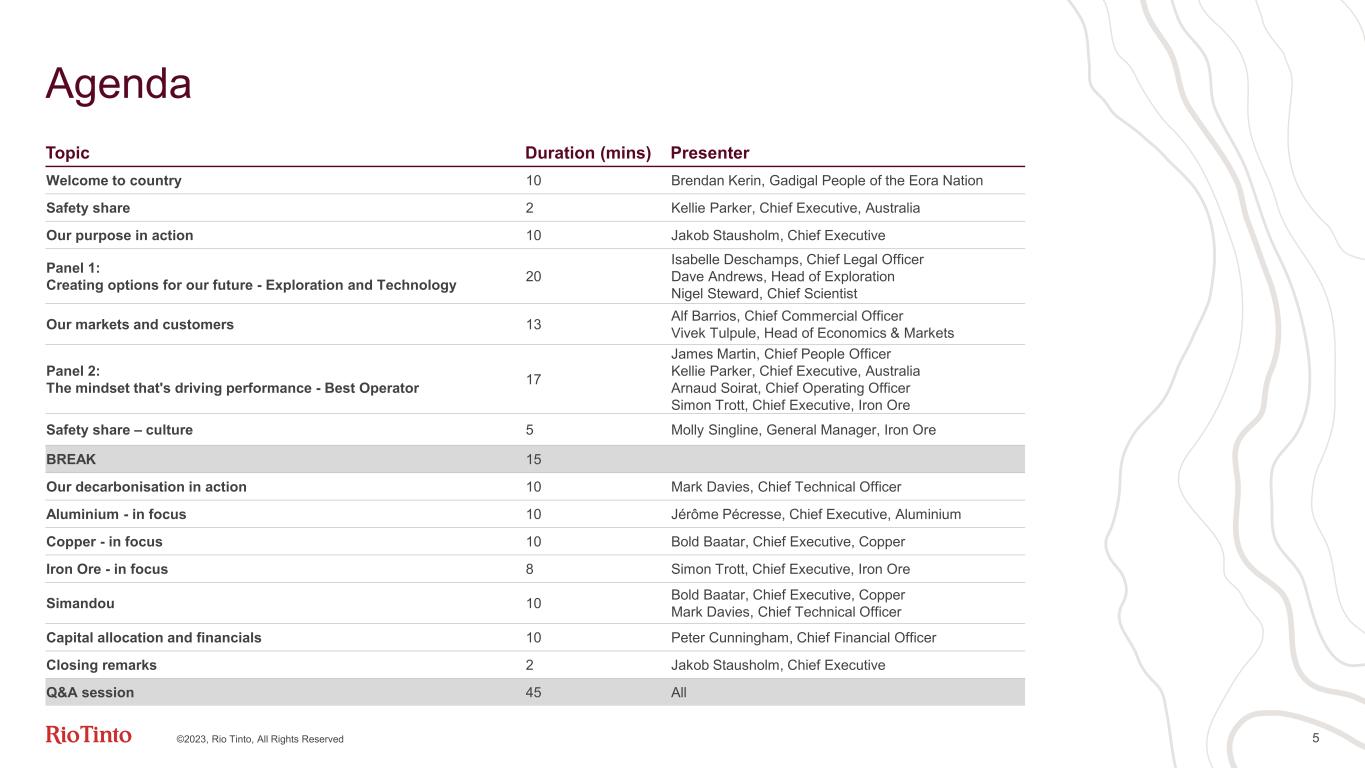
Topic Duration (mins) Presenter Welcome to country 10 Brendan Kerin, Gadigal People of the Eora Nation Safety share 2 Kellie Parker, Chief Executive, Australia Our purpose in action 10 Jakob Stausholm, Chief Executive Panel 1: Creating options for our future - Exploration and Technology 20 Isabelle Deschamps, Chief Legal Officer Dave Andrews, Head of Exploration Nigel Steward, Chief Scientist Our markets and customers 13 Alf Barrios, Chief Commercial Officer Vivek Tulpule, Head of Economics & Markets Panel 2: The mindset that's driving performance - Best Operator 17 James Martin, Chief People Officer Kellie Parker, Chief Executive, Australia Arnaud Soirat, Chief Operating Officer Simon Trott, Chief Executive, Iron Ore Safety share – culture 5 Molly Singline, General Manager, Iron Ore BREAK 15 Our decarbonisation in action 10 Mark Davies, Chief Technical Officer Aluminium - in focus 10 Jérôme Pécresse, Chief Executive, Aluminium Copper - in focus 10 Bold Baatar, Chief Executive, Copper Iron Ore - in focus 8 Simon Trott, Chief Executive, Iron Ore Simandou 10 Bold Baatar, Chief Executive, Copper Mark Davies, Chief Technical Officer Capital allocation and financials 10 Peter Cunningham, Chief Financial Officer Closing remarks 2 Jakob Stausholm, Chief Executive Q&A session 45 All ©2023, Rio Tinto, All Rights Reserved 5 Agenda

©2023, Rio Tinto, All Rights Reserved 6 Investor Seminar presenters Alf Barrios Chief Commercial Officer Simon Trott Chief Executive Iron Ore Jérôme Pécresse Chief Executive Aluminium Isabelle Deschamps Chief Legal, Governance and Corporate Affairs Officer Kellie Parker Chief Executive Australia Arnaud Soirat Chief Operating Officer James Martin Chief People Officer Peter Cunningham Chief Financial Officer Jakob Stausholm Chief Executive Mark Davies Chief Technical Officer Bold Baatar Chief Executive Copper Vivek Tulpule Chief Economist Executive Committee Nigel Steward Chief Scientist Dave Andrews Head of Exploration

Welcome to country Brendan Kerin - Gadigal People of the Eora Nation ©2023, Rio Tinto, All Rights Reserved 7
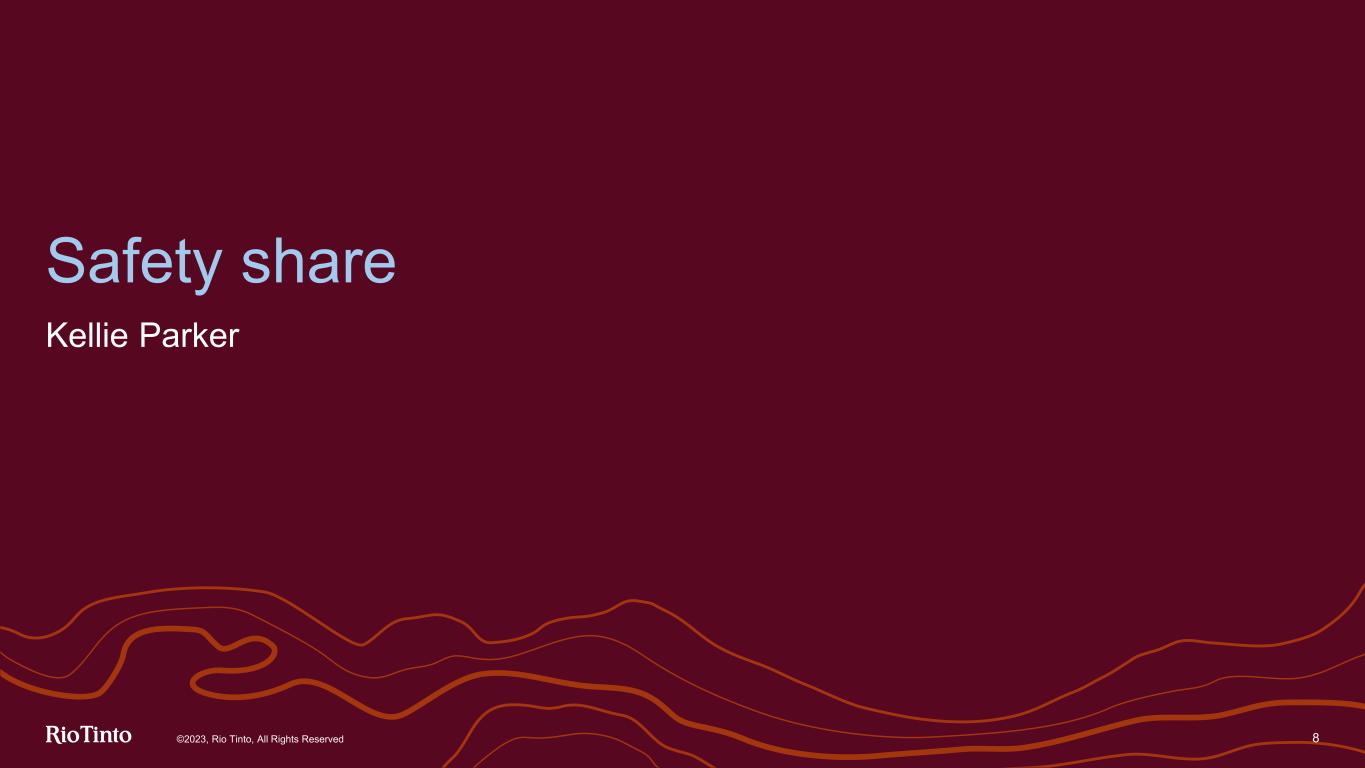
Safety share Kellie Parker ©2023, Rio Tinto, All Rights Reserved 8

Our purpose in action Jakob Stausholm ©2023, Rio Tinto, All Rights Reserved 9
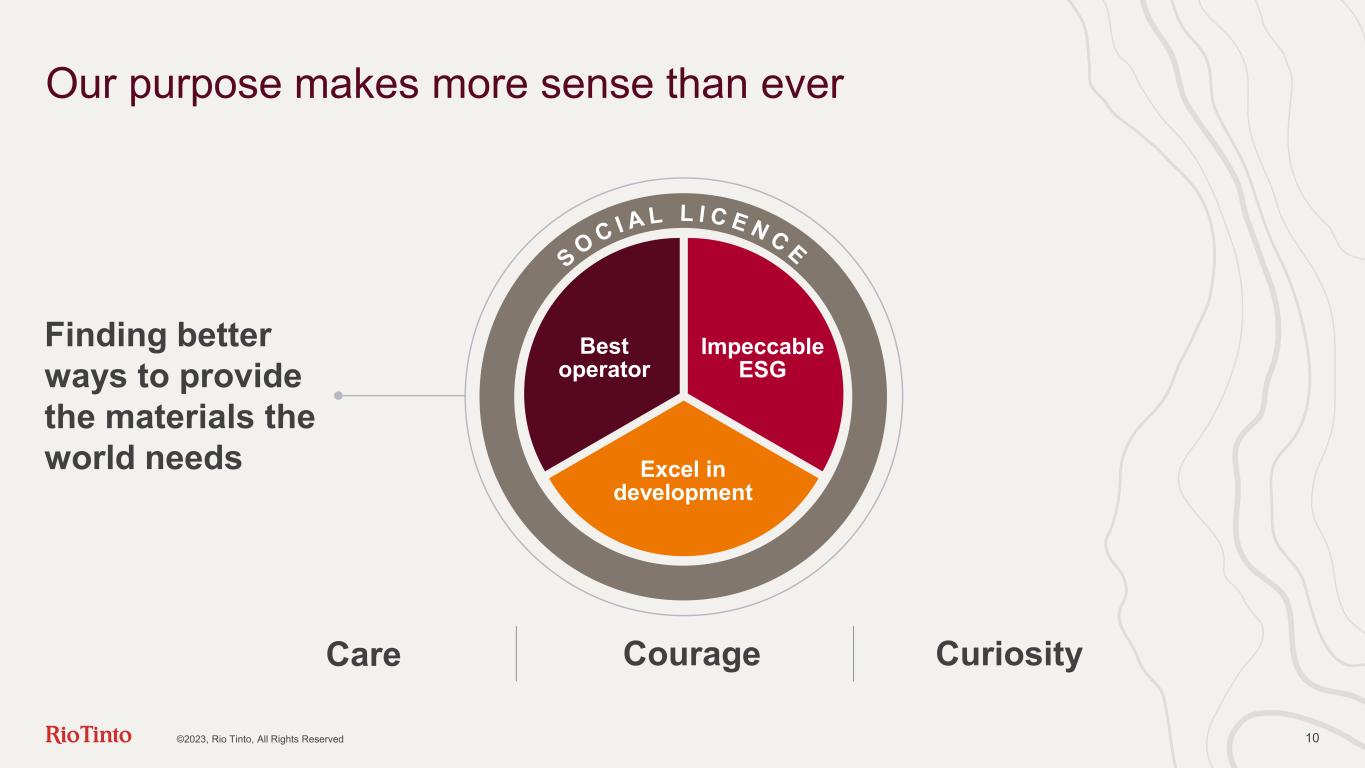
Excel in development Best operator Impeccable ESG ©2023, Rio Tinto, All Rights Reserved 10 Our purpose makes more sense than ever Finding better ways to provide the materials the world needs Care Courage Curiosity

©2023, Rio Tinto, All Rights Reserved 11 Strategy proving itself in an opportunity-rich world The opportunity Traditional demand Deepening ties with Asia Energy transition Supply security Re-industrialisation in the west Evolving societal expectations Global presence Operate across the value chain Deep technical skills Strong exploration track record Closer to customers Partnerships that create greater value Our advantages Brockman 4 - Pilbara BlueSmeltingTM at RTIT Matalco JV Mining Processing Commercial

Excel in development Best operator Impeccable ESG Care Courage Curiosity Investing in the health of our business Our people | Our ore bodies | Our assets Continuous improvement mindset More productive and resilient assets Better operational and financial performance ©2023, Rio Tinto, All Rights Reserved 12 Dampier Port, Australia

Pilbara renewables Partnering with Yindjibarndi Energy Western Range + Four replacement mines + Rhodes Ridge AP60 – low carbon technology Commenced early works ©2023, Rio Tinto, All Rights Reserved 13 Shaping our portfolio for the future Simandou – high grade iron ore Completed bankable feasibility study Matalco – aluminium recycling JV completed Oyu Tolgoi Ramping up to 500ktpa (100% basis)1 1 See supporting references on slide 3
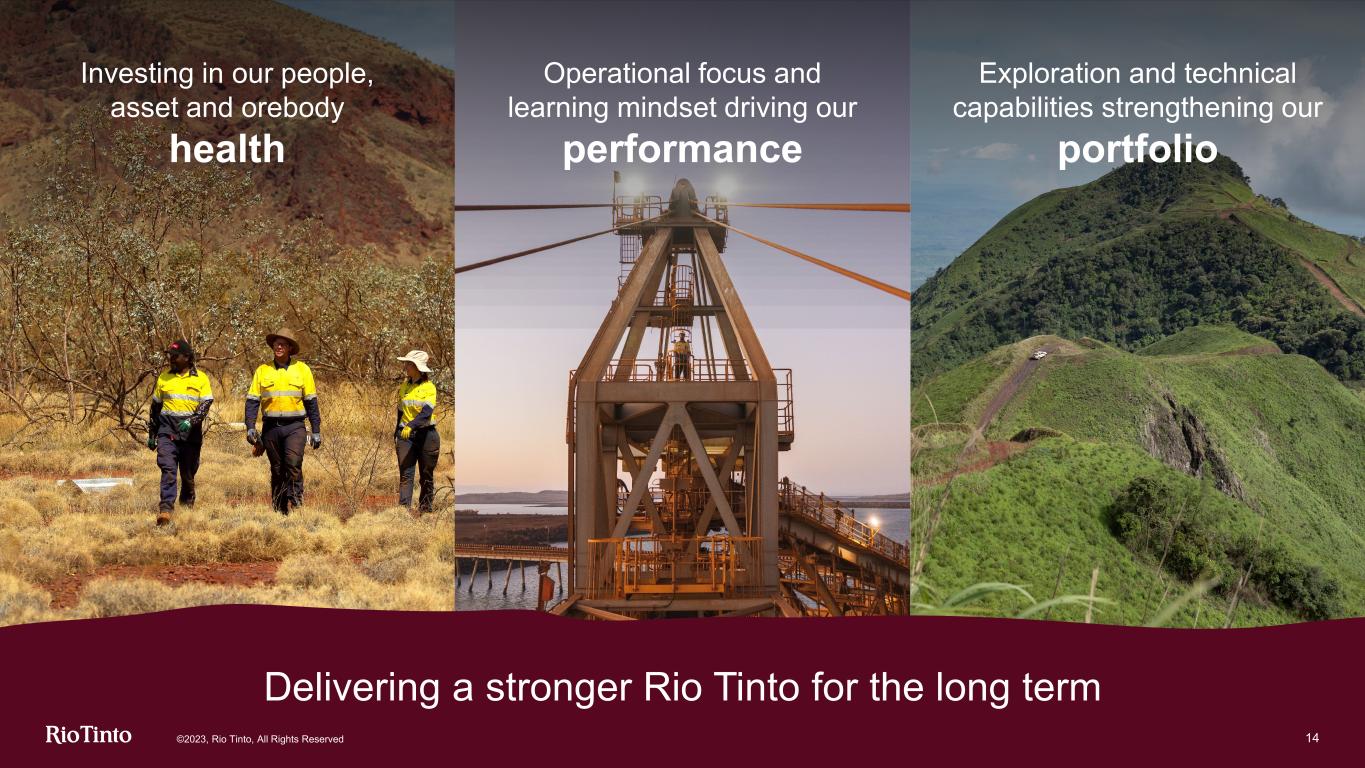
Exploration and technical capabilities strengthening our portfolio Operational focus and learning mindset driving our performance Investing in our people, asset and orebody health Delivering a stronger Rio Tinto for the long term ©2023, Rio Tinto, All Rights Reserved 14
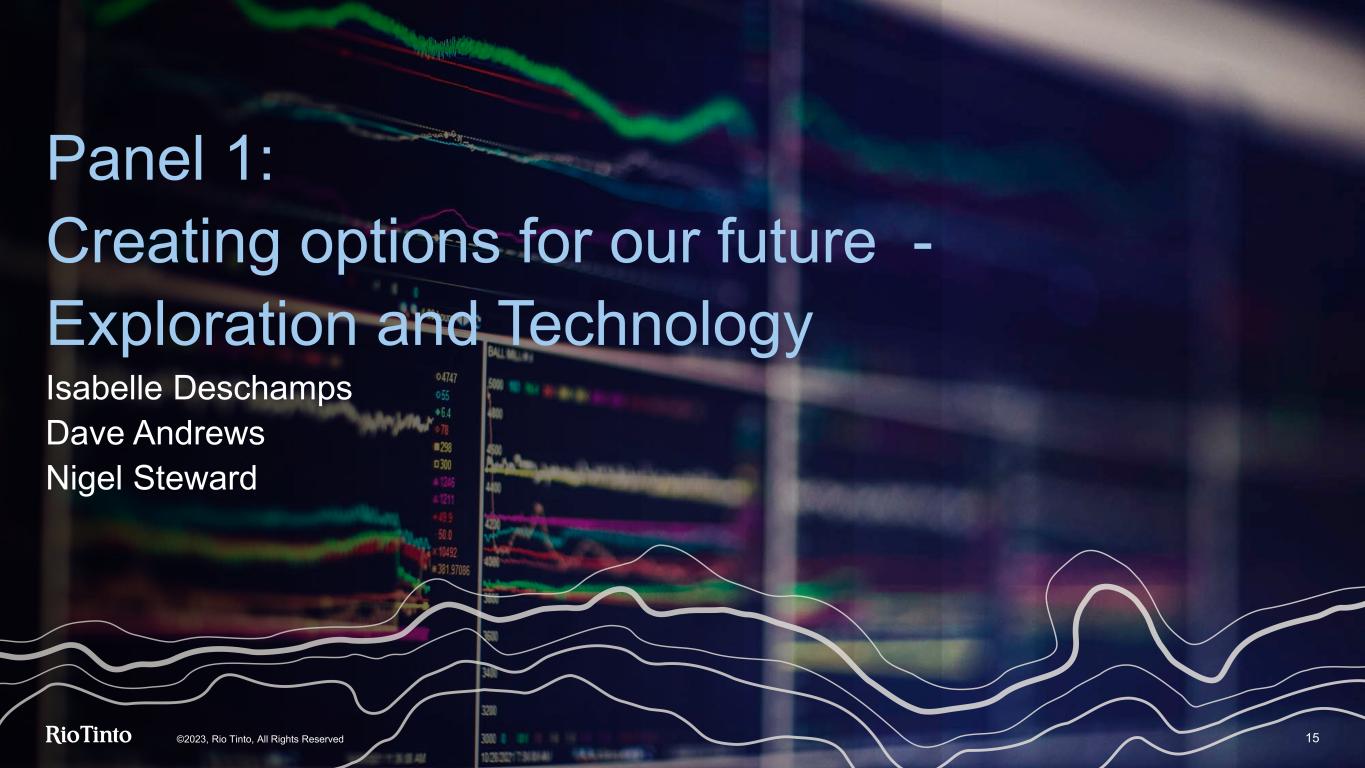
Panel 1: Creating options for our future - Exploration and Technology Isabelle Deschamps Dave Andrews Nigel Steward 15©2023, Rio Tinto, All Rights Reserved
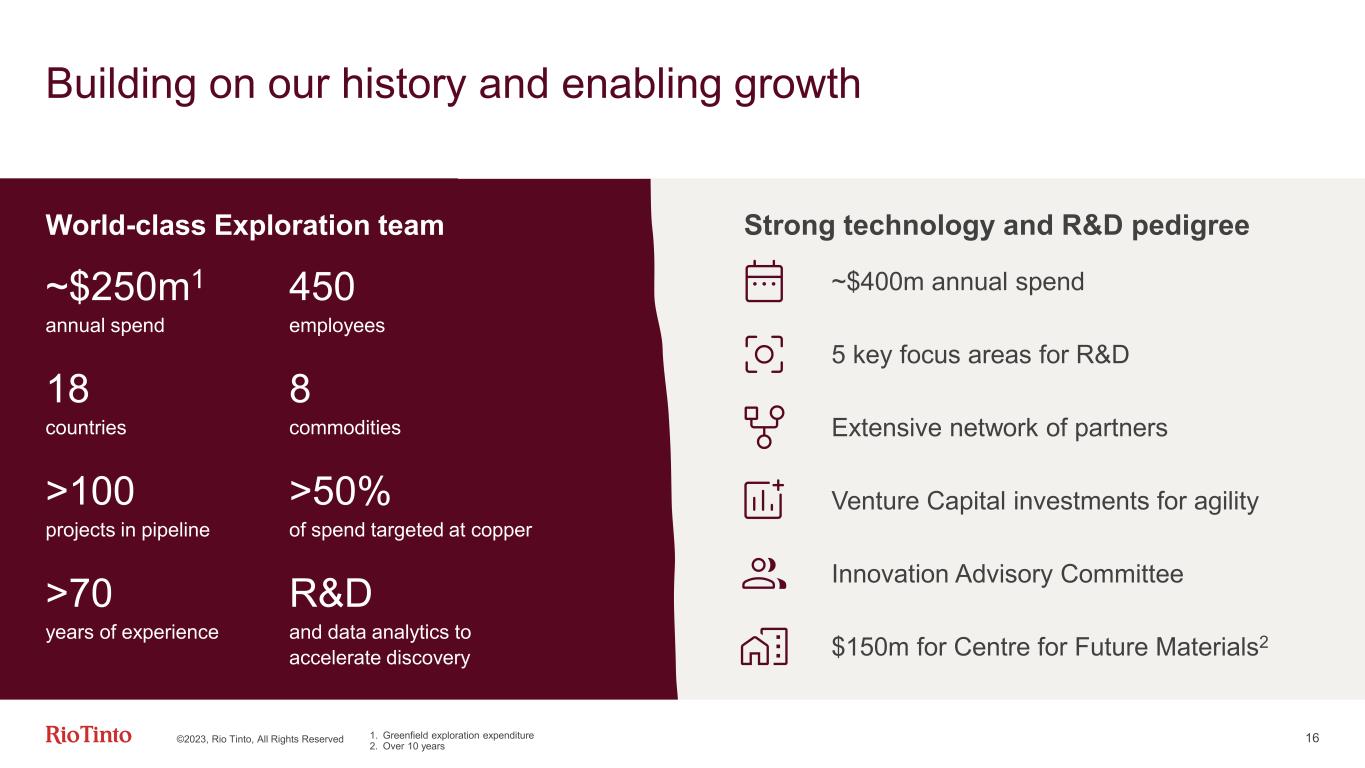
©2023, Rio Tinto, All Rights Reserved 16 Building on our history and enabling growth World-class Exploration team ~$400m annual spend 5 key focus areas for R&D Extensive network of partners Venture Capital investments for agility Innovation Advisory Committee $150m for Centre for Future Materials2 ~$250m1 annual spend 450 employees 18 countries 8 commodities >100 projects in pipeline >50% of spend targeted at copper >70 years of experience R&D and data analytics to accelerate discovery Strong technology and R&D pedigree 1. Greenfield exploration expenditure 2. Over 10 years
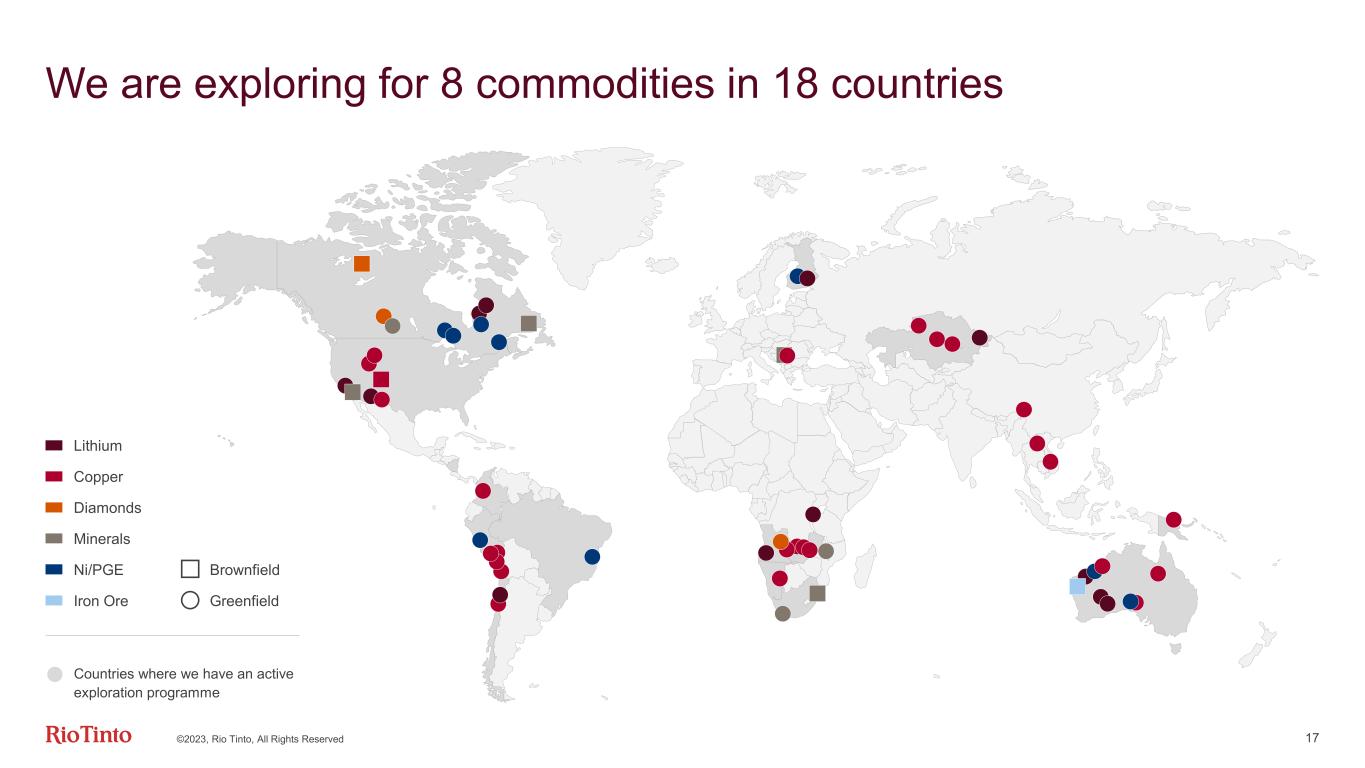
©2023, Rio Tinto, All Rights Reserved 17 We are exploring for 8 commodities in 18 countries Countries where we have an active exploration programme Lithium Copper Diamonds Minerals Ni/PGE Iron Ore Brownfield Greenfield

©2023, Rio Tinto, All Rights Reserved 18 Our core purpose in exploration is discovery by finding or acquiring high-quality growth options Innovative, assertive, challenge the norms approach across all exploration terrains Support for Minimum Viable Projects with growth options, recognising Tier 1 projects grow over time Dynamic portfolio of projects, broad spread of options Enhance reputation as a respected, trusted partner by communities, Indigenous groups and local governments Organically-driven growth options while remaining opportunistic (countries, commodities, partners) Focus on metals in support of the energy transition (copper, lithium, nickel)

©2023, Rio Tinto, All Rights Reserved 19 Seven decades of industry-leading discovery and development performance 1956 South Africa Palabora Copper 1955 Australia Weipa Bauxite 1962 Australia Tom Price Iron Ore CZP 1968 PNG OK Tedi Copper 1975 Australia Koodaideri 1 Bedded Iron Ore 1991 PNG Wafi Gold 1996 Canada Diavik Diamonds 1996 Lao PDR Sepon Copper 2004 Guinea Simandou Iron Ore 2008 India Bunder Diamonds 2011 Brazil Amargosa Bauxite 2020 Australia Winu Copper 1964 PNG Panguna Copper 1972 South Africa Richards Bay Ilmenite 1979 Australia Argyle Diamonds 1983 PNG Lihir Gold 1993 Australia Century Zinc 2002 USA Resolution Copper 2005 Australia Caliwingina Iron Ore 2007 Australia Caliwingina Nth. Iron Ore 2004 Serbia Jadar Lithium 2014 Australia YandiBraid2 Iron Ore 2022 USA Tamarack Nickel Rio Tinto current or formerly owned/operated or significant business potential Divested Under cover or +100m depth of mineralisation 19 52 19 56 19 60 19 64 19 68 19 72 19 76 19 80 19 84 19 88 19 92 19 96 20 00 20 04 20 08 20 12 20 16 20 20 20 24 1. Gudai-Darri 2. Yandicoogina Braid

©2023, Rio Tinto, All Rights Reserved 20 We have more than 100 projects at varying stages of maturity Our pipeline focus is on the most promising opportunities Generative Pilbara Iron Ore 26 Copper projects Australia, USA, Chile, Peru, Colombia, Serbia, Zambia, Laos, Angola, PNG, Kazakhstan, Namibia 1 Heavy Mineral Sands (HMS) project Australia 7 Nickel projects Canada, Finland, Peru, Brazil, Australia 14 Lithium projects Canada, USA, Australia, Chile. Brazil. Rwanda, Kazakhstan Nuevo Cobre Copper, Chile Minerals project Canada Br ow nf ie ld G re en fie ld Target Testing Project of Merit Concept Study Copper Diamonds Lithium Minerals Iron Ore BauxiteNickel Copper Generative Minerals Generative Nickel Generative Lithium Generative Chiri Diamonds, Angola Kasiya Rutile, Malawi Texas Potash, Canada Kamiesberg HMS, South Africa Iron Ore projects AustraliaIron Ore projects AustraliaLithium project USA Bauxite projects Australia Copper projects USA Iron Ore targets Australia Discovery
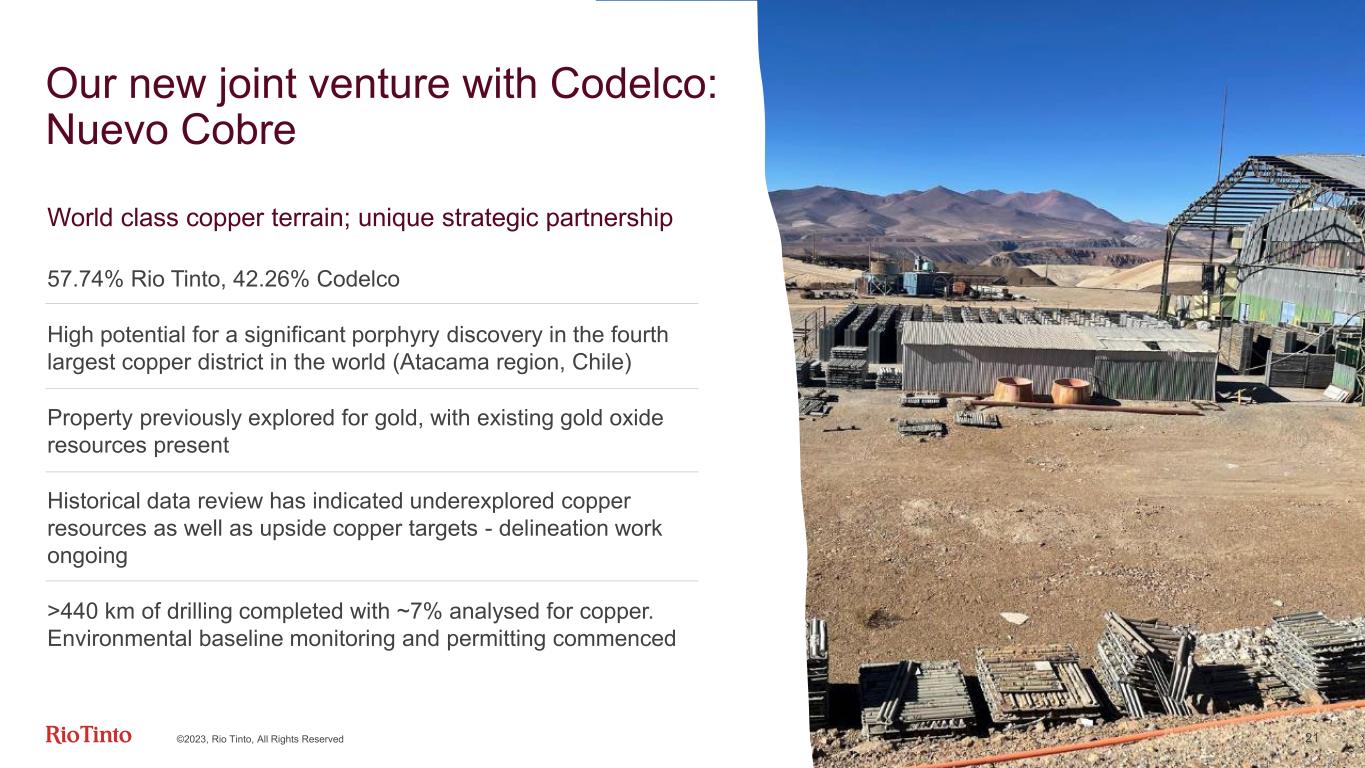
©2023, Rio Tinto, All Rights Reserved 21 Our new joint venture with Codelco: Nuevo Cobre World class copper terrain; unique strategic partnership 57.74% Rio Tinto, 42.26% Codelco High potential for a significant porphyry discovery in the fourth largest copper district in the world (Atacama region, Chile) Property previously explored for gold, with existing gold oxide resources present Historical data review has indicated underexplored copper resources as well as upside copper targets - delineation work ongoing >440 km of drilling completed with ~7% analysed for copper. Environmental baseline monitoring and permitting commenced
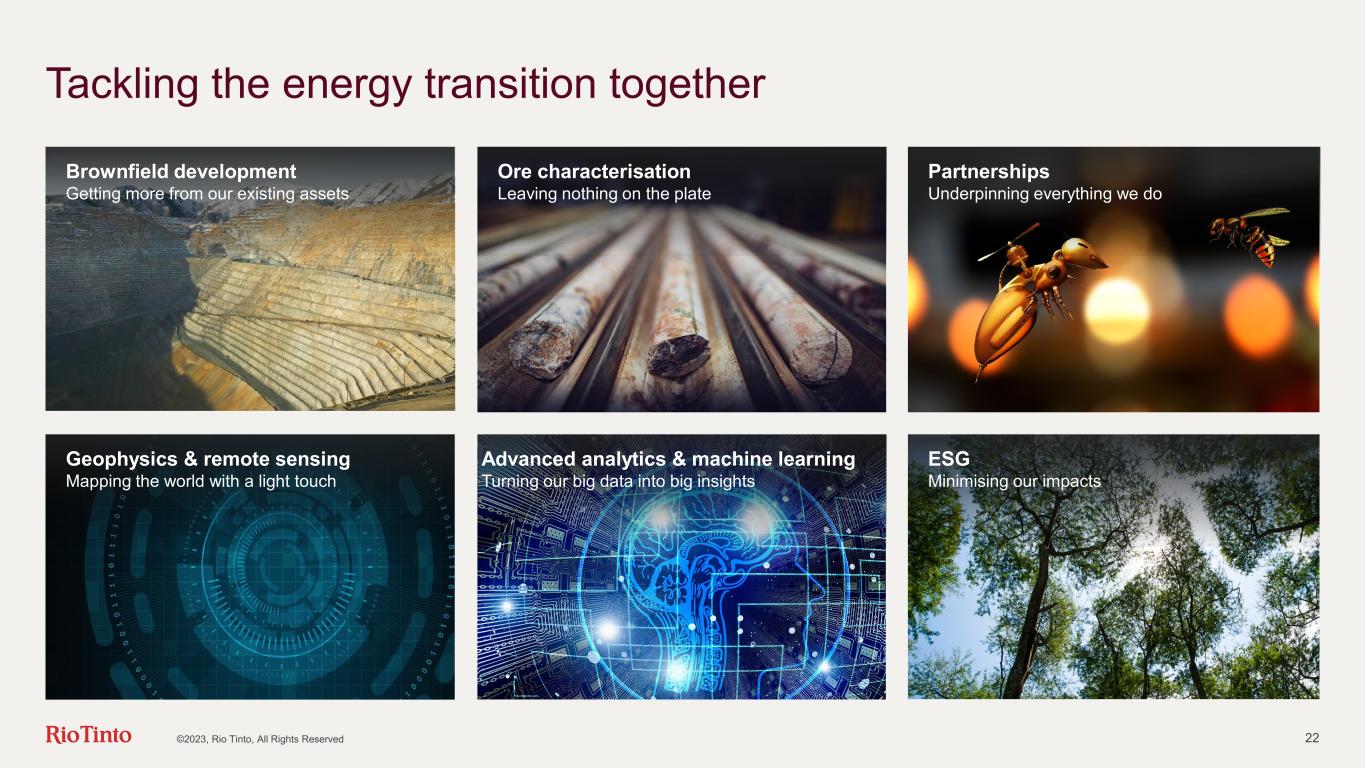
©2023, Rio Tinto, All Rights Reserved 22 Tackling the energy transition together Geophysics & remote sensing Mapping the world with a light touch Advanced analytics & machine learning Turning our big data into big insights ESG Minimising our impacts Brownfield development Getting more from our existing assets Ore characterisation Leaving nothing on the plate Partnerships Underpinning everything we do

©2023, Rio Tinto, All Rights Reserved 23 Strong network of technology partnerships

Productivity 27 projects ©2023, Rio Tinto, All Rights Reserved 24 Disciplined technology roadmap Maximise value from each ore body Equipment utilisation Automation Energy efficiency Health & Safety 10 projects ESG 20 projects Growth 39 projects Carbon 24 projects Reducing frontline exposure to hazards Managing health and wellbeing of our people Reducing water consumption Improving water treatment Dry tailings Dry processing Closure Discovering new orebodies Reducing capital intensity Creating new revenue streams Green steel and low carbon products Storage options Green processing Green energy Green fleet Excel in Development Best OperatorImpeccable ESG Social Licence

©2023, Rio Tinto, All Rights Reserved 25 2023 highlights to evolve into 2024 successes Innovation Advisory Committee Comprised of innovation and R&D experts from around the world Provides insights on ways we can accelerate our innovation portfolio and offers guidance on emerging and disruptive technologies Rio Tinto Centre for Future Materials Committing $150m to research over 10 years Tackle challenges faced by our industry in providing materials the world needs for the energy transition Imperial College London will lead the Centre in partnership with international academic institutions Investing in technology and start-ups This year we have invested nearly $40m. Both first time investments and other subsequent investments based on innovation successes Focus on investing in technology and start-ups to help solve critical business challenges Progressing the portfolio In collaboration with our partners, we are focused on progressing key projects, including: • ELYSISTM • NutonTM • Lumo Analytics • BlueSmeltingTM • Hydrogen calcination • Steel decarbonisation and BioIronTM Accelerating innovation by ‘bringing the outside world in’ Advancing key projects NutonTM technology pilot plant, Bundoora, AustraliaImperial College LondonInnovation Advisory Committee members
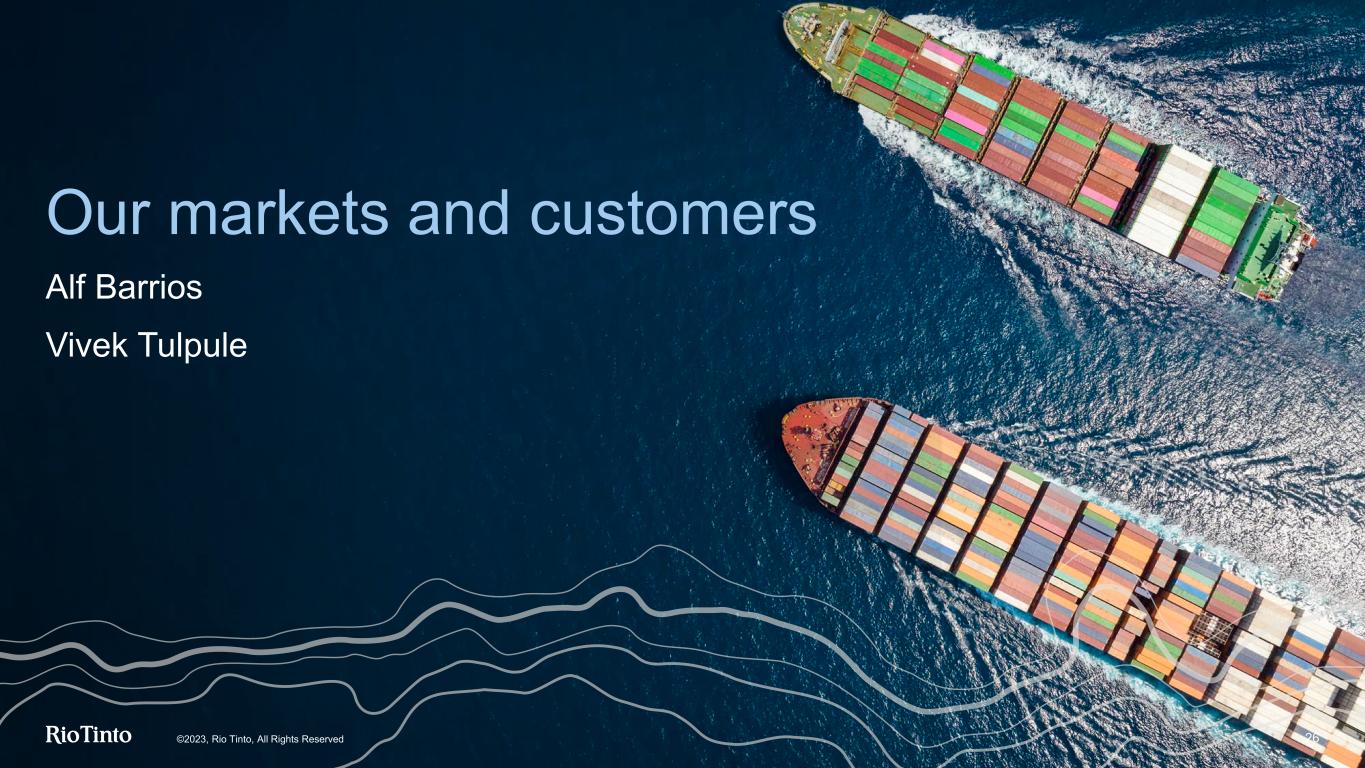
Our markets and customers Alf Barrios Vivek Tulpule ©2023, Rio Tinto, All Rights Reserved 26
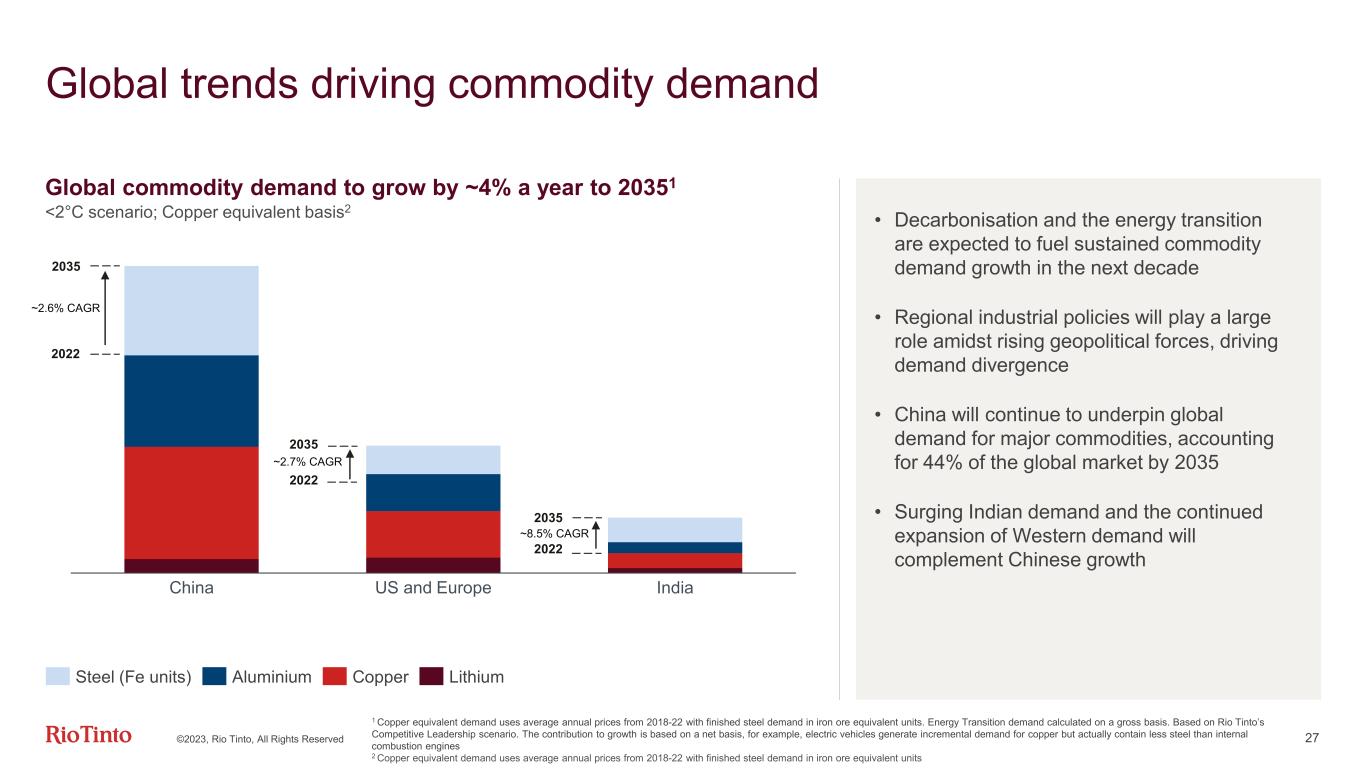
©2023, Rio Tinto, All Rights Reserved 27 Global trends driving commodity demand 1 Copper equivalent demand uses average annual prices from 2018-22 with finished steel demand in iron ore equivalent units. Energy Transition demand calculated on a gross basis. Based on Rio Tinto’s Competitive Leadership scenario. The contribution to growth is based on a net basis, for example, electric vehicles generate incremental demand for copper but actually contain less steel than internal combustion engines 2 Copper equivalent demand uses average annual prices from 2018-22 with finished steel demand in iron ore equivalent units Global commodity demand to grow by ~4% a year to 20351 <2°C scenario; Copper equivalent basis2 China US and Europe India Steel (Fe units) Aluminium Copper Lithium 2022 2035 2022 2035 2022 2035 ~8.5% CAGR ~2.7% CAGR ~2.6% CAGR • Decarbonisation and the energy transition are expected to fuel sustained commodity demand growth in the next decade • Regional industrial policies will play a large role amidst rising geopolitical forces, driving demand divergence • China will continue to underpin global demand for major commodities, accounting for 44% of the global market by 2035 • Surging Indian demand and the continued expansion of Western demand will complement Chinese growth
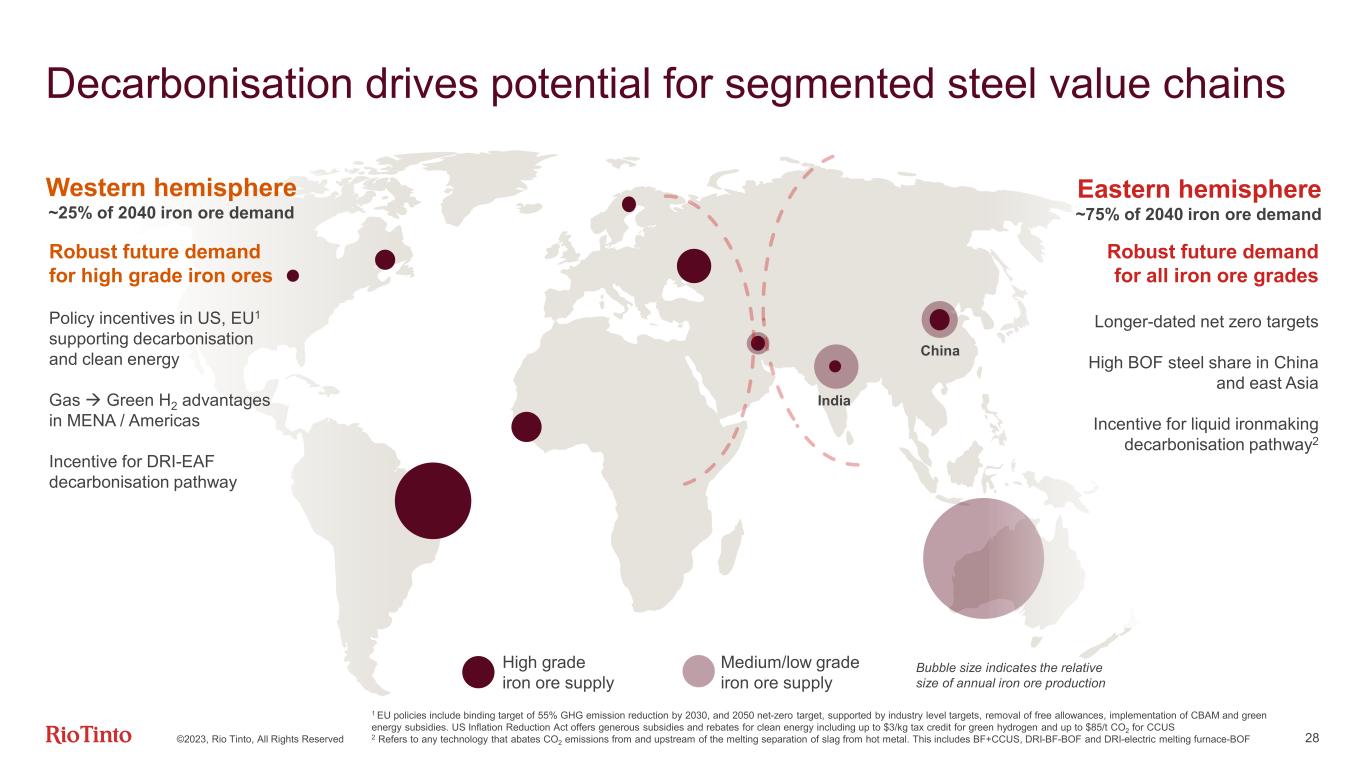
28 Decarbonisation drives potential for segmented steel value chains China India High grade iron ore supply Medium/low grade iron ore supply Western hemisphere ~25% of 2040 iron ore demand Robust future demand for high grade iron ores Policy incentives in US, EU1 supporting decarbonisation and clean energy Gas Green H2 advantages in MENA / Americas Incentive for DRI-EAF decarbonisation pathway Eastern hemisphere ~75% of 2040 iron ore demand Robust future demand for all iron ore grades Longer-dated net zero targets High BOF steel share in China and east Asia Incentive for liquid ironmaking decarbonisation pathway2 1 EU policies include binding target of 55% GHG emission reduction by 2030, and 2050 net-zero target, supported by industry level targets, removal of free allowances, implementation of CBAM and green energy subsidies. US Inflation Reduction Act offers generous subsidies and rebates for clean energy including up to $3/kg tax credit for green hydrogen and up to $85/t CO2 for CCUS 2 Refers to any technology that abates CO2 emissions from and upstream of the melting separation of slag from hot metal. This includes BF+CCUS, DRI-BF-BOF and DRI-electric melting furnace-BOF©2023, Rio Tinto, All Rights Reserved Bubble size indicates the relative size of annual iron ore production

©2023, Rio Tinto, All Rights Reserved 29 Low-impurity ores could realise significant premiums at $100/tCO2 Indicative operating cost structure per tonne of crude steel at $100/t CO2 penalty and consensus long-run iron ore price forecasts ($75/t on a 62% Fe equivalent basis, CFR China) 1. 90% iron and 10% home scrap (valued at cost) used in steelmaking. Scrap costs are included in iron and steel conversion 2. Cost for coal products are assumed to be between $150-$250/t 3. Assumes Scope 2 emissions factor of 0.5t CO2/MWh, electricity price of $60/MWh 4. $8/GJ as generic industry cost of natural gas is consistent with regional projections from International Energy Agency. Iron ore value-in-use premiums can go up to $30/t (65% Fe) or $70/t (67% Fe) respectively if natural gas is sourced from a low-cost gas hub 5. Based on green H2 @ $2/kg, and assumes low-cost power and low Scope 2 emissions factor for steel conversion • Reduction in CO2 penalties achieved when moving to DRI/EAF routes creates higher steel margins with high-grade iron ores • Natural gas DRI can partially abate ironmaking CO2 emissions • Value chain margins can reach ~$120/t steel under H2 reduction, equating to around $80/t for iron ore Iron ore value-in-use premium over 62% Fe Iron ore feedstock2 (fines) BF/BOF3 DRI/EAF (H2 DRI5) +$20-30+$20 DRI/EAF1 (gas DRI4) 62% Fe 65% Fe 65% Fe 67% Fe 67% Fe Value chain margin Conversion and fuel costs Carbon penalty Cost of Fe units +$60-70 Up to +$80

©2023, Rio Tinto, All Rights Reserved 30 Recycling creates broad benefits across aluminium supply chain 0 50 100 150 2010 2015 2020 2025 2030 Recycling growth to outpace primary… …to enhance supply chain resilience … and to reduce emissions <2°C scenario; global aluminium production (Mt) Europe + US + Japan semis production CO2 intensity of primary aluminium and scrap (tCO2/t Al) Domestic primary Domestic secondary Imports China North America Europe ROW Scrap 2035 13.3 10.8 3.0 2.1 0.5 China Primary Aluminium (global average) Europe Canada Scrap 17% 16% 39% 51% 44% 2022 33% 2035 Source: IAI; CRU
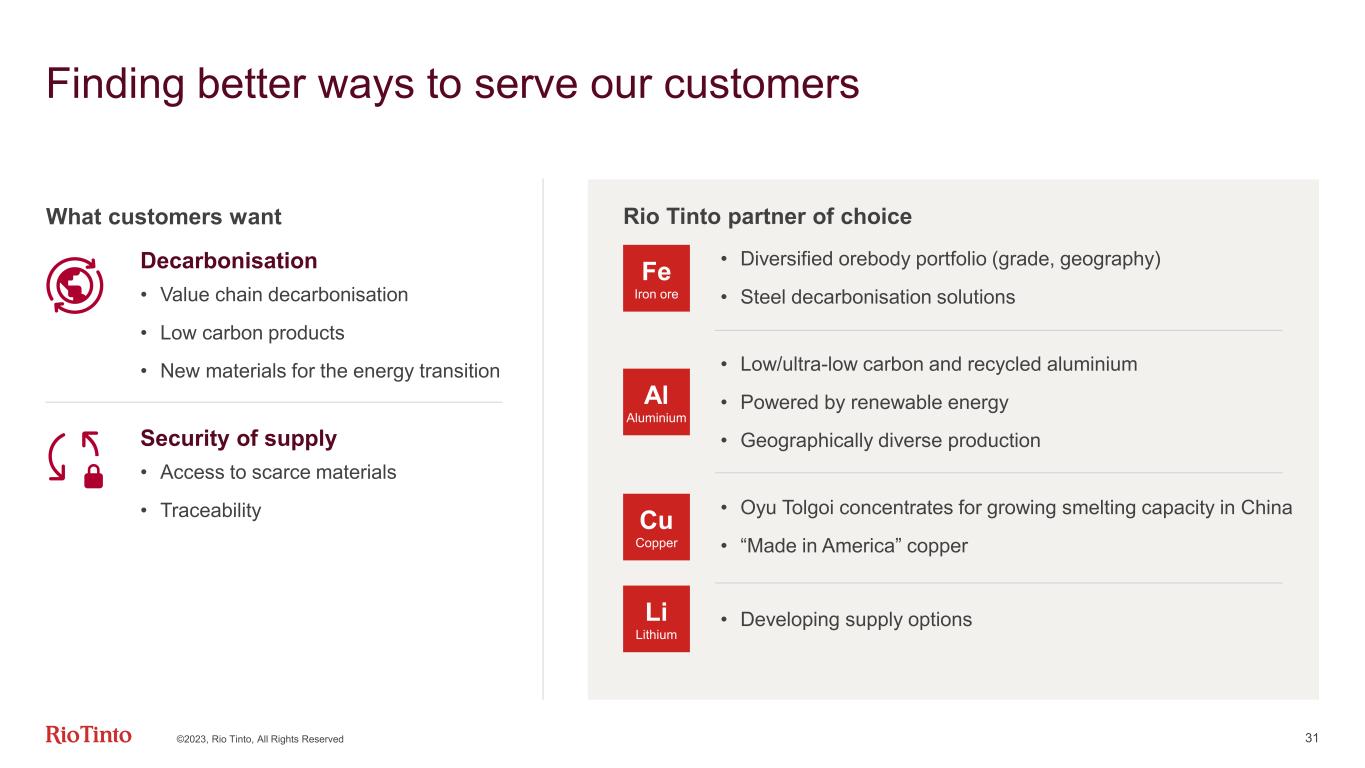
©2023, Rio Tinto, All Rights Reserved Finding better ways to serve our customers What customers want Rio Tinto partner of choice Decarbonisation • Value chain decarbonisation • Low carbon products • New materials for the energy transition Security of supply • Access to scarce materials • Traceability • Diversified orebody portfolio (grade, geography) • Steel decarbonisation solutions Fe Iron ore • Low/ultra-low carbon and recycled aluminium • Powered by renewable energy • Geographically diverse production Al Aluminium • Oyu Tolgoi concentrates for growing smelting capacity in China • “Made in America” copper Cu Copper • Developing supply optionsLi Lithium 31

©2023, Rio Tinto, All Rights Reserved Matalco – a step change in our customer offering RenewAl™ End customers are increasing the use of recycled aluminium with North American demand forecast to increase from 4.7 to 7.8 Mt from 2022 to 20321 Matalco JV creates a leadership position, increasing our North American aluminium portfolio by 45% and almost doubling our portfolio of value-added products Recycling complements our offering – low carbon primary aluminium, ELYSISTM and now recycling – with secure access to high-quality scrap And sets us up for growth in the expanding North American market 32 2016 2018 2021 2021 2023 1. CRU Aluminium Long Term Market Outlook, December 2022.

584 Mt CO2e 66% Iron and steel making 3% Alumina refining 2% Marine and logistics 4% Procurement 22% Aluminium smelting 3% Other products ©2023, Rio Tinto, All Rights Reserved Supporting customers and suppliers to decarbonise the value chain Our Scope 3 emissions 33 2020 2030 2040 2050 2060 Illustrative Scope 3 trajectory incorporating current customer and country pledges1 Potential Net Zero emissions pathway (based on NZSI and IAI scenarios) 1. Based on current product and customer mix 2. NZSI = Net Zero Steel Initiative. IAI = International Aluminium Institute We are helping our customers beat the current trajectory Our customers, and their governments, have real commitments to reduce their emissions (our Scope 3) – and we are partnering to help them achieve these We are also driving breakthroughs in the technologies that will be required to achieve aggressive Net Zero 2050 trajectories 1,2

Partnering with customers to decarbonise the steel value chain >10 years to commercial scale Future Pathways 3 Ongoing Existing Pathways ~1-10 years to commercial scale Emerging Pathways 1 2 Unlock new low-CO2 technologies for low-mid grade Pilbara ores Working with our customers to lower the CO2 intensity of the Blast Furnace Using our high-grade iron ores to accelerate the early proliferation of low CO2 technologies Pellets Shaft Furnace Low-Mid-Grade Lump Low-Mid-Grade Fines EAF Sh af t F ur na ce w ith M el te r Electric Melter BOF Fl ui d B ed w ith M el te r Fluid Bed Low-Mid-Grade Fines EAF Electric Melter BOF Microwave Furnace Low-Mid-Grade Fines EAF Electric MelterB io Iro nT M Briquette BOF
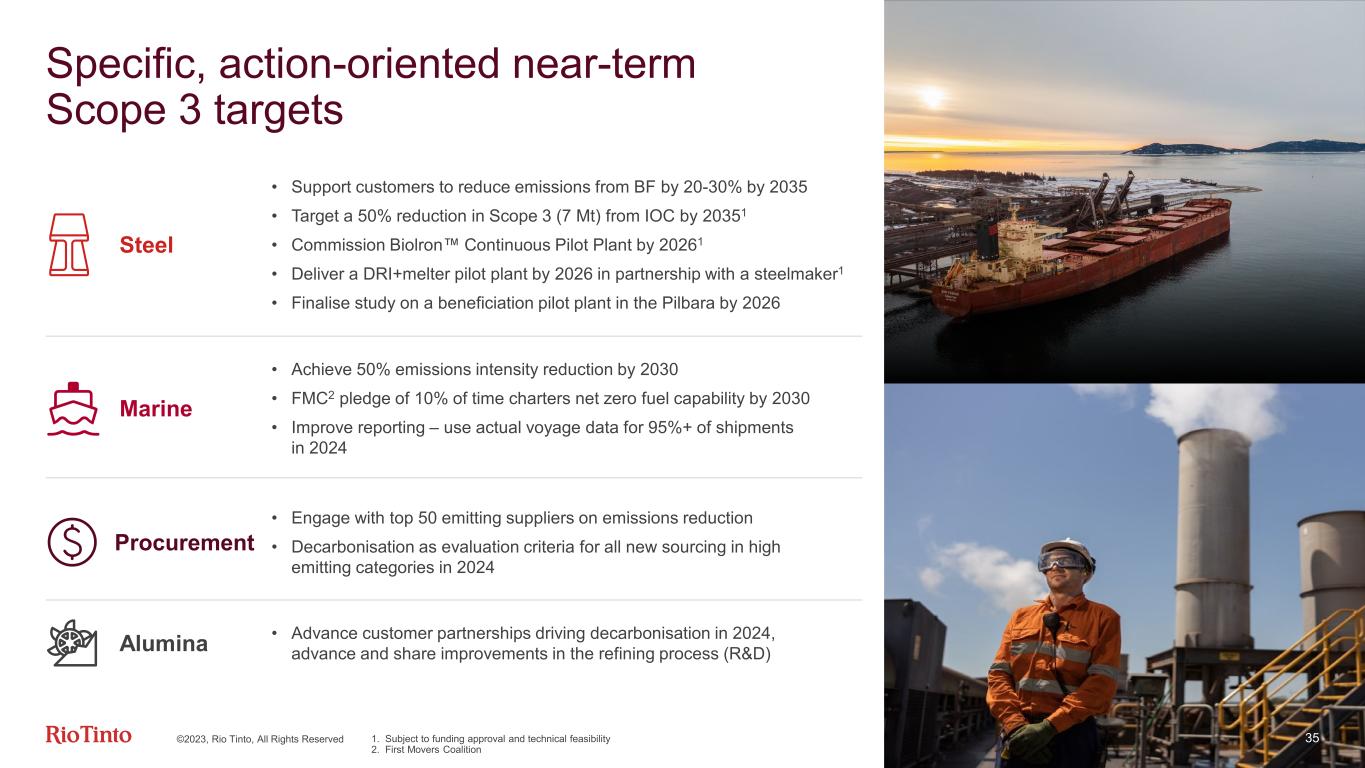
©2023, Rio Tinto, All Rights Reserved 35 Specific, action-oriented near-term Scope 3 targets • Support customers to reduce emissions from BF by 20-30% by 2035 • Target a 50% reduction in Scope 3 (7 Mt) from IOC by 20351 • Commission Biolron™ Continuous Pilot Plant by 20261 • Deliver a DRI+melter pilot plant by 2026 in partnership with a steelmaker1 • Finalise study on a beneficiation pilot plant in the Pilbara by 2026 • Engage with top 50 emitting suppliers on emissions reduction • Decarbonisation as evaluation criteria for all new sourcing in high emitting categories in 2024 • Achieve 50% emissions intensity reduction by 2030 • FMC2 pledge of 10% of time charters net zero fuel capability by 2030 • Improve reporting – use actual voyage data for 95%+ of shipments in 2024 • Advance customer partnerships driving decarbonisation in 2024, advance and share improvements in the refining process (R&D) 1. Subject to funding approval and technical feasibility 2. First Movers Coalition Steel Marine Procurement Alumina

©2023, Rio Tinto, All Rights Reserved BioIronTM – pioneering breakthrough technologies BioIronTM uses raw biomass instead of metallurgical coal and microwave energy to convert Pilbara iron ore to metallic iron and has the potential to support low CO2 steel making Bed of green briquettes (ore, biomass, flux) ready for testing Finished BioIronTM DRI productGreen briquettes converted to Direct Reduced Iron (DRI) 01. Highly productive with ores from the Pilbara, the world’s largest iron ore region 02. More than 95% reduction in CO2 emissions compared to pig iron produced in the Blast Furnace 03. Utilises biomass produced from agricultural by-products 04. Electricity consumption is ~65% lower than other green Hydrogen technologies 36

Panel 2: The mindset that's driving performance – Best Operator James Martin Kellie Parker Arnaud Soirat Simon Trott 37©2023, Rio Tinto, All Rights Reserved
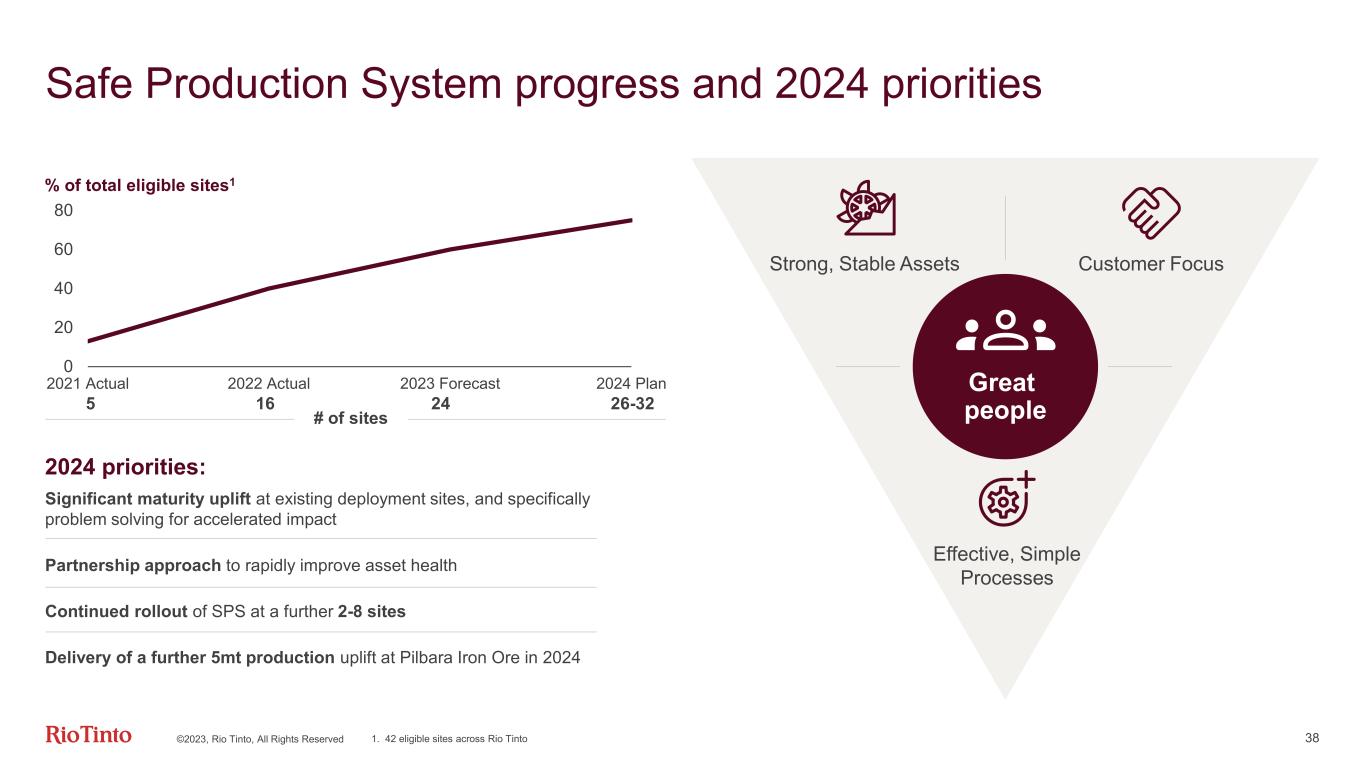
©2023, Rio Tinto, All Rights Reserved 38 Safe Production System progress and 2024 priorities 2024 priorities: Significant maturity uplift at existing deployment sites, and specifically problem solving for accelerated impact Partnership approach to rapidly improve asset health Continued rollout of SPS at a further 2-8 sites Delivery of a further 5mt production uplift at Pilbara Iron Ore in 2024 0 20 40 60 80 2021 Actual 2022 Actual 2023 Forecast 2024 Plan % of total eligible sites1 # of sites 5 16 24 26-32 1. 42 eligible sites across Rio Tinto Great people Strong, Stable Assets Customer Focus Effective, Simple Processes

©2023, Rio Tinto, All Rights Reserved 39 SPS is a global system improving safety, people and profit outcomes Grande Baie (Aluminium) 19% Kennecott (Copper) 8% Casting operating time (excluding shutdowns) People Survey employee satisfaction IOC (Minerals) 20% Hope Downs (Iron Ore) 42% All injury frequency rate (AIFR) Processing operating time variability Year-on-year change
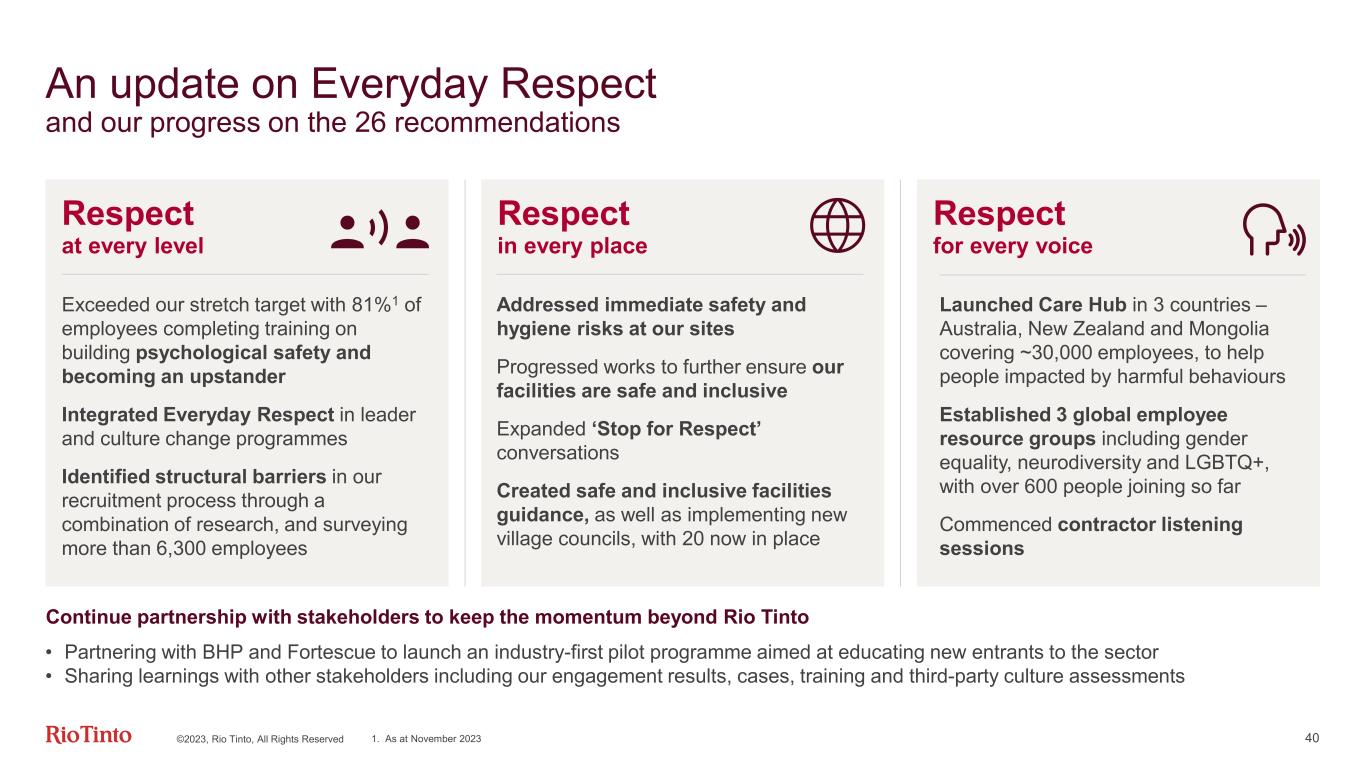
©2023, Rio Tinto, All Rights Reserved 40 An update on Everyday Respect and our progress on the 26 recommendations Respect at every level Respect in every place Respect for every voice Exceeded our stretch target with 81%1 of employees completing training on building psychological safety and becoming an upstander Integrated Everyday Respect in leader and culture change programmes Identified structural barriers in our recruitment process through a combination of research, and surveying more than 6,300 employees Launched Care Hub in 3 countries – Australia, New Zealand and Mongolia covering ~30,000 employees, to help people impacted by harmful behaviours Established 3 global employee resource groups including gender equality, neurodiversity and LGBTQ+, with over 600 people joining so far Commenced contractor listening sessions Addressed immediate safety and hygiene risks at our sites Progressed works to further ensure our facilities are safe and inclusive Expanded ‘Stop for Respect’ conversations Created safe and inclusive facilities guidance, as well as implementing new village councils, with 20 now in place Continue partnership with stakeholders to keep the momentum beyond Rio Tinto • Partnering with BHP and Fortescue to launch an industry-first pilot programme aimed at educating new entrants to the sector • Sharing learnings with other stakeholders including our engagement results, cases, training and third-party culture assessments 1. As at November 2023

Everyday Respect – looking ahead Discovery and reflection Planning and Co-design Implementation Review • Time to reflect and understand the findings and recommendations of the Everyday Respect report • Co-design actions to ensure we implement the right solutions, that have real impact and take into account local experiences and context • Implement meaningful actions that will create a safer and more respectful and inclusive workplace • 8-month study • 100+ group listening sessions • 85 confidential individual listening sessions • 140 individual written submissions • 10,000+ survey respondents Discovery • In line with the recommendations of the Everyday Respect report, preparations are also underway for our independent progress review in 2024 2024 Review • Committed to the progress review, with release of the outcomes likely in Q4 • We are again using independent expert Elizabeth Broderick • We continue to commit to transparency and will share the progress report

Safety share - culture Molly Singline ©2023, Rio Tinto, All Rights Reserved 42

Break ©2023, Rio Tinto, All Rights Reserved 43
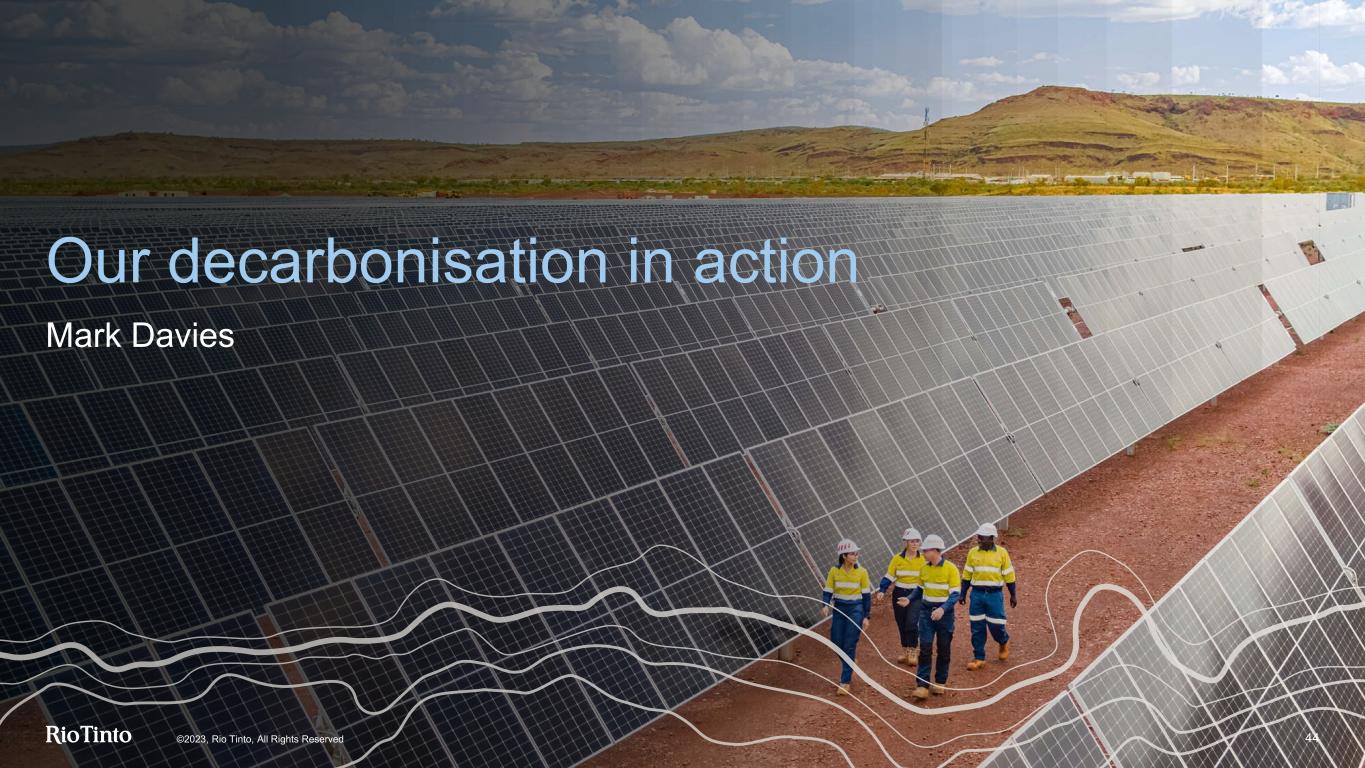
Our decarbonisation in action Mark Davies ©2023, Rio Tinto, All Rights Reserved 44

©2023, Rio Tinto, All Rights Reserved 45 Our project commitments are taking hold Commitments to abatement projects2 tCO2e equity basis Marginal Abatement Cost3 $/t CO2e 19< 0< 0 500 1,000 1,500 2,000 2021 2022 2023 26% 16% 14% 7% 17% 19% 1% PacOps Electricity1 Other Electricity Diesel Minerals Process Heat Alumina Process Heat Aluminium Anodes Land Management 2022 emissions % by source 2023 outcomes October 2021 Increased climate targets implemented 32.8Mt 1. Total PacOps emissions represent 50% of group emissions, largely allocated to PacOps electricity (26%), alumina process heat (15%) and anodes (6%) 2. Represents the abatement from in-year project commitments. There may be a lag to realised abatement given execution schedules or the nature of contracts entered into 3. Calculated on weighted average basis We have momentum in the portfolio • Converting our targets into actions, with an expected increase in activity in 2024 We have evolved our programme-based approach • Appointed Chief Decarbonisation Officer • Strengthened investment approach 2023 commitments • Renewable energy in Australia and Africa • Biofuels including 100% use at Boron and Kennecott • Piloting low-carbon heat and use of hydrogen in processing emissions
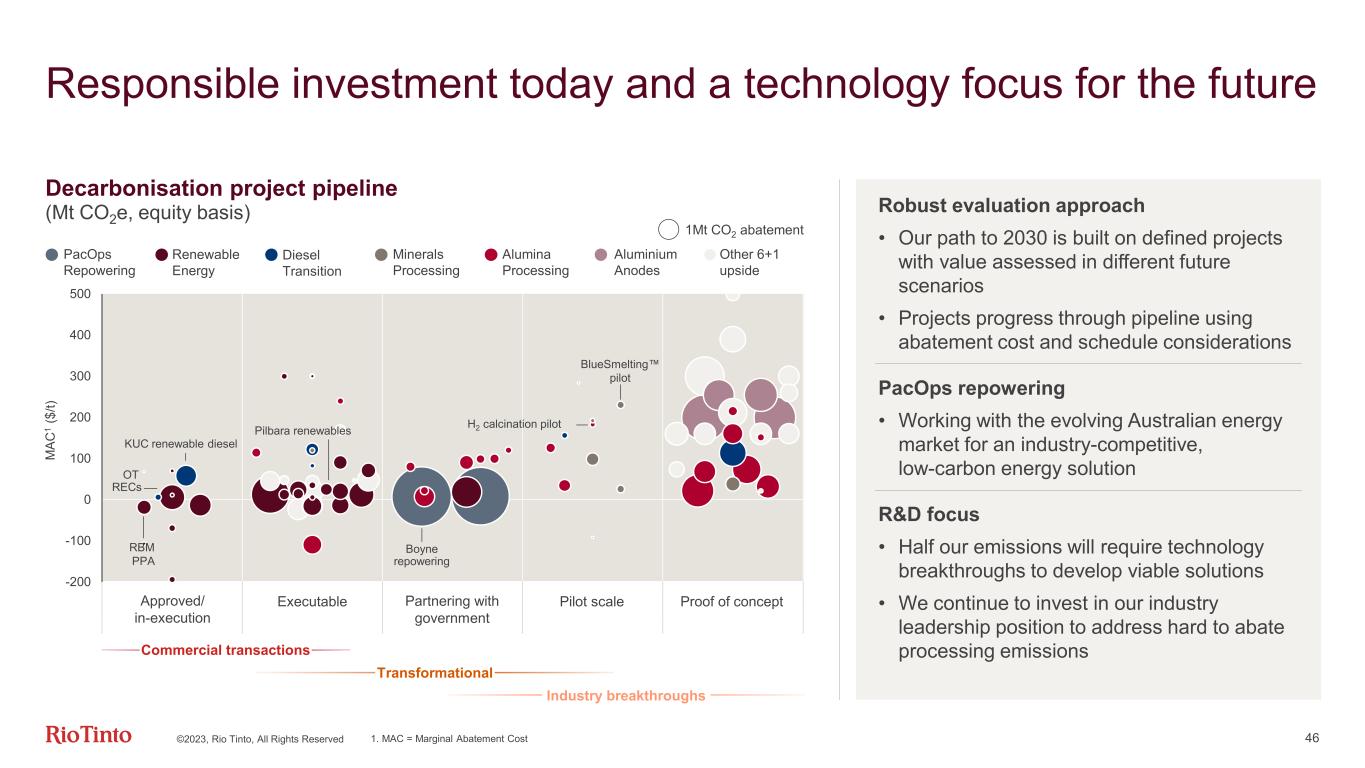
©2023, Rio Tinto, All Rights Reserved 46 Responsible investment today and a technology focus for the future Decarbonisation project pipeline (Mt CO2e, equity basis) Approved/ in-execution Executable Pilot scalePartnering with government Proof of concept -200 -100 0 100 200 300 400 500 M AC 1 ($ /t) RBM PPA BlueSmelting™ pilot OT RECs 1Mt CO2 abatement Boyne repowering Commercial transactions Transformational Industry breakthroughs Pilbara renewables H2 calcination pilot Renewable Energy Diesel Transition Minerals Processing Alumina Processing PacOps Repowering Aluminium Anodes Other 6+1 upside KUC renewable diesel Robust evaluation approach • Our path to 2030 is built on defined projects with value assessed in different future scenarios • Projects progress through pipeline using abatement cost and schedule considerations PacOps repowering • Working with the evolving Australian energy market for an industry-competitive, low-carbon energy solution R&D focus • Half our emissions will require technology breakthroughs to develop viable solutions • We continue to invest in our industry leadership position to address hard to abate processing emissions 1. MAC = Marginal Abatement Cost

©2023, Rio Tinto, All Rights Reserved 47 2023 pipeline progress RTIT BlueSmelting™ demonstration plantYarwun hydrogen calcination ELYSIS™ carbon-free aluminium anodes Transformational Repowering Pacific Operations • Low-carbon energy solutions progressing with key stakeholders Reducing baseload energy requirements • Piloting double digestion at QAL refinery Renewable energy • Committed renewable energy and certificates in Australia, South Africa and Mongolia • Yindjibarndi Energy Corporation partnership Drop-in biofuels • Boron and Kennecott replace its entire fossil diesel consumption with renewable diesel Commercial transactions Industry breakthroughs Electric fleet development and trials • Pilbara battery-electric haul truck pilots

©2023, Rio Tinto, All Rights Reserved 48 Pathway to 2030 target under our decarbonisation programmes 34.5 40 2018 baseline Net reduction PacOps Electricity 26% Other Electricity 16% Min. Proc. 7% Alumina Process Heat 17% Aluminium Anodes 19% 2022 Actuals Alumina Proc. 15% 2030 target (50%) 2025 target (15%) Forecast commitments under construction at 2030 2030 Aluminium Anodes 36% Min. Proc. 12% Diesel 24% Other Elec 11% Organic growthOther required2 Diesel 14% PacOps repowering 2024-2030 pipeline 32.8 2.3 2022-2023 commitments under construction/ development -50% Final schedule dependent on competitive solution Mt CO2e equity basis1 1. Rebased emissions due to scope 2 methodology changes. Data represents ‘gross’ Scope 1&2 emissions and direct abatement projects 2. ‘Other required’ will flex over time based on abatement project delivery, growth, closures and asset changes 17.3
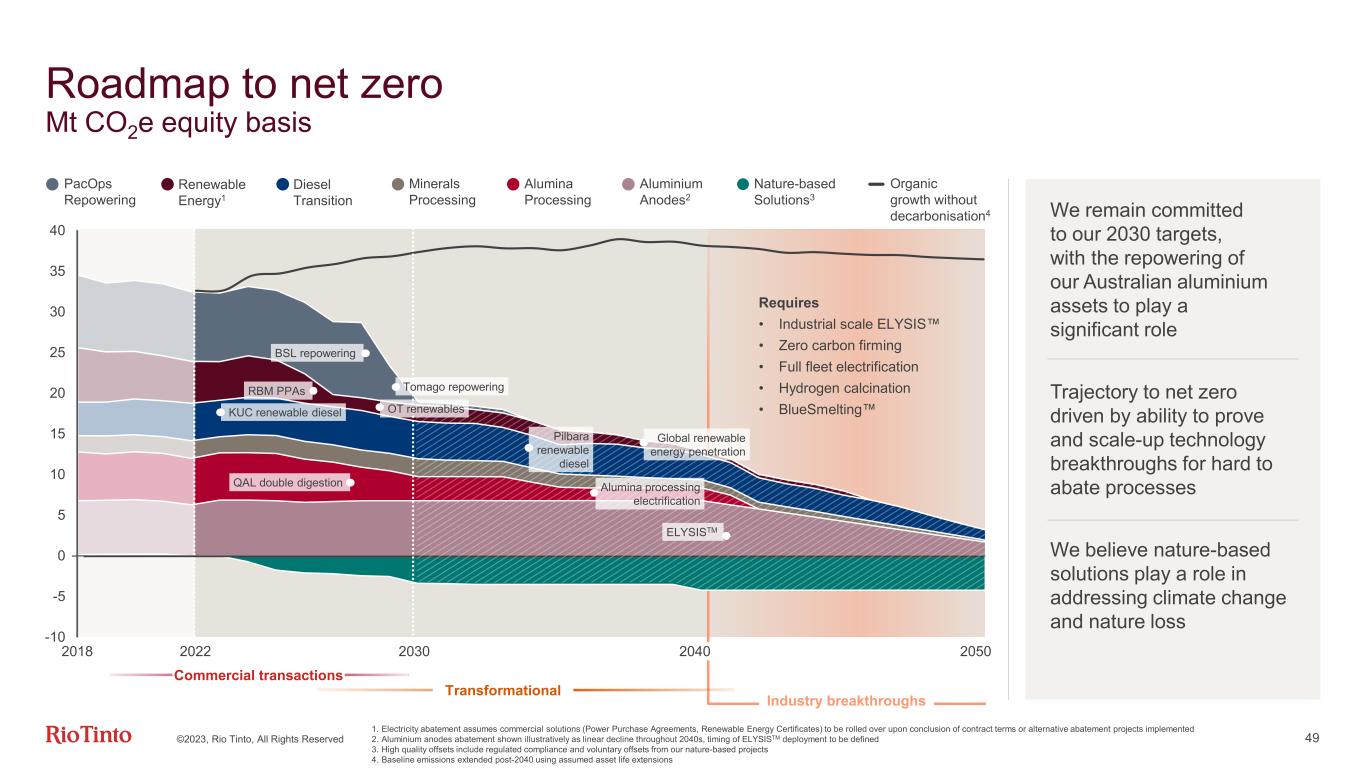
©2023, Rio Tinto, All Rights Reserved 49 Roadmap to net zero Mt CO2e equity basis 1. Electricity abatement assumes commercial solutions (Power Purchase Agreements, Renewable Energy Certificates) to be rolled over upon conclusion of contract terms or alternative abatement projects implemented 2. Aluminium anodes abatement shown illustratively as linear decline throughout 2040s, timing of ELYSISTM deployment to be defined 3. High quality offsets include regulated compliance and voluntary offsets from our nature-based projects 4. Baseline emissions extended post-2040 using assumed asset life extensions Requires • Industrial scale ELYSIS™ • Zero carbon firming • Full fleet electrification • Hydrogen calcination • BlueSmelting™ -10 -5 0 5 10 15 20 25 30 35 40 2018 2030 2040 20502022 Renewable Energy1 Diesel Transition Minerals Processing Alumina Processing PacOps Repowering Commercial transactions Transformational KUC renewable diesel RBM PPAs QAL double digestion BSL repowering Industry breakthroughs Aluminium Anodes2 Nature-based Solutions3 Organic growth without decarbonisation4 We remain committed to our 2030 targets, with the repowering of our Australian aluminium assets to play a significant role Trajectory to net zero driven by ability to prove and scale-up technology breakthroughs for hard to abate processes We believe nature-based solutions play a role in addressing climate change and nature loss Pilbara renewable diesel Alumina processing electrification Global renewable energy penetration Tomago repowering OT renewables ELYSISTM
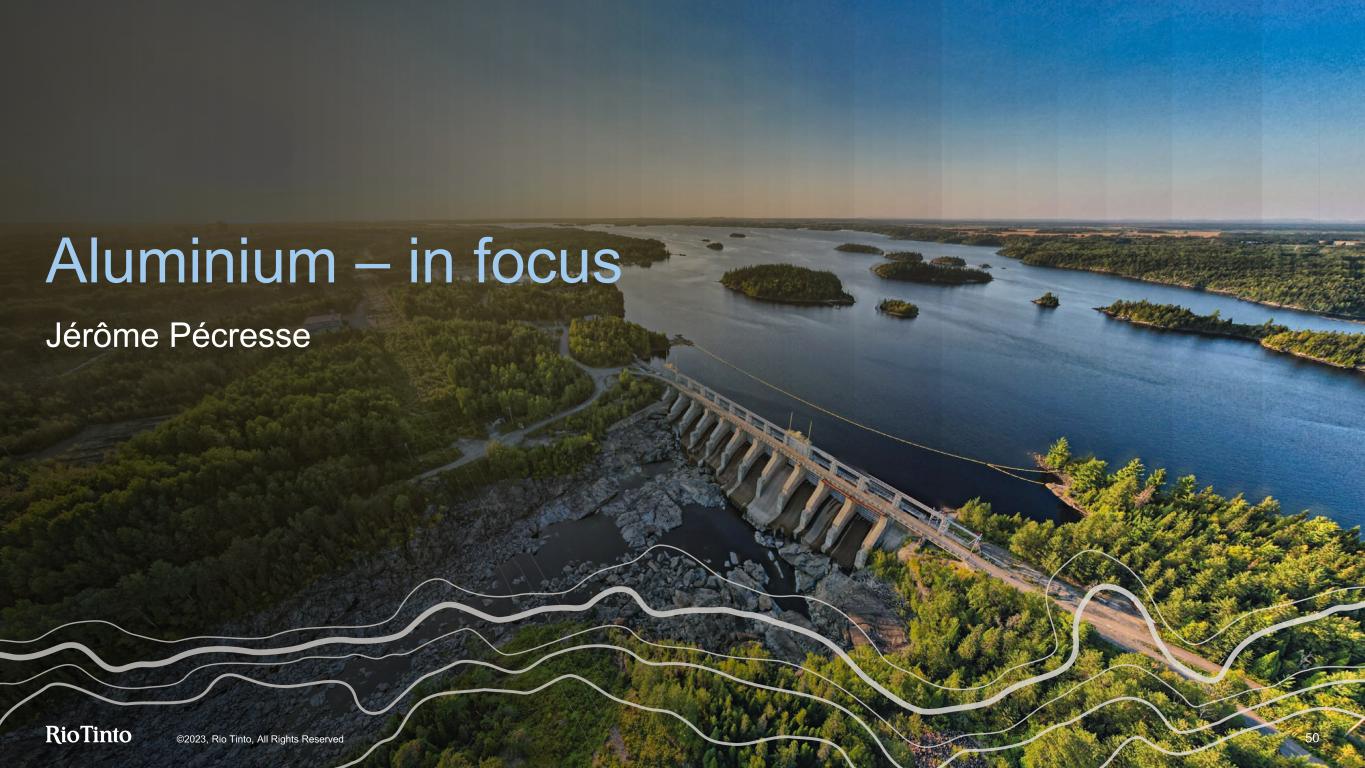
Aluminium – in focus Jérôme Pécresse 50©2023, Rio Tinto, All Rights Reserved

©2023, Rio Tinto, All Rights Reserved We are the world’s leading low-carbon aluminium producer, with options to grow 1. Incorporates non-managed joint ventures | 2. Seven facilities are Matalco joint venture assets Best positioned for an industry in transition 4 Bauxite Mines1 4 Alumina Refineries1 14 Aluminium Smelters1 8 Recycling Centres2 7 Hydropower Plants 3 R&D Centres and ELYSIS JV Critical metal to enable the energy transition Western re-industrialisation and industrial policies Consumer demand for green products Increasing aluminium scrap supply Cost of firmed green energy (hydro advantage) China 45Mt capacity cap 51
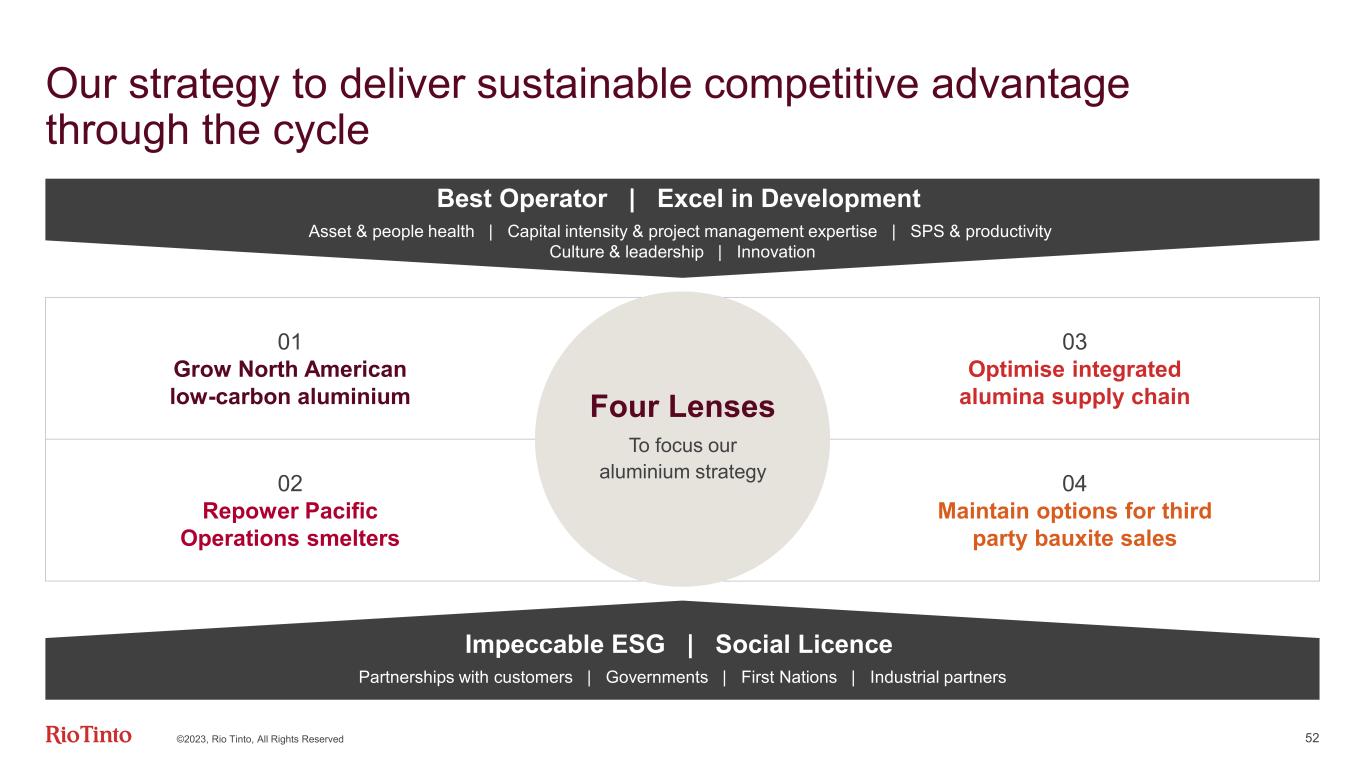
©2023, Rio Tinto, All Rights Reserved 52 Our strategy to deliver sustainable competitive advantage through the cycle 01 Grow North American low-carbon aluminium 03 Optimise integrated alumina supply chain 02 Repower Pacific Operations smelters 04 Maintain options for third party bauxite sales Four Lenses To focus our aluminium strategy Impeccable ESG | Social Licence Partnerships with customers | Governments | First Nations | Industrial partners Best Operator | Excel in Development Asset & people health | Capital intensity & project management expertise | SPS & productivity Culture & leadership | Innovation
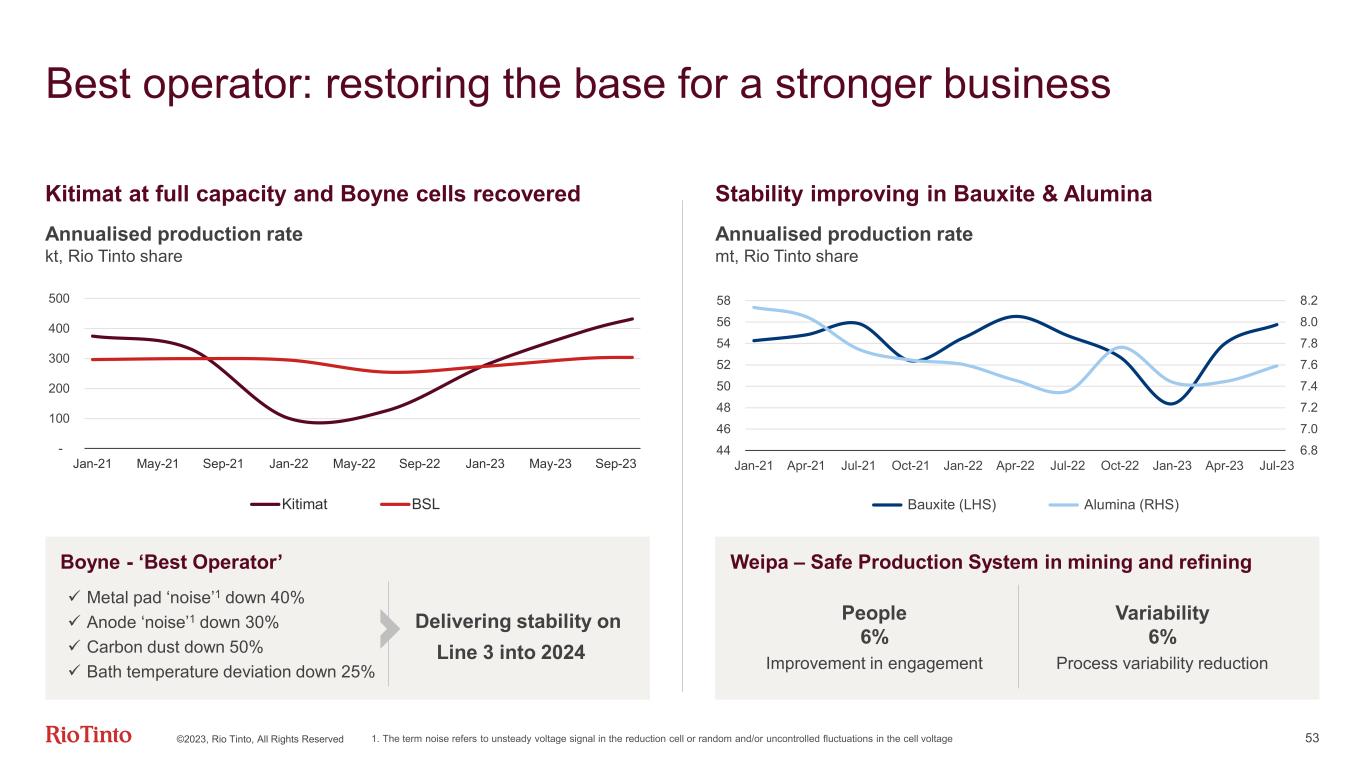
©2023, Rio Tinto, All Rights Reserved 53 Best operator: restoring the base for a stronger business Kitimat at full capacity and Boyne cells recovered Annualised production rate kt, Rio Tinto share - 100 200 300 400 500 Jan-21 May-21 Sep-21 Jan-22 May-22 Sep-22 Jan-23 May-23 Sep-23 Kitimat BSL Boyne - ‘Best Operator’ Weipa – Safe Production System in mining and refining Stability improving in Bauxite & Alumina Annualised production rate mt, Rio Tinto share Best Operator 6.8 7.0 7.2 7.4 7.6 7.8 8.0 8.2 44 46 48 50 52 54 56 58 Jan-21 Apr-21 Jul-21 Oct-21 Jan-22 Apr-22 Jul-22 Oct-22 Jan-23 Apr-23 Jul-23 Bauxite (LHS) Alumina (RHS) Metal pad ‘noise’1 down 40% Anode ‘noise’1 down 30% Carbon dust down 50% Bath temperature deviation down 25% Delivering stability on Line 3 into 2024 People 6% Improvement in engagement Variability 6% Process variability reduction 1. The term noise refers to unsteady voltage signal in the reduction cell or random and/or uncontrolled fluctuations in the cell voltage
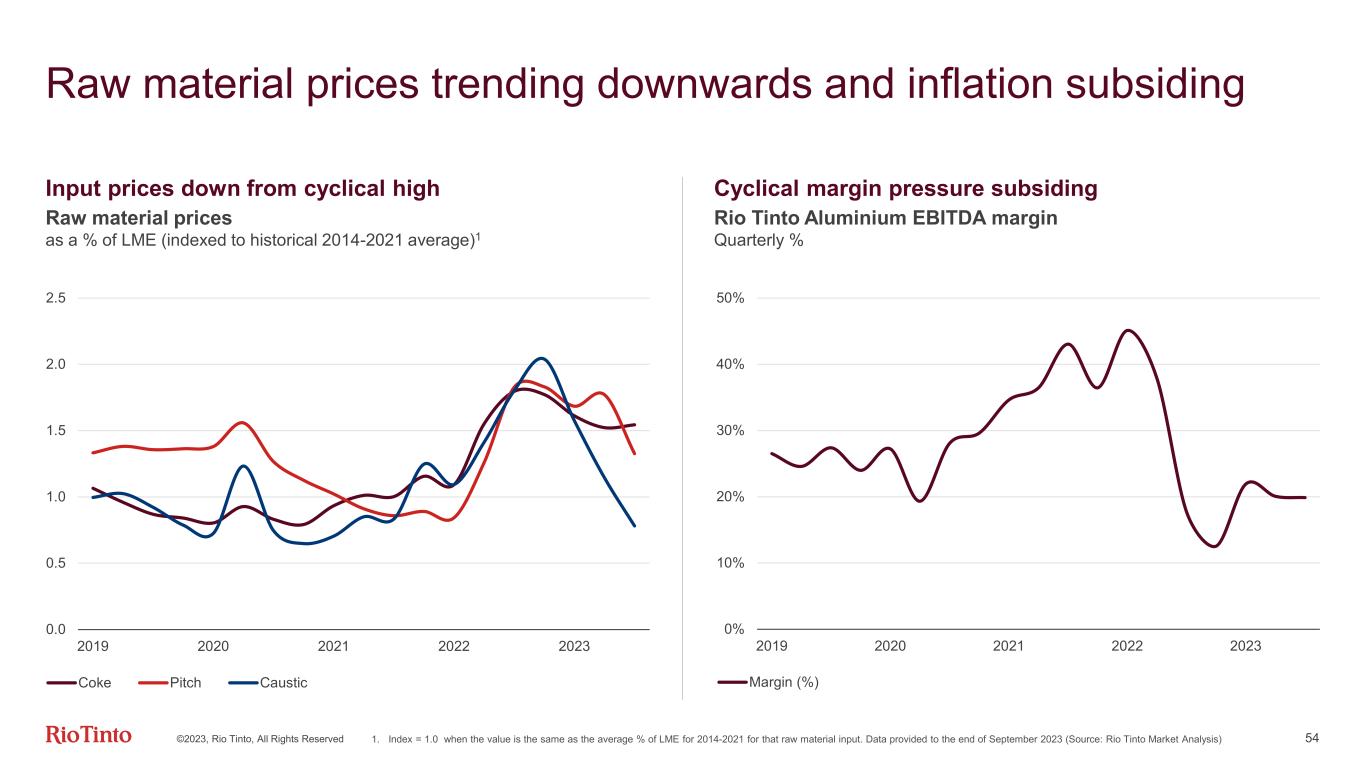
©2023, Rio Tinto, All Rights Reserved 54 Raw material prices trending downwards and inflation subsiding Raw material prices as a % of LME (indexed to historical 2014-2021 average)1 Rio Tinto Aluminium EBITDA margin Quarterly % 0.0 0.5 1.0 1.5 2.0 2.5 2019 2020 2021 2022 2023 Coke Pitch Caustic 0% 10% 20% 30% 40% 50% 2019 2020 2021 2022 2023 Margin (%) Input prices down from cyclical high Cyclical margin pressure subsiding 1. Index = 1.0 when the value is the same as the average % of LME for 2014-2021 for that raw material input. Data provided to the end of September 2023 (Source: Rio Tinto Market Analysis)
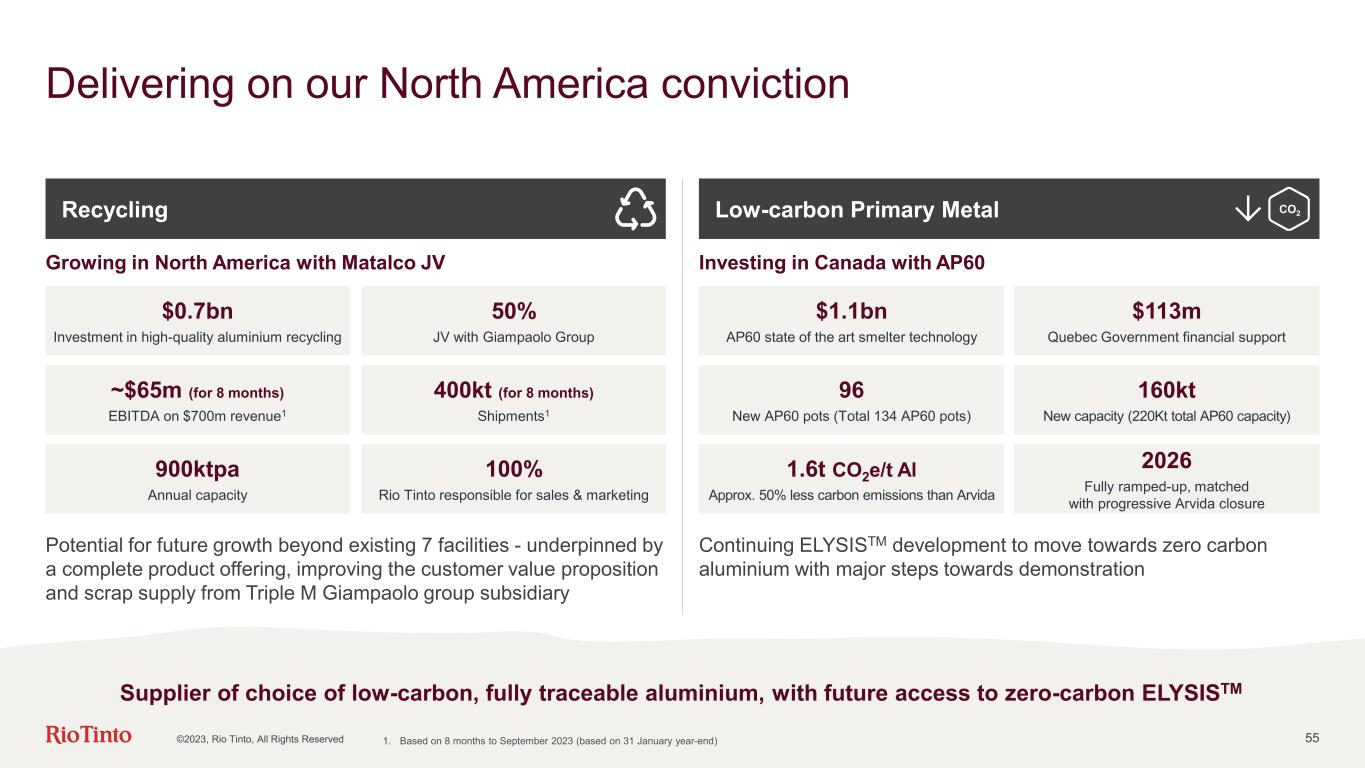
©2023, Rio Tinto, All Rights Reserved 55 Delivering on our North America conviction Supplier of choice of low-carbon, fully traceable aluminium, with future access to zero-carbon ELYSISTM Potential for future growth beyond existing 7 facilities - underpinned by a complete product offering, improving the customer value proposition and scrap supply from Triple M Giampaolo group subsidiary Continuing ELYSISTM development to move towards zero carbon aluminium with major steps towards demonstration Growing in North America with Matalco JV Investing in Canada with AP60 $0.7bn Investment in high-quality aluminium recycling 900ktpa Annual capacity 400kt (for 8 months) Shipments1 ~$65m (for 8 months) EBITDA on $700m revenue1 100% Rio Tinto responsible for sales & marketing 50% JV with Giampaolo Group $1.1bn AP60 state of the art smelter technology 2026 Fully ramped-up, matched with progressive Arvida closure 1.6t CO2e/t Al Approx. 50% less carbon emissions than Arvida 96 New AP60 pots (Total 134 AP60 pots) 160kt New capacity (220Kt total AP60 capacity) $113m Quebec Government financial support Recycling Low-carbon Primary Metal CO2 1. Based on 8 months to September 2023 (based on 31 January year-end)

©2023, Rio Tinto, All Rights Reserved 56 Partnering to capture the energy transition opportunity Rio Tinto Aluminium Circular Zero carbon Responsible Traceable Local / secure Customers • Prysmian – supply energy transition material • OEMs – partnerships for low emission vehicles Industrial partners • Matalco – new recycling JV • ARENA & Sumitomo – hydrogen calcination pilot at Yarwun Government • Governments of Australia and Canada – exploring opportunities for clean energy • Governments of Canada & Quebec – collaboration on AP60 and ELYSISTM First Nations • Kuessilueu (“wind is turning”) agreement; Saguenay-Lac- Saint-Jean region • Continuous engagements

Excel in development Best operator Impeccable ESG Care Courage Curiosity ©2023, Rio Tinto, All Rights Reserved 57 Our Aluminium business Improving our margins with Kitimat and Boyne recovery Setting Matalco JV up for success Progress AP60 expansion and ELYSISTM development

Copper - in focus Bold Baatar ©2023, Rio Tinto, All Rights Reserved 58
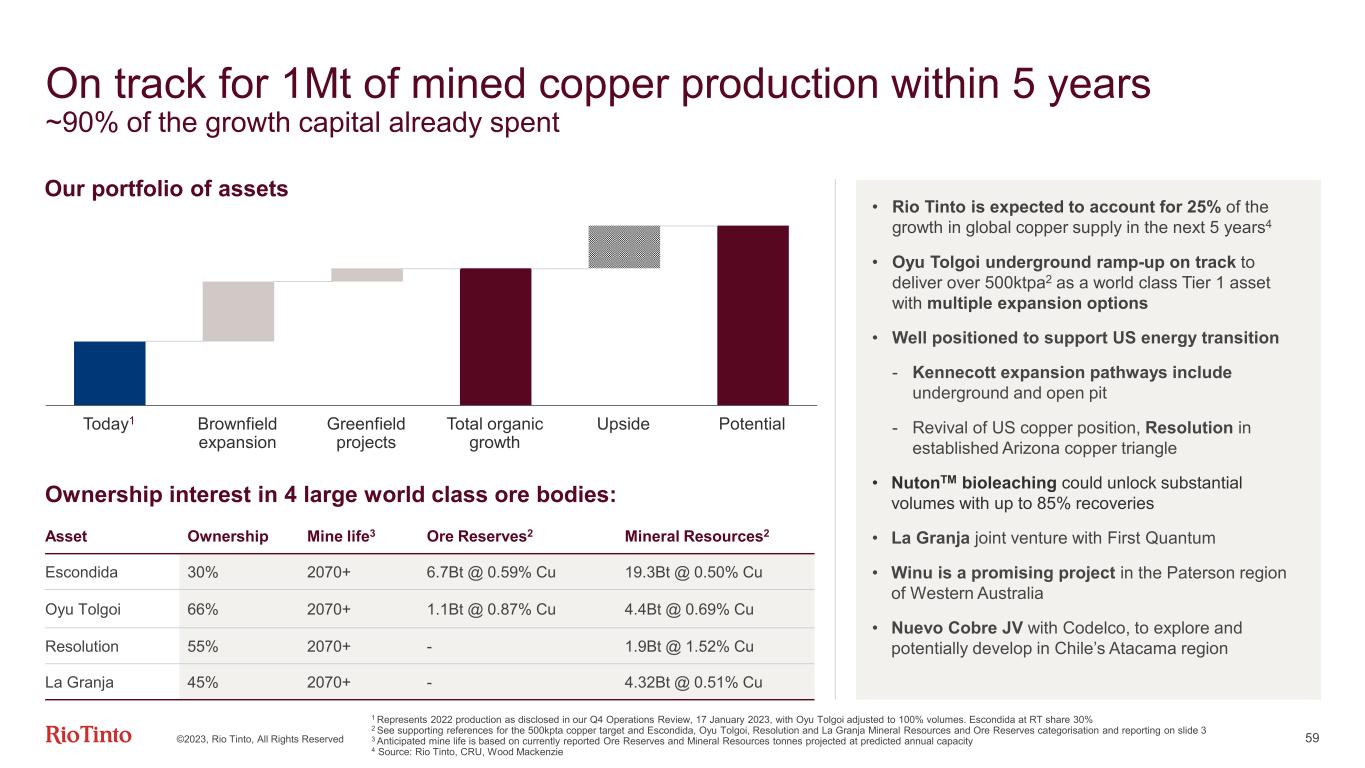
©2023, Rio Tinto, All Rights Reserved 59 On track for 1Mt of mined copper production within 5 years ~90% of the growth capital already spent • Rio Tinto is expected to account for 25% of the growth in global copper supply in the next 5 years4 • Oyu Tolgoi underground ramp-up on track to deliver over 500ktpa2 as a world class Tier 1 asset with multiple expansion options • Well positioned to support US energy transition - Kennecott expansion pathways include underground and open pit - Revival of US copper position, Resolution in established Arizona copper triangle • NutonTM bioleaching could unlock substantial volumes with up to 85% recoveries • La Granja joint venture with First Quantum • Winu is a promising project in the Paterson region of Western Australia • Nuevo Cobre JV with Codelco, to explore and potentially develop in Chile’s Atacama region Ownership interest in 4 large world class ore bodies: Our portfolio of assets Asset Ownership Mine life3 Ore Reserves2 Mineral Resources2 Escondida 30% 2070+ 6.7Bt @ 0.59% Cu 19.3Bt @ 0.50% Cu Oyu Tolgoi 66% 2070+ 1.1Bt @ 0.87% Cu 4.4Bt @ 0.69% Cu Resolution 55% 2070+ - 1.9Bt @ 1.52% Cu La Granja 45% 2070+ - 4.32Bt @ 0.51% Cu 1 Represents 2022 production as disclosed in our Q4 Operations Review, 17 January 2023, with Oyu Tolgoi adjusted to 100% volumes. Escondida at RT share 30% 2 See supporting references for the 500kpta copper target and Escondida, Oyu Tolgoi, Resolution and La Granja Mineral Resources and Ore Reserves categorisation and reporting on slide 3 3 Anticipated mine life is based on currently reported Ore Reserves and Mineral Resources tonnes projected at predicted annual capacity 4 Source: Rio Tinto, CRU, Wood Mackenzie Today1 PotentialBrownfield expansion Total organic growth UpsideGreenfield projects

©2023, Rio Tinto, All Rights Reserved 60 Continued investment at our high-quality operations $1bn of investment committed Smelter rebuild completed, expect to be fully ramped up by Q1 2024 Improved stability and returns following investment in the smelter rebuild 83 drawbells blasted1, ahead of plan Underground project 92% completed with 95% of the capital committed2 Expected to average 500ktpa3 of copper production from 2028 to 2036 Significant investment over the next 10 years to maintain production Growth options - concentrator and leaching currently under evaluation 1 As at 28 November 2023. 2 As at 31 October 2023 3 See supporting references for the 500kpta copper target and Oyu Tolgoi Resources and Ore Reserves categorisation and reporting on slide 3 Kennecott EscondidaOyu Tolgoi

©2023, Rio Tinto, All Rights Reserved 61 Oyu Tolgoi expected to move to first quartile of the 2030 cost curve Copper in concentrates (LHS)/ head grade (RHS)1 1 See supporting references for the 2023-2027 and 2028-2036 production profiles on slide 3 2 Source: Wood Mackenzie Ltd. Dataset 2023 Q1, Rio Tinto 3 Oyu Tolgoi cost quartile position on 2023 Copper Equivalent Cost Curve 0 0.25 0.5 0.75 1 1.25 1.5 0 100 200 300 400 500 Production of Copper in concentrates Copper grade % -100 0 100 200 300 400 500 600 0 10,000 20,000 30,000 40,000 Cumulative production (Mlb Cu) Oyu Tolgoi (2023)3 2030 Copper equivalent cost curve2 Copper equivalent unit cost including sustaining capex (c/lb) Oyu Tolgoi (2030)
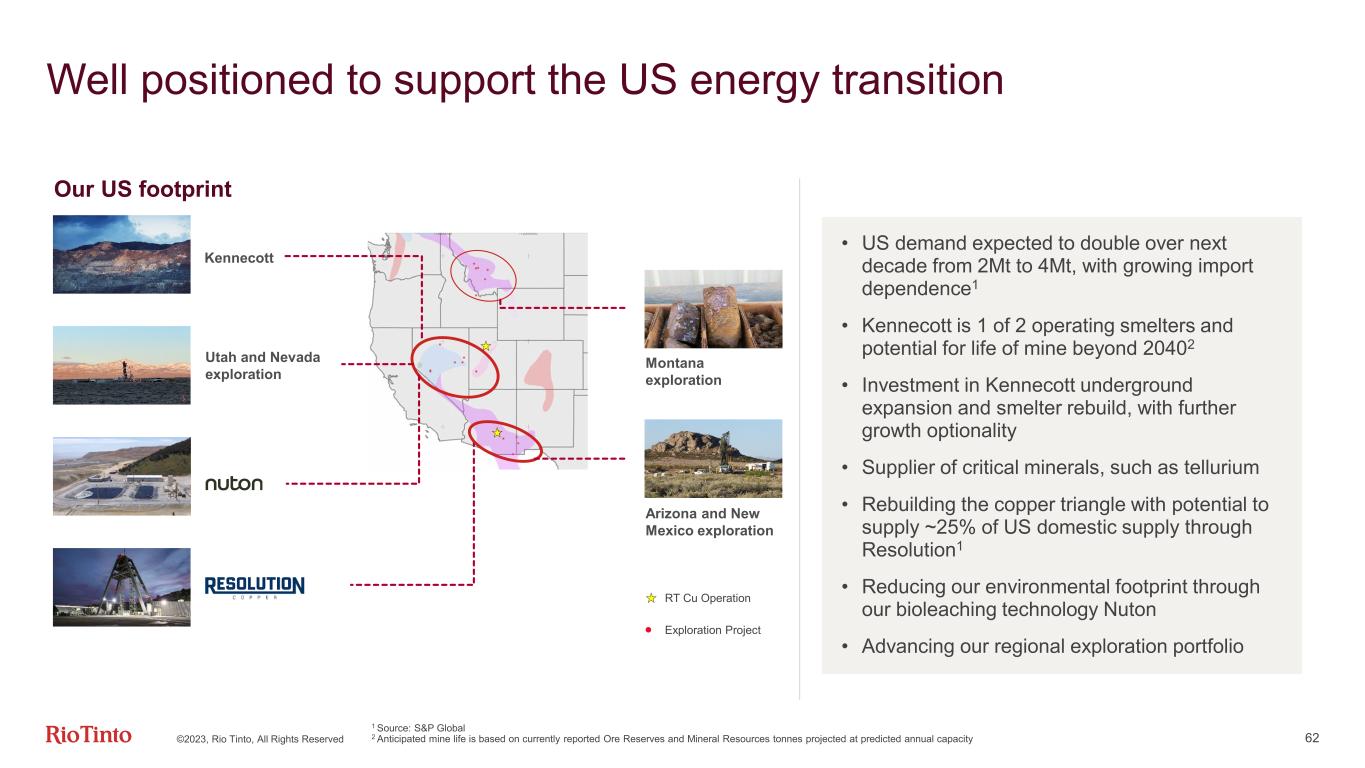
©2023, Rio Tinto, All Rights Reserved 62 Well positioned to support the US energy transition Our US footprint Arizona and New Mexico exploration RT Cu Operation • US demand expected to double over next decade from 2Mt to 4Mt, with growing import dependence1 • Kennecott is 1 of 2 operating smelters and potential for life of mine beyond 20402 • Investment in Kennecott underground expansion and smelter rebuild, with further growth optionality • Supplier of critical minerals, such as tellurium • Rebuilding the copper triangle with potential to supply ~25% of US domestic supply through Resolution1 • Reducing our environmental footprint through our bioleaching technology Nuton • Advancing our regional exploration portfolio Utah and Nevada exploration Montana exploration Exploration Project 1 Source: S&P Global 2 Anticipated mine life is based on currently reported Ore Reserves and Mineral Resources tonnes projected at predicted annual capacity Kennecott

Yerington Lion CG ©2023, Rio Tinto, All Rights Reserved 63 NutonTM - a high-recovery and low-footprint technology Outstanding copper recovery rates: CO2e emissions up to 60% lower Water consumption >80% more efficient Tailings requirement None Capital intensity >40% lower Cactus ASCU Los Azules McEwen Antakori Regulus Johnson Camp Excelsior Escondida BHP Commercial demonstration Viability study and testing Leading sustainability credentials High-performing technology: Multiple applications up to 85% on primary copper sulphide ore bodies Aim to produce world’s lowest footprint copper across our five pillars, and stretch to have a positive impact in at least one: SocietyMaterialsLandWaterEnergy Partnering with resource holders to access copper volumes 6 Partnerships 4 Countries Partnership approach: Key differentiators Portfolio today 01 02 1 Will vary depending from site to site, ore characteristics and operating environment. Rio Tinto analysis. Nuton’s performance1 vs. conventional concentrating/smelting A Rio Tinto venture

©2023, Rio Tinto, All Rights Reserved 64 Our copper business Excel in development Best operator Impeccable ESG Care Courage Curiosity Oyu Tolgoi ramping up Improving stability and returns at Kennecott Scaling up NutonTM
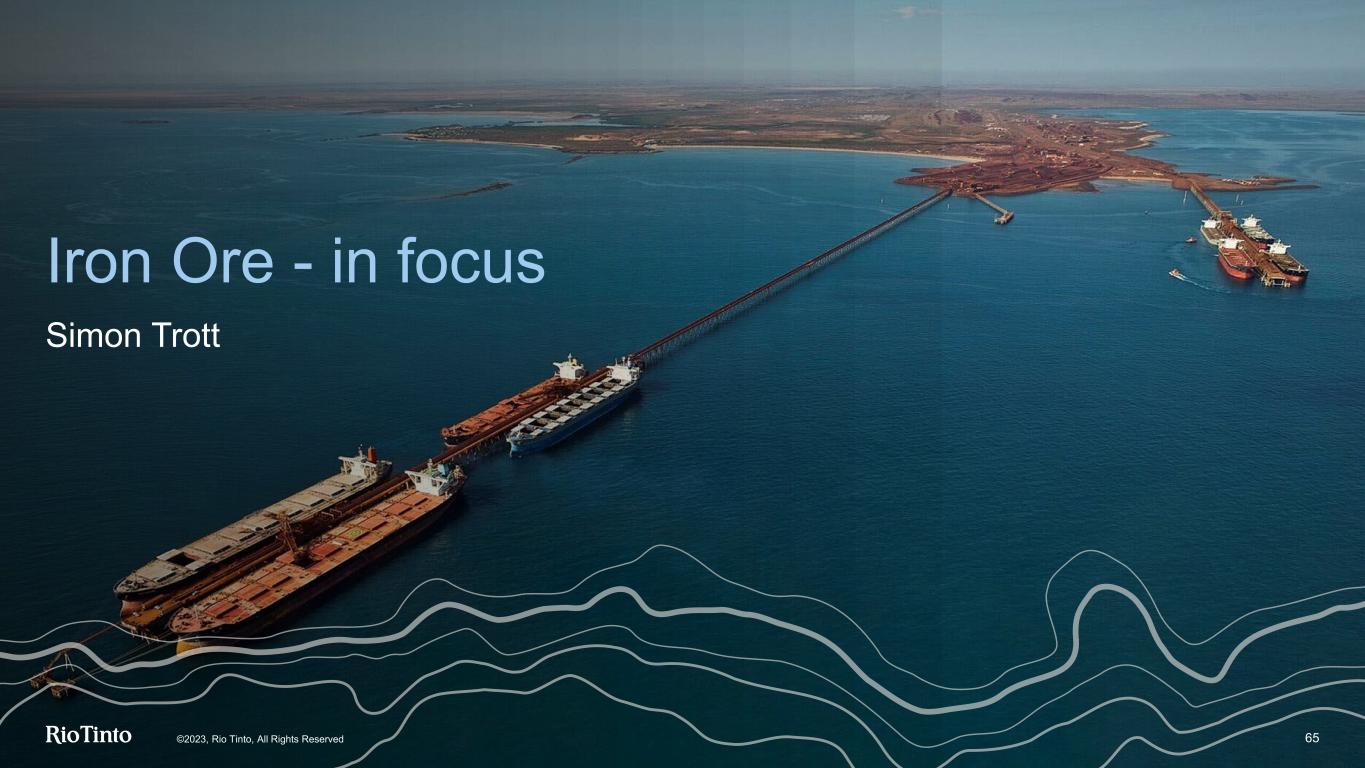
Iron Ore - in focus Simon Trott 65©2023, Rio Tinto, All Rights Reserved

©2023, Rio Tinto, All Rights Reserved 66 A portfolio compatible with the environmental and heritage values of the region Access to markets Access to infrastructure Access to resources Port and rail - our competitive advantage • >360 Mtpa of port capacity • 350 – 360Mtpa of rail capacity Co-design and co-management of mines • Investing in genuine engagement and partnership with Traditional Owners • Protecting culturally significant areas Strong strategic relationships • Joint Ventures provide access to markets • Cracking the code for Pilbara ores in a green steel world

0 20 40 60 80 100 ©2023, Rio Tinto, All Rights Reserved 67 Robust returns through disciplined investment Mine capital intensity outlook ($/t installed capacity) Rhodes Ridge: the best undeveloped project in the Pilbara 2024 - 2028 Western Range Brockman 4 West Angelas Hope Downs 1 Greater Nammuldi In development Study phase Low phosphorous Brockman ore Marra MambaBrockman Range: 30% – 80% IRR1 1. IRR range across next tranche of replacement mines 2. Mineral Resources. See slide 3 for supporting references and breakdown of Mineral Resources 6.8Bt2 at 61.6% Fe Includes 5.3Bt at 62.2% Fe and 0.6Bt at 63.9% Fe (Dimensions: 30km x 60km) Large >100 Mtpa capacity Grade-advantaged >62% for Pilbara Blend Infrastructure Close to established rail

328-335 Western Range (construction) West Angelas Hope Downs 1 Greater Nammuldi Brockman 4 Replacement projects (~130 Mtpa capacity) 320 335 323 338 345 360 2023 2024 Mid-term capacity ©2023, Rio Tinto, All Rights Reserved 68 Clear pathway to mid-term system capacity of 345 – 360 Mt Shipping guidance (Mt, 100% basis) Guidance Outlook Feasibility study 1. Capacity 2. Post development of Rhodes Ridge 5 mines in the pipeline (~130 Mtpa capacity in total) • Western Range (25 Mtpa1), first ore 2025 • West Angelas, first ore 2027 • Hope Downs 1, first ore 2027 • Greater Nammuldi, first ore 2028 • Brockman 4, first ore 2028 Productivity and mine capacity depletion • Safe Production System: 5 Mt in 2023 and 5Mt in 2024 • Depletion: ~18 Mt in 2023 and ~12 Mt in 2024 (~90 Mt 2023 to mid-term) Rhodes Ridge • >100 Mt of capacity, staged development with first ore this decade • Re-orients Pilbara Blend to >85% of shipments Equity share and product mix • SP10 45 – 50 Mt in 2023 and elevated until replacement projects delivered • Effective equity share of free cashflow stable at >85%2

Development Drill & blast Load & haul RailProcessing Ports Focus on front line engagement is delivering results 4,332 Increase in ideas from front line2 2,196 Increase in ideas actioned2 Highest employee satisfaction since survey began in 2018 4% reduction in all injury frequency rate1 4% increase in employee2 productivity per tonne of saleable ore1 25% increase in People Survey participation2 West Angelas Yandicoogina Brockman 4 Tom Price Marandoo Cape Lambert Rail Cape Lambert Port A B C D E F G Deployment 14% Spatial conformance1 E 10% Ex-pit movement1 D 25% Surface mining health2 C 27% Metres drilled per hour1 C 21% D&B confirmed tonnes1 B 6% Drill availability1 A 10% Fixed plant availability1 D 82% Reduction in shut overrun1 B 48% Rock breaking delays1 A 11% Truck work rate1 E 14% Haul Truck utilisation2 D 18% Dig unit utilisation1 C 5% Cape Lambert rail cycle time1 F 14% Resurfacing productivity1 F 11% Cape Lambert A plant effective utilisation1 G 3.6% Cape Lambert A plant downtime1 G 1 Year-on-year improvement (2022 compared to H1 2023); 2 Improvement since deployment commenced 69 Safe Production System to deliver 5Mt production uplift in both 2023 and 2024
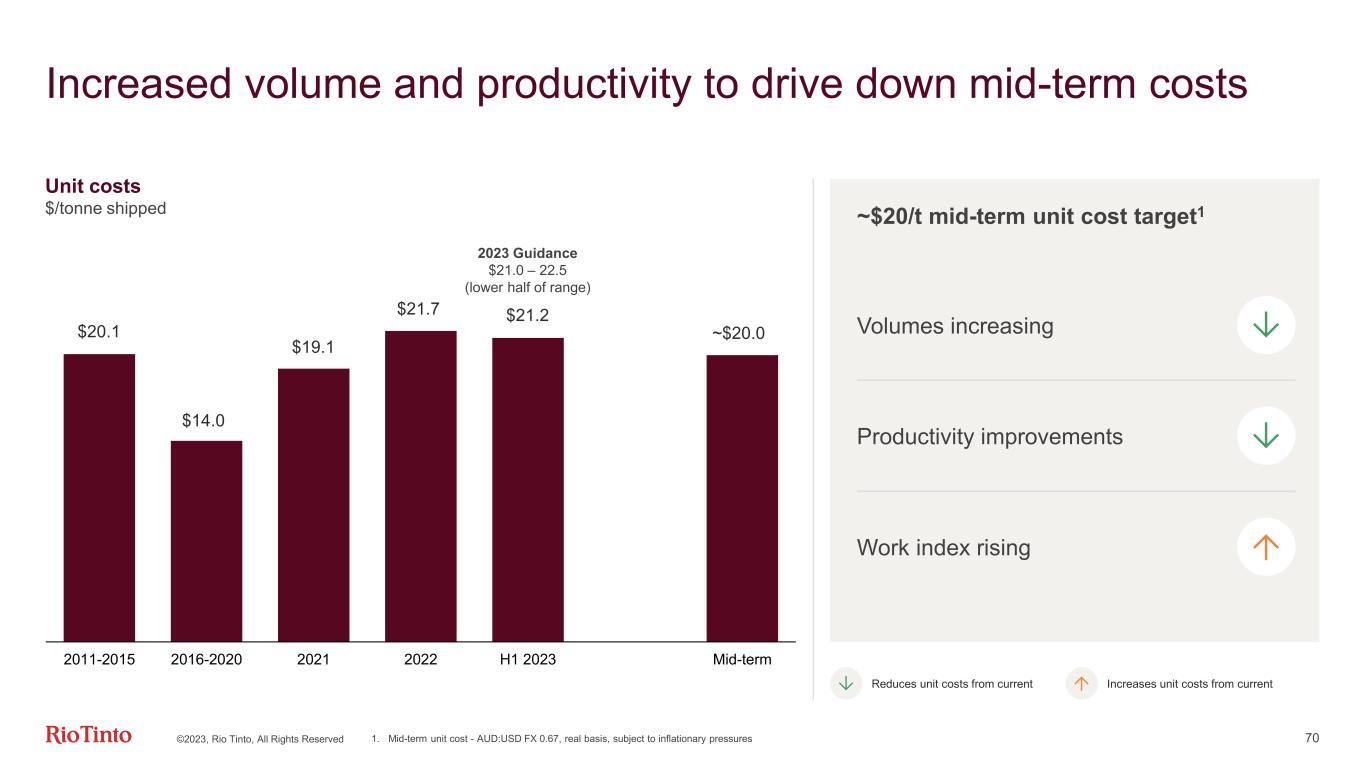
2011-2015 2016-2020 2021 2022 H1 2023 Mid-term Unit costs $/tonne shipped $21.2 ~$20.0 ~$20/t mid-term unit cost target1 Reduces unit costs from current Increases unit costs from current ©2023, Rio Tinto, All Rights Reserved 70 Increased volume and productivity to drive down mid-term costs Volumes increasing Productivity improvements Work index rising 1. Mid-term unit cost - AUD:USD FX 0.67, real basis, subject to inflationary pressures $21.7 $19.1 $14.0 $20.1 2023 Guidance $21.0 – 22.5 (lower half of range)
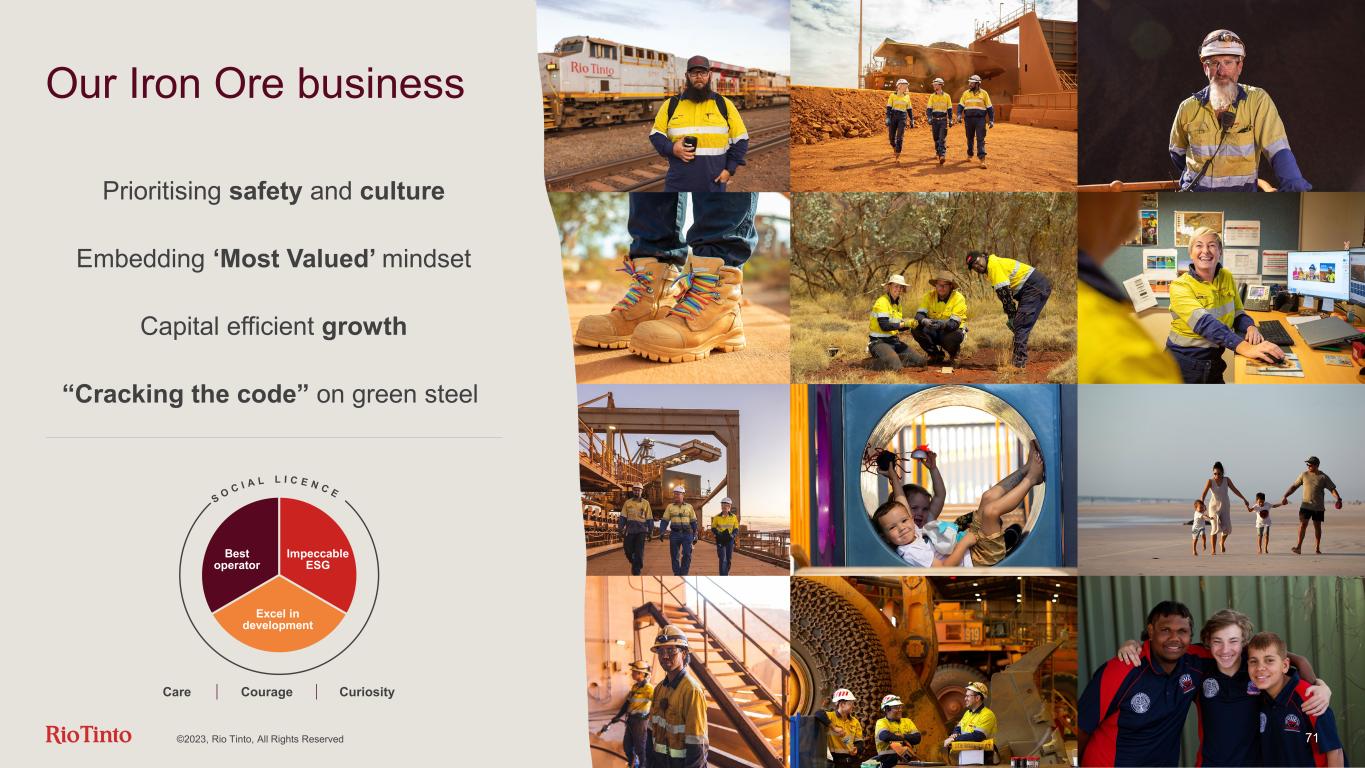
©2023, Rio Tinto, All Rights Reserved Our Iron Ore business Prioritising safety and culture Embedding ‘Most Valued’ mindset Capital efficient growth “Cracking the code” on green steel Excel in development Best operator Impeccable ESG Care Courage Curiosity 71

Simandou Bold Baatar Mark Davies ©2023, Rio Tinto, All Rights Reserved 72
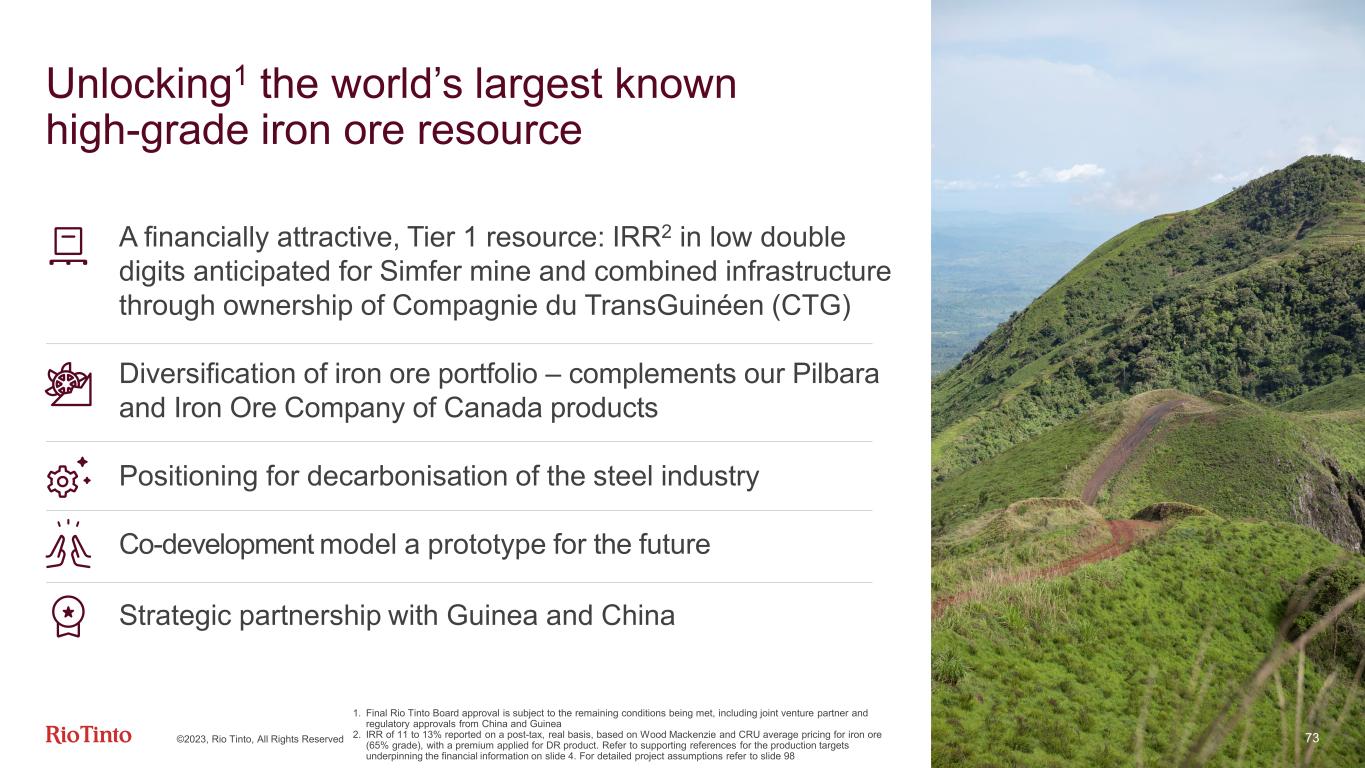
A financially attractive, Tier 1 resource: IRR2 in low double digits anticipated for Simfer mine and combined infrastructure through ownership of Compagnie du TransGuinéen (CTG) Diversification of iron ore portfolio – complements our Pilbara and Iron Ore Company of Canada products Positioning for decarbonisation of the steel industry Co-development model a prototype for the future Strategic partnership with Guinea and China ©2023, Rio Tinto, All Rights Reserved 73 Unlocking1 the world’s largest known high-grade iron ore resource 1. Final Rio Tinto Board approval is subject to the remaining conditions being met, including joint venture partner and regulatory approvals from China and Guinea 2. IRR of 11 to 13% reported on a post-tax, real basis, based on Wood Mackenzie and CRU average pricing for iron ore (65% grade), with a premium applied for DR product. Refer to supporting references for the production targets underpinning the financial information on slide 4. For detailed project assumptions refer to slide 98
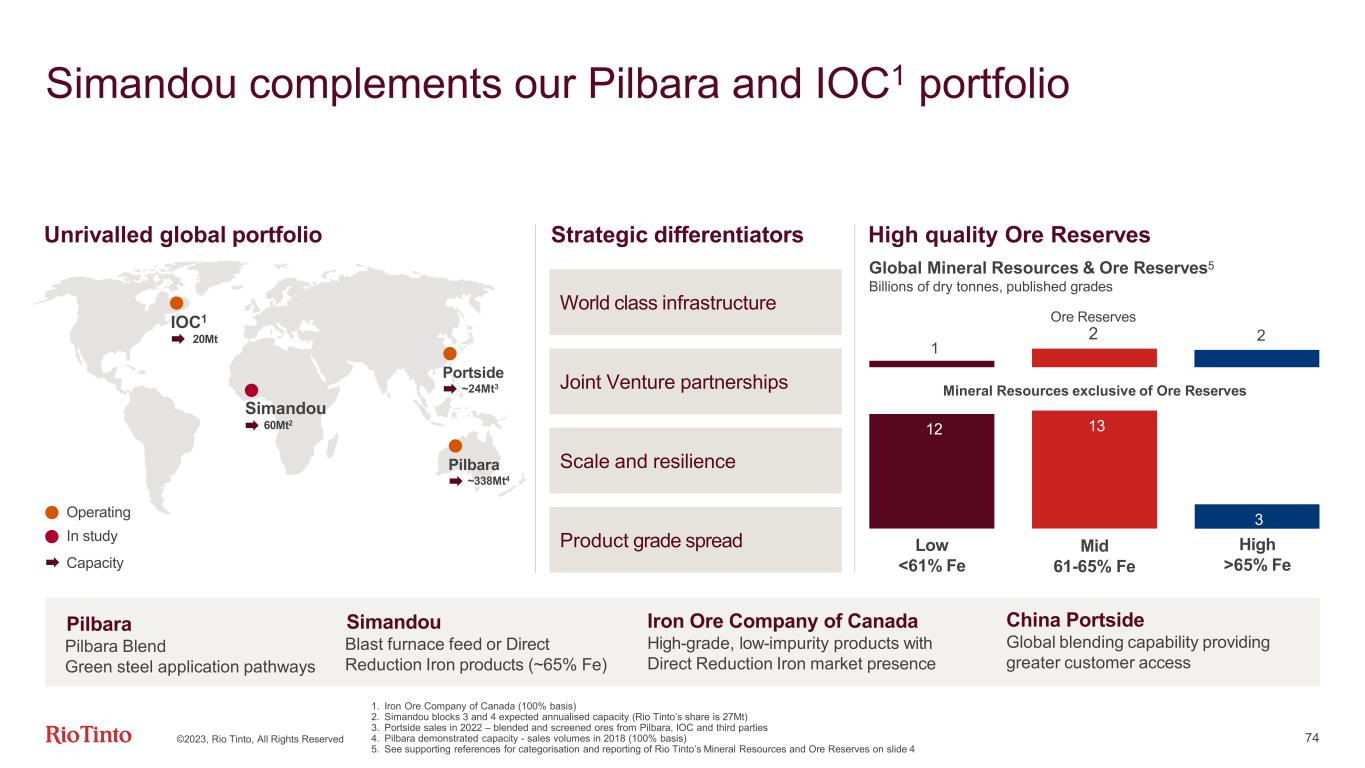
©2023, Rio Tinto, All Rights Reserved 74 Simandou complements our Pilbara and IOC1 portfolio Global Mineral Resources & Ore Reserves5 Billions of dry tonnes, published grades Pilbara Pilbara Blend Green steel application pathways IOC1 20Mt Simandou 60Mt2 Pilbara ~338Mt4 Portside ~24Mt3 Unrivalled global portfolio World class infrastructure Joint Venture partnerships Scale and resilience Product grade spread Operating In study Capacity Iron Ore Company of Canada High-grade, low-impurity products with Direct Reduction Iron market presence Simandou Blast furnace feed or Direct Reduction Iron products (~65% Fe) China Portside Global blending capability providing greater customer access 12 13 3 1 Ore Reserves 2 2 Low <61% Fe Mid 61-65% Fe High >65% Fe Mineral Resources exclusive of Ore Reserves Strategic differentiators High quality Ore Reserves 1. Iron Ore Company of Canada (100% basis) 2. Simandou blocks 3 and 4 expected annualised capacity (Rio Tinto’s share is 27Mt) 3. Portside sales in 2022 – blended and screened ores from Pilbara, IOC and third parties 4. Pilbara demonstrated capacity - sales volumes in 2018 (100% basis) 5. See supporting references for categorisation and reporting of Rio Tinto’s Mineral Resources and Ore Reserves on slide 4

©2023, Rio Tinto, All Rights Reserved 75 Three dimensions to the Simandou project 01 Compagnie du TransGuinéen (CTG) Infrastructure1 02 Simfer Mine – blocks 3 & 4 03 WCS Mine – blocks 1 & 2 Funded: 50% by Simfer InfraCo (53% Rio Tinto, 47% CIOH Consortium2) 50% by WCS InfraCo Ownership: 15% Government of Guinea 42.5% Simfer InfraCo (53% Rio Tinto, 47% CIOH Consortium2) 42.5% WCS InfraCo (51% Winning Consortium3, 49% Baowu) Ownership: 51% Winning Consortium3 49% Baowu – with a stated option to increase to 51% 1. The ownership of the rail and port infrastructure will transfer from CTG to the Guinean State after a 35-year Operations Period, with Simfer retaining access rights on a non-discriminatory basis and at least equivalent to all Third Party Users 2. Chalco Iron Ore Holdings (CIOH) Consortium: 75% Chinalco, 20% Baowu, 2.5% China Rail Construction Corporation and 2.5% China Harbour Engineering Company 3. Winning Consortium is currently a consortium of Singaporean company, Winning International Group (50%), Weiqiao Aluminium (part of the China Hongqiao Group) (50%) and United Mining Supply Group (nominal shareholding) Funded: 53% by Rio Tinto 47% by CIOH Consortium2 Ownership: 15% Government of Guinea 85% Simfer Jersey (53% Rio Tinto, 47% CIOH Consortium2)
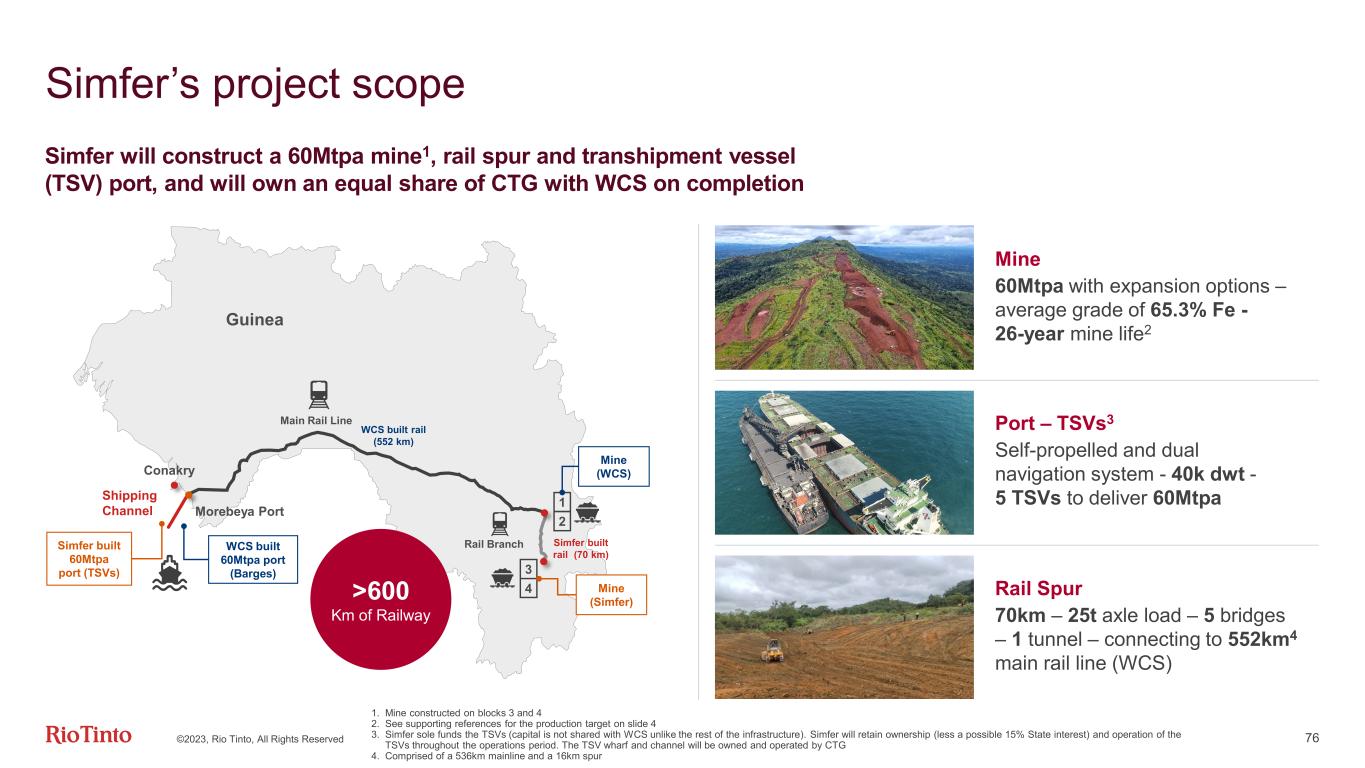
©2023, Rio Tinto, All Rights Reserved 76 Simfer’s project scope Guinea Conakry 4 3 2 1 Rail Branch Main Rail Line Shipping Channel Morebeya Port Simfer built rail (70 km) WCS built rail (552 km) 1. Mine constructed on blocks 3 and 4 2. See supporting references for the production target on slide 4 3. Simfer sole funds the TSVs (capital is not shared with WCS unlike the rest of the infrastructure). Simfer will retain ownership (less a possible 15% State interest) and operation of the TSVs throughout the operations period. The TSV wharf and channel will be owned and operated by CTG 4. Comprised of a 536km mainline and a 16km spur Simfer will construct a 60Mtpa mine1, rail spur and transhipment vessel (TSV) port, and will own an equal share of CTG with WCS on completion Mine 60Mtpa with expansion options – average grade of 65.3% Fe - 26-year mine life2 Port – TSVs3 Self-propelled and dual navigation system - 40k dwt - 5 TSVs to deliver 60Mtpa Rail Spur 70km – 25t axle load – 5 bridges – 1 tunnel – connecting to 552km4 main rail line (WCS) Mine (Simfer) Mine (WCS) WCS built 60Mtpa port (Barges) Simfer built 60Mtpa port (TSVs) >600 Km of Railway
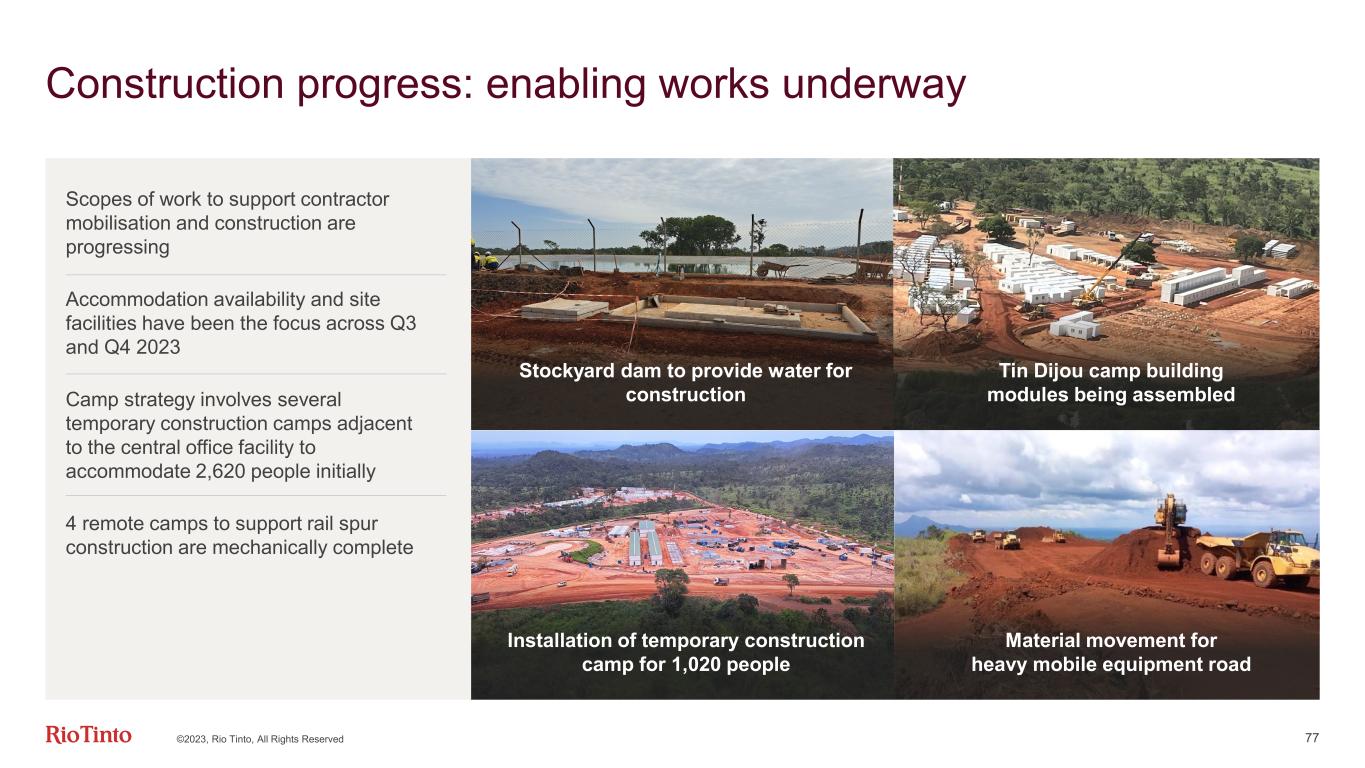
Stockyard dam to provide water for construction Tin Dijou camp building modules being assembled Installation of temporary construction camp for 1,020 people Material movement for heavy mobile equipment road Scopes of work to support contractor mobilisation and construction are progressing Accommodation availability and site facilities have been the focus across Q3 and Q4 2023 Camp strategy involves several temporary construction camps adjacent to the central office facility to accommodate 2,620 people initially 4 remote camps to support rail spur construction are mechanically complete ©2023, Rio Tinto, All Rights Reserved 77 Construction progress: enabling works underway

Simfer capex Rio Tinto share Mine and TSVs, owned and operated by Simfer: Development of an initial 60Mtpa mine2 at Simandou South (blocks 3 & 4) to be constructed by Simfer $5.1 billion $2.7 billion Co-developed infrastructure, owned and operated by CTG once complete3: Simfer scope Rail: a 70 km rail-spur from Simfer mine to the mainline, including rolling stock Port: construction of a 60Mtpa TSV port $3.5 billion $1.9 billion WCS scope Port and rail infrastructure including a 552 km trans-Guinean heavy haul rail system4 $3.0 billion $1.6 billion Total capital expenditure (nominal terms) $11.6 billion $6.2 billion5 ©2023, Rio Tinto, All Rights Reserved 78 Simfer capital expenditure summary Final Rio Tinto Board approval is subject to the remaining conditions being met, including joint venture partner and regulatory approvals from China and Guinea1 1. Investments into the WCS infrastructure project companies, that will serve as the joint venture vehicles for construction of the co-developed infrastructure, remain subject to a number of conditions including governmental approvals from Guinea and China 2. See supporting references for the production target on slide 4 3. A true-up mechanism will apply between Simfer and WCS to equalise their out of pocket costs of constructing the co-developed rail and port infrastructure 4. Comprised of a 536km mainline and a 16km spur 5. By the end of 2023, Rio Tinto expects to have invested $0.5 billion (Rio Tinto share) to progress critical path works. Rio Tinto’s share of capital investment remaining to be spent from 1 January 2024 is expected to be $5.7 billion

Commitment to globally recognised ESG standards and best practices Key Risks Regional economic development Economic contribution Job creation Co-development model Climate change resilience Key Opportunities Health and safety Biodiversity Project-induced migration Resettlement and land access Human Rights ©2023, Rio Tinto, All Rights Reserved 79

80 Capital allocation and financials Peter Cunningham
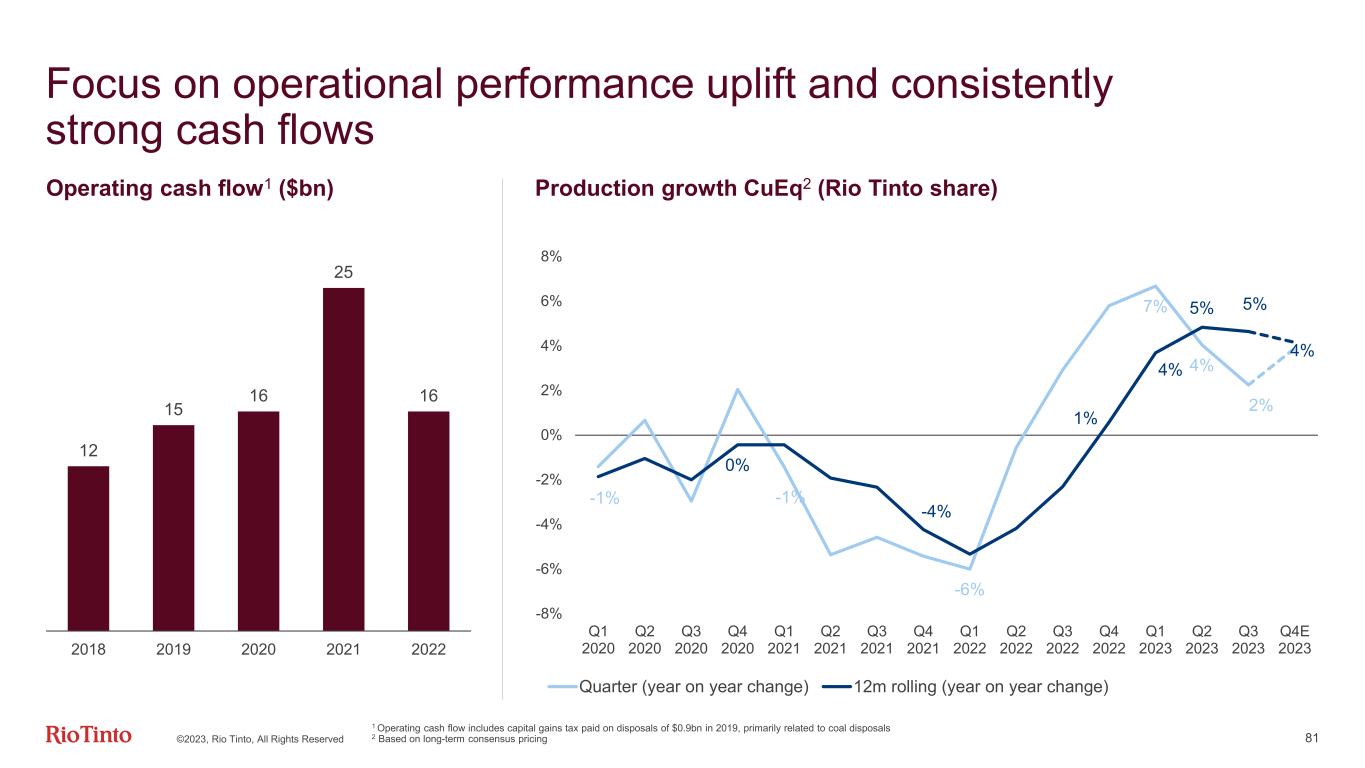
©2023, Rio Tinto, All Rights Reserved 81 Focus on operational performance uplift and consistently strong cash flows Operating cash flow1 ($bn) Production growth CuEq2 (Rio Tinto share) 1 Operating cash flow includes capital gains tax paid on disposals of $0.9bn in 2019, primarily related to coal disposals 2 Based on long-term consensus pricing 12 15 16 25 16 2018 2019 2020 2021 2022 -1% -1% -6% 7% 4% 2% 0% -4% 1% 4% 5% 5% 4% -8% -6% -4% -2% 0% 2% 4% 6% 8% Q1 2020 Q2 2020 Q3 2020 Q4 2020 Q1 2021 Q2 2021 Q3 2021 Q4 2021 Q1 2022 Q2 2022 Q3 2022 Q4 2022 Q1 2023 Q2 2023 Q3 2023 Q4E 2023 Quarter (year on year change) 12m rolling (year on year change)

©2023, Rio Tinto, All Rights Reserved 82 Operating cash flow includes investment for creating growth options and strengthening social licence $bn 0.3 0.2 0.3 0.3 0.4 0.5 0.6 0.7 0.2 0.2 0.3 0.4 0.3 0.4 0.4 0.5 2021 2022 2023F 2024F Exploration Evaluation (excluding Simandou) CSP and Social Investment Decarbonisation and R&D 1.2 1.3 1.6 1.9 • Expenditure rising in line with development of project portfolio • Fully expensed via the P&L • Includes $250m per year of central greenfield exploration • R&D includes NutonTM, ELYSIS, decarbonisation and other projects • Progressing studies on Rincon, Resolution, Pilbara replacement and Rhodes Ridge in 2023/24

©2023, Rio Tinto, All Rights Reserved 83 Consistent capital allocation, balancing essential capex with shareholder returns and growth 1 Shareholder returns on a declared basis, excluding divestment proceeds returned to shareholders Essential capex ($bn) Integrity, Replacement, Decarbonisation01 Ordinary dividends ($bn) 60% of underlying earnings paid out in each of past 7 years1 02 Iterative cycle of…03 3.1 5.2 5.3 6.2 7.5 12.8 8.0 2022 2023F 2024F 2025F 2026F ~7.0 ~7.0 ~6.0 Sustaining Replacement Decarbonisation 20222016 20192017 2018 20212020 Declared basis ~7.0 Further cash returns to shareholders Compelling growth Debt management 6.2
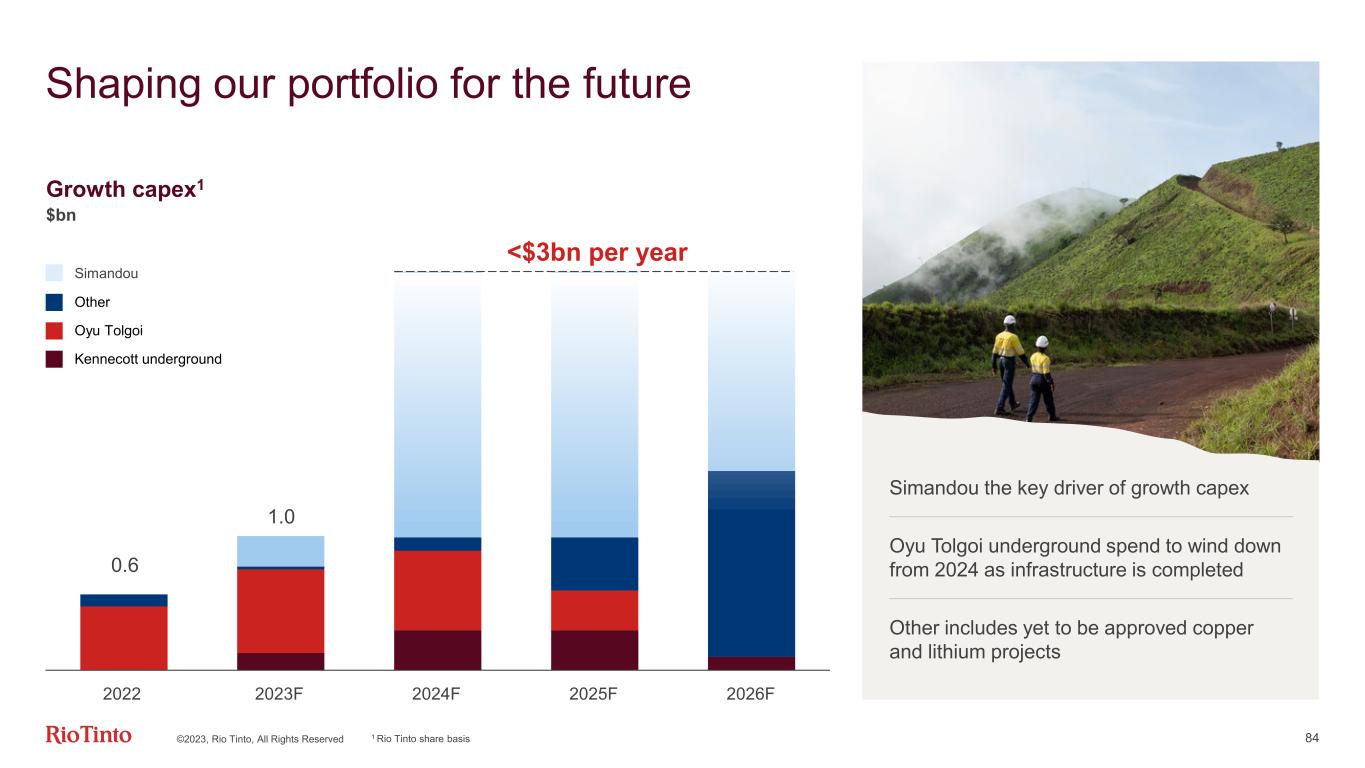
©2023, Rio Tinto, All Rights Reserved 84 Shaping our portfolio for the future 1 Rio Tinto share basis Growth capex1 $bn Simandou the key driver of growth capex Oyu Tolgoi underground spend to wind down from 2024 as infrastructure is completed Other includes yet to be approved copper and lithium projects 2022 2023F 2024F 2025F 0.6 1.0 2026F Simandou Other Oyu Tolgoi Kennecott underground <$3bn per year
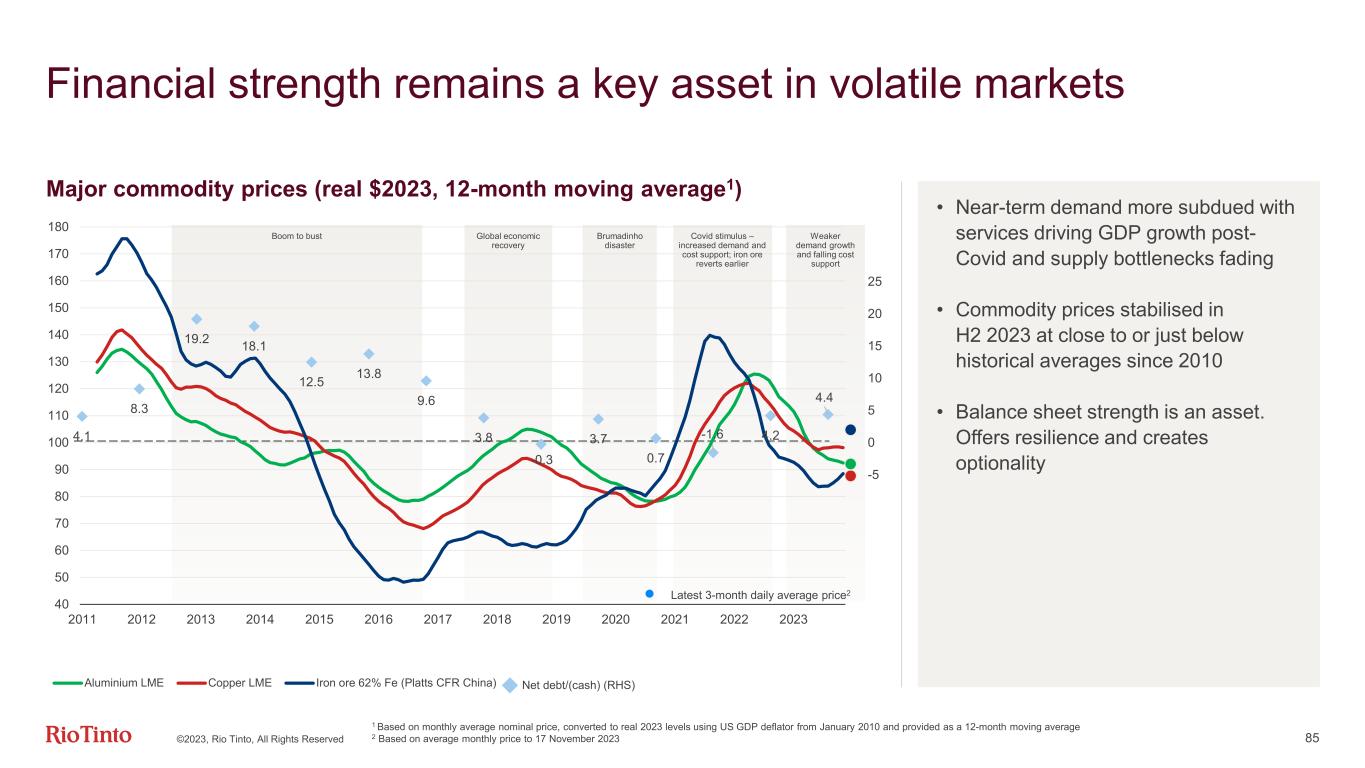
• Near-term demand more subdued with services driving GDP growth post- Covid and supply bottlenecks fading • Commodity prices stabilised in H2 2023 at close to or just below historical averages since 2010 • Balance sheet strength is an asset. Offers resilience and creates optionality ©2023, Rio Tinto, All Rights Reserved 85 Financial strength remains a key asset in volatile markets Major commodity prices (real $2023, 12-month moving average1) 1 Based on monthly average nominal price, converted to real 2023 levels using US GDP deflator from January 2010 and provided as a 12-month moving average 2 Based on average monthly price to 17 November 2023 Net debt/(cash) (RHS) 40 50 60 70 80 90 100 110 120 130 140 150 160 170 180 2011 2012 2013 2014 2015 2016 2017 2018 2019 2020 2021 2022 2023 Aluminium LME Copper LME Iron ore 62% Fe (Platts CFR China) 4.1 8.3 19.2 18.1 12.5 13.8 9.6 3.8 -0.3 3.7 0.7 -1.6 4.2 4.4 -5 0 5 10 15 20 25 Latest 3-month daily average price2 Boom to bust Brumadinho disaster Covid stimulus – increased demand and cost support; iron ore reverts earlier Weaker demand growth and falling cost support Global economic recovery

86 Decarbonisation investment pathways continue to evolve Decarbonisation pipeline (Mt CO2e, equity basis) Approved/ in-execution Executable Pilot scalePartnering with government Proof of concept -300 -200 -100 0 100 200 300 400 500 600 M AC ($ /t) Commercial solutions (opex) Capital solutions 1Mt abatement 2023-2030 capex % 2030 CO2e abatement % Commercial solutions • PPAs, VPPAs, RECs • Biofuels Capital solutions • Onsite renewables • Alumina process heat • Renewable diesel Nature-based solutions • Development connected to our operating regions ~65-70% ~10% ~25-30% ~5% ~90% -%1 Capital allocation driven by NPV/MAC, execution readiness, asset strength Greater use of commercial solutions and partnerships are easing capex requirements this decade Major fleet electrification expected post-2030 Total capex guidance to 2030 revised to $5-6bn1,2 RBM PPA BlueSmelting™ pilot OT RECs KUC renewable diesel Boyne Repowering Pilbara renewables H2 calcination ©2023, Rio Tinto, All Rights Reserved 1 Excludes capitalised voluntary offset costs and compliance based offset costs (e.g. Australian Safeguard mechanism ACCUs), estimated at ~$1bn to 2030. Rio Tinto nature-based solutions are opex as project funding does not meet accounting capitalisation criteria 2 Excludes costs expensed to the income statement associated with early-stage R&D and studies
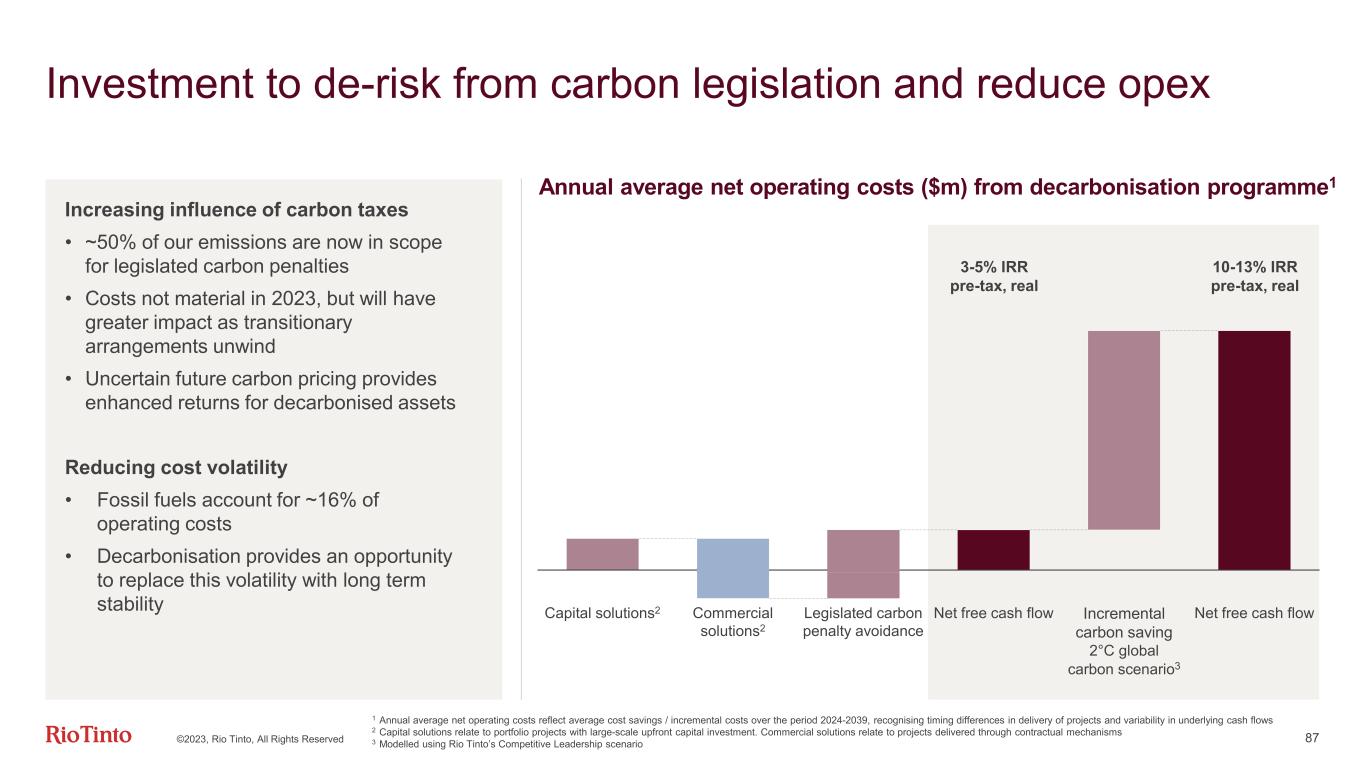
©2023, Rio Tinto, All Rights Reserved 87 Investment to de-risk from carbon legislation and reduce opex Capital solutions2 Commercial solutions2 Legislated carbon penalty avoidance Net free cash flow Incremental carbon saving 2°C global carbon scenario3 Net free cash flow Annual average net operating costs ($m) from decarbonisation programme1 3-5% IRR pre-tax, real 10-13% IRR pre-tax, real 1 Annual average net operating costs reflect average cost savings / incremental costs over the period 2024-2039, recognising timing differences in delivery of projects and variability in underlying cash flows 2 Capital solutions relate to portfolio projects with large-scale upfront capital investment. Commercial solutions relate to projects delivered through contractual mechanisms 3 Modelled using Rio Tinto’s Competitive Leadership scenario Increasing influence of carbon taxes • ~50% of our emissions are now in scope for legislated carbon penalties • Costs not material in 2023, but will have greater impact as transitionary arrangements unwind • Uncertain future carbon pricing provides enhanced returns for decarbonised assets Reducing cost volatility • Fossil fuels account for ~16% of operating costs • Decarbonisation provides an opportunity to replace this volatility with long term stability
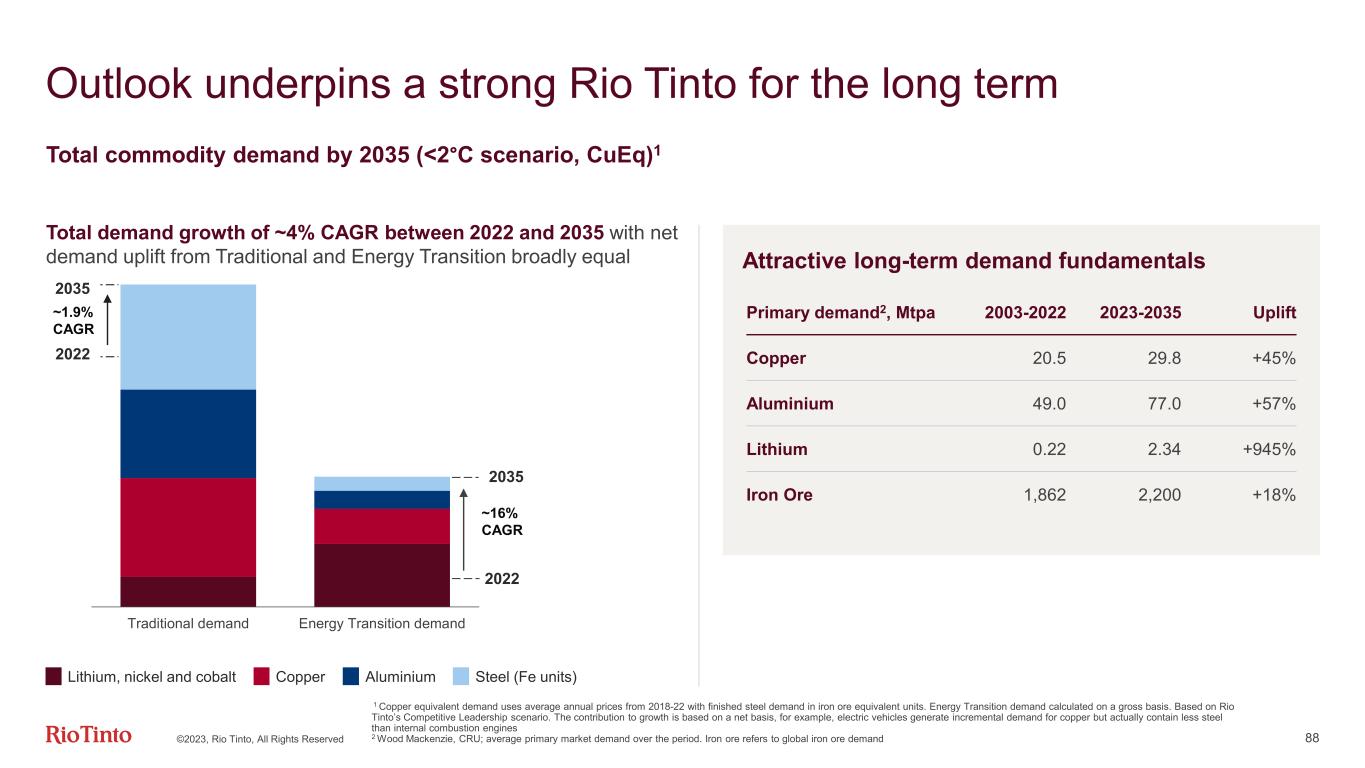
©2023, Rio Tinto, All Rights Reserved 88 Outlook underpins a strong Rio Tinto for the long term 1 Copper equivalent demand uses average annual prices from 2018-22 with finished steel demand in iron ore equivalent units. Energy Transition demand calculated on a gross basis. Based on Rio Tinto’s Competitive Leadership scenario. The contribution to growth is based on a net basis, for example, electric vehicles generate incremental demand for copper but actually contain less steel than internal combustion engines 2 Wood Mackenzie, CRU; average primary market demand over the period. Iron ore refers to global iron ore demand Total commodity demand by 2035 (<2°C scenario, CuEq)1 Attractive long-term demand fundamentals Primary demand2, Mtpa 2003-2022 2023-2035 Uplift Copper 20.5 29.8 +45% Aluminium 49.0 77.0 +57% Lithium 0.22 2.34 +945% Iron Ore 1,862 2,200 +18% Total demand growth of ~4% CAGR between 2022 and 2035 with net demand uplift from Traditional and Energy Transition broadly equal Lithium, nickel and cobalt AluminiumCopper Steel (Fe units) ~16% CAGR Traditional demand Energy Transition demand 2022 2022 2035 2035 ~1.9% CAGR

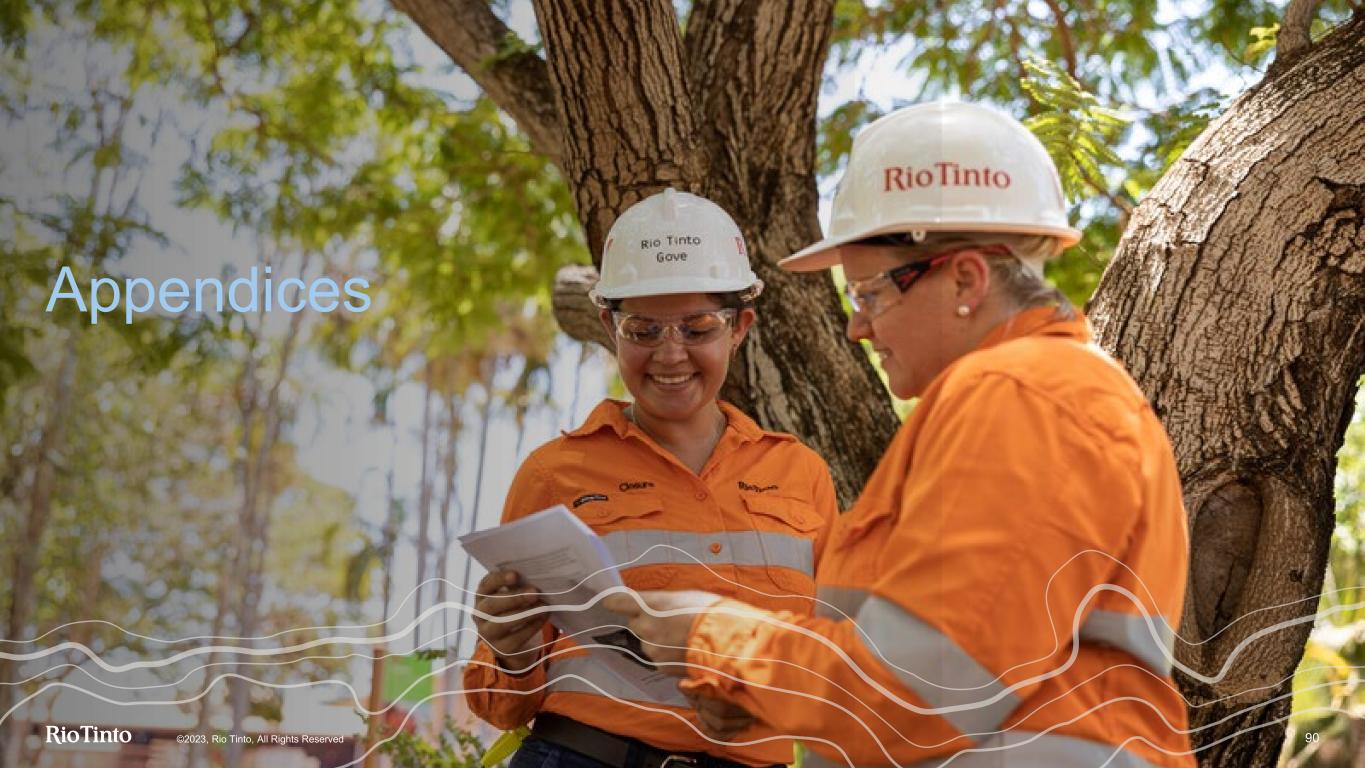
Appendices 90©2023, Rio Tinto, All Rights Reserved

Guidance ©2023, Rio Tinto, All Rights Reserved 91

©2023, Rio Tinto, All Rights Reserved 92 Production guidance 1 Pilbara shipments guidance remains subject to weather, market conditions and management of cultural heritage | 2 In the upper half of the range | 3 Includes Oyu Tolgoi on a 100% consolidated basis and continues to reflect our 30% share of Escondida | 4 In the lower end of the range | 5 Iron Ore Company of Canada 2023 Guidance 2024 Guidance Pilbara iron ore shipments1 (100% basis) 320 – 335Mt2 323 – 338Mt Copper Mined Copper (consolidated basis)3 Refined Copper 590 – 640kt 160 – 190kt 660 – 720kt 230 – 260kt Aluminium Bauxite Alumina Aluminium 54 – 57Mt4 7.4 – 7.7Mt 3.1 – 3.3Mt 53 – 56Mt 7.6 – 7.9Mt 3.2 – 3.4Mt Minerals TiO2 IOC pellets and concentrate5 B2O3 1.1 – 1.4Mt4 9.3 – 9.8Mt ~0.5Mt 0.9 – 1.1Mt 9.8 – 11.5Mt ~0.5Mt

©2023, Rio Tinto, All Rights Reserved 93 Group level financial guidance 2023 2024-2026 (per year) Capex Total Group1 ~$7.0bn ~$10.0bn Growth capital ~$1.0bn2 Up to $3bn Sustaining capital ~$4.0bn ~$4.0bn Including Pilbara sustaining3 ~$2.0bn ~$1.8bn Replacement capital ~$1.7bn ~$2 to $3bn Decarbonisation capital ~$0.15bn ~$1.5bn cumulative Effective tax rate ~30% Shareholder returns Total returns of 40 – 60% of underlying earnings through the cycle 1 Including Simandou | 2 We expect our share of investment in Simandou to be ~$0.2 billion in H2 2023 | 3 Subject to ongoing inflationary pressure
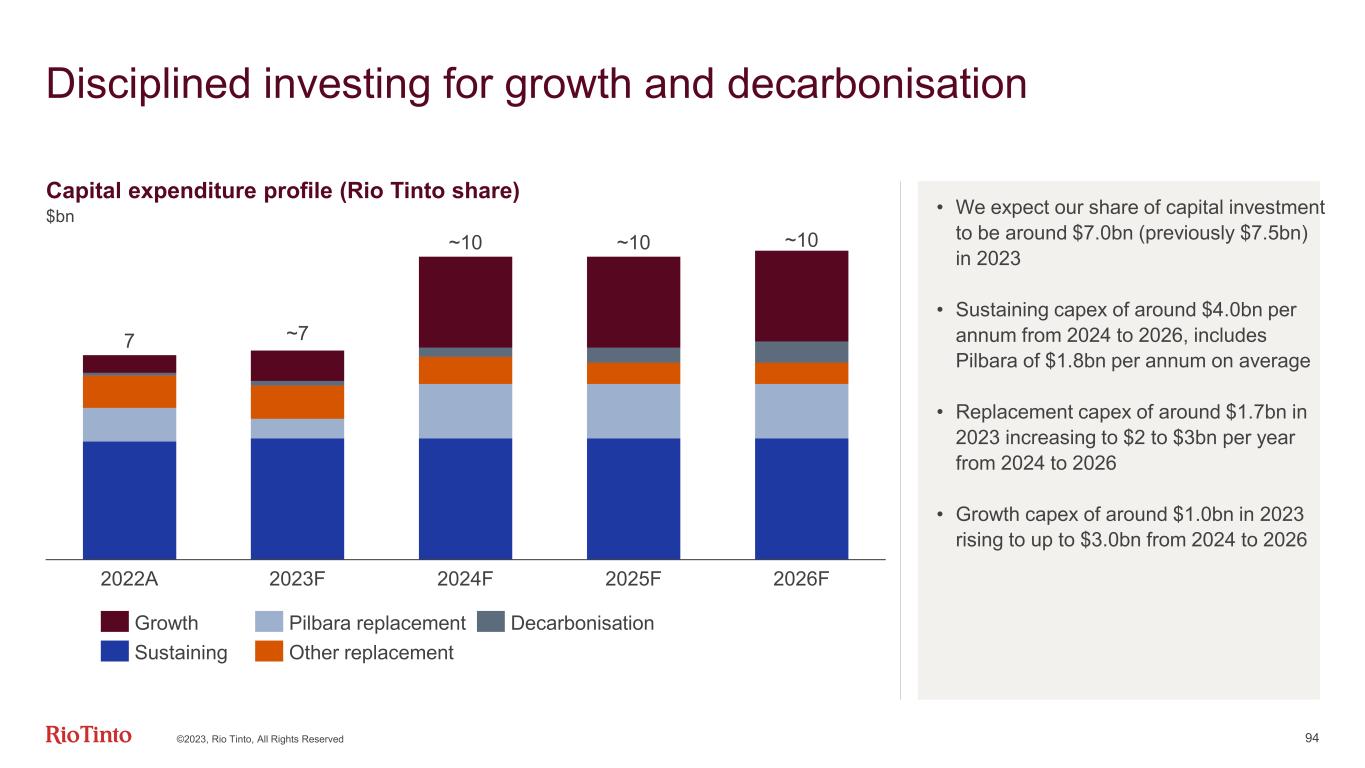
©2023, Rio Tinto, All Rights Reserved 94 Disciplined investing for growth and decarbonisation Capital expenditure profile (Rio Tinto share) $bn • We expect our share of capital investment to be around $7.0bn (previously $7.5bn) in 2023 • Sustaining capex of around $4.0bn per annum from 2024 to 2026, includes Pilbara of $1.8bn per annum on average • Replacement capex of around $1.7bn in 2023 increasing to $2 to $3bn per year from 2024 to 2026 • Growth capex of around $1.0bn in 2023 rising to up to $3.0bn from 2024 to 2026 2022A 7 ~7 ~10 2023F 2024F 2025F 2026F ~10 ~10 Growth Pilbara replacement Sustaining Decarbonisation Other replacement
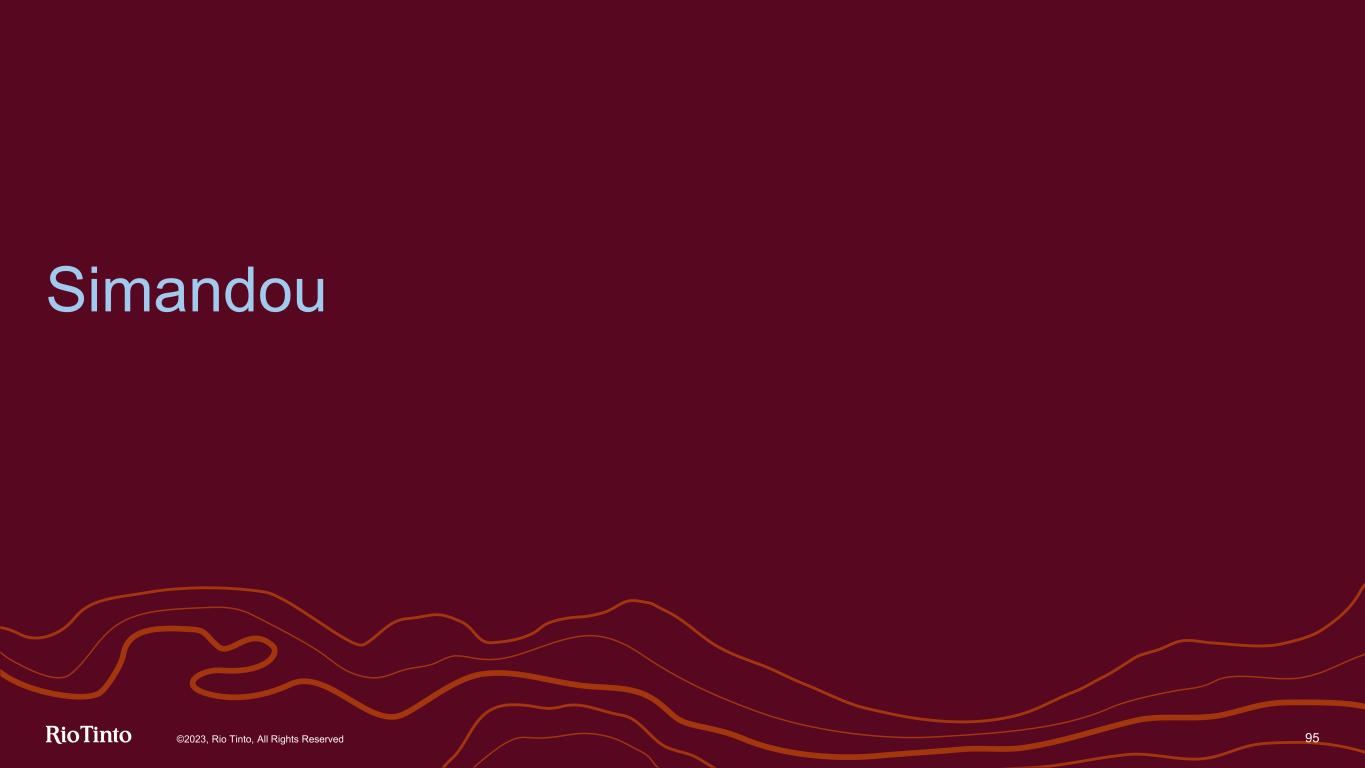
Simandou ©2023, Rio Tinto, All Rights Reserved 95

©2023, Rio Tinto, All Rights Reserved 96 WCS and Simfer have separate scopes to leverage expertise, and reduce risk and costs Structure during operations Infrastructure assets will be funded 50/50 overall by WCS and Simfer in a co-development arrangement of focused scopes2. During construction, Simfer will hold 34% of WCS entities responsible for construction Simfer InfraCo will construct on behalf of CTG: • 70 km Simfer spur line • 60 Mtpa transhipment vessel (TSV) port WCS InfraCo will construct on behalf of CTG: • 552 km3 main rail line and WCS spur line • 60 Mtpa barge wharf Once infrastructure is complete, CTG will own and, with independent management team, operate all port and rail assets, excluding the WCS barges and Simfer TSVs CTG shareholders: 42.5% Simfer InfraCo, 42.5% WCS InfraCo and 15% Government of Guinea (during construction and operation) 1. 75% Chinalco, 20% Baowu, 2.5% China Rail Construction Corporation and 2.5% China Harbour Engineering Company 2. A true-up mechanism at the end of construction will top up/down to ensure 50/50 equal spend 3. Comprised of a 536km mainline and a 16km spur 15% Baowu Consortium Winning Consortium WCS InfraCo Government of Guinea Compagnie du TransGuinéen (CTG) Rio Tinto Chinalco Consortium1 Simfer InfraCo 51%49% 42.5% 42.5% 47%53%

7-member CTG Board of Directors Guinean Chairman appointed by the State Transitional arrangements during construction to comply with existing conventions Simfer and WCS have equal rights including capacity share split Sustainability committee to oversee ESG / HSSEC performance Leverages expertise of Winning Consortium Simandou (WCS) know-how in Guinea and Rio Tinto ESG capability The Co-Development Agreement (CDA) with the State sets the project scope for WCS and Simfer and links the existing conventions and investment frameworks Compagnie du TransGuinéen co-development model ©2023, Rio Tinto, All Rights Reserved 97 Robust governance structure The Compagnie du TransGuinéen (CTG) Shareholders Agreement provides for a robust governance model (including rights to appoint directors and senior managers), an HSSEC, business integrity and quality assurance regime, regular independent audits, HSSEC secondees and regular KPI reporting. Other transaction documents that are currently being negotiated will provide for a true-up mechanism between Simfer and WCS, to equalise the costs of constructing the rail and port infrastructure; and shareholders agreements to implement that governance model, including HSSEC, to the WCS and Simfer project companies that are undertaking construction.

©2023, Rio Tinto, All Rights Reserved 98 Simandou project life of mine key statistics1 IRR2 in low double digits anticipated for Simfer mine and combined infrastructure through ownership of CTG Mine Open pit, 1.5Bt Ore Reserves, Block 3 only Ownership Rio Tinto (45%), Chinalco Iron Ore Holdings (40%) Government of Guinea (15%) Construction time ~3 years First Production 2025 Ramp-up ~30 months Capex (Mine and TSVs) $5.1bn nominal (100% basis); $2.7bn RT share3 Throughput rate 60 Mtpa Product specification Testing underway for dual fines product – for blast furnace and direct feed: ~65.3% Fe and low impurities Mine life 26 years Operating cost (LOM4) $10/wmt (mine gate) Simfer Mine O ve rv ie w O pe ra tio n 1. See supporting references for categorisation and reporting of Simandou’s Mineral Resources and Ore Reserves as well as the production targets underpinning the financial information on slide 4 2. IRR of 11-13% reported on a post-tax, real basis. Based on Wood Mackenzie and CRU average pricing for iron ore (65% grade), with a premium applied for DR product 3. By the end of 2023, Rio Tinto expects to have invested $0.5 billion (Rio Tinto share) to progress critical path works. Rio Tinto’s share of capital investment remaining to be spent from 1 January 2024 is expected to be $5.7 billion 4. Life of mine, provided in real terms 5. Accounting treatment remains subject to full review of the final transaction agreements, assessment represents our current expectation during operation Sustaining capex (LOM4) $1/wmt Accounting treatment5 Simfer Jersey (53% owned by Rio Tinto) owns 85% of mine (fully consolidated) Co ns tru ct io n Scope Dual track, multi-user railway and transhipment port Ownership Simfer (42.5%), WCS (42.5%) Government of Guinea (15%) Construction time ~30 months Commissioning Rail and port: ~30-42 months post signing Capex Investment in WCS rail & port: $3.0bn nominal (Simfer, 100% basis); $1.6bn RT share3 Simfer InfraCo port and rail spur: $3.5bn nominal (Simfer,100% basis); $1.9bn RT share3 Capacity 120 Mtpa (of which 50% is for Simfer’s use) Concession life 35-year operating period to cover investment repayment Operating cost (LOM4) Rail: $8/wmt; Port: $7/wmt Simfer / CTG Infrastructure O ve rv ie w O pe ra tio n Sustaining capex (LOM4) $2/wmt Accounting treatment5 Simfer Jersey (53% owned by Rio Tinto) owns 42.5% of infrastructure (expected to be proportionally consolidated) Co ns tru ct io n

©2023, Rio Tinto, All Rights Reserved 99 Tax settings will provide a sustainable sharing of benefits between partners Key Tax Settings Simfer Mine Simandou Infrastructure Governing framework Simfer Convention Modified by the Bipartite Agreement WCS Port and Rail Conventions Modified by the Co Development Agreement Corporate tax Year 1-8: 15% Year 9+: 30% Year 1-17: 15% Year 18+: 25% Mining tax 3.5%1 on exports N/A Transhipping royalty N/A $0.50/t royalty on tonnes shipped Royalty can be partially offset by other taxes paid4 (reducing over time5) Local development contribution 0.25% of turnover2 n/a Dividend withholding tax n/a Year 1-17: 0% Year 18+: 5% Interest withholding tax n/a 10% on related party loans 4% on third party loans Customs 5.6% customs duty on imports used in mining process during operation3 1% registration/administrative levy & 5.6% customs duty on imports required for the project during operation6 1. FOB value. 0% on products used for local steel production 2. Annual turnover of Simfer SA after deducting fees for services in relation to the port and rail infrastructure 3. Examples of affected imports include inter alia plant, equipment, vehicles, fuels etc. Registration duty capped at US$100k is also payable. Exemption for imports directly involved in operating the mining infrastructure and port and rail 4. Interest withholding tax and corporate tax 5. Total possible offset: Year 1-10 $0.40/t; Year 11-15 $0.35/t; Year 16-30 $0.34/t-$0.20/t; Year 31+ $0.20/t 6. Examples of affected imports include inter alia materials, machinery, certain fuels etc. Excludes essence/gasoline (instead subject to 20% customs duty)

Decarbonisation ©2023, Rio Tinto, All Rights Reserved 100
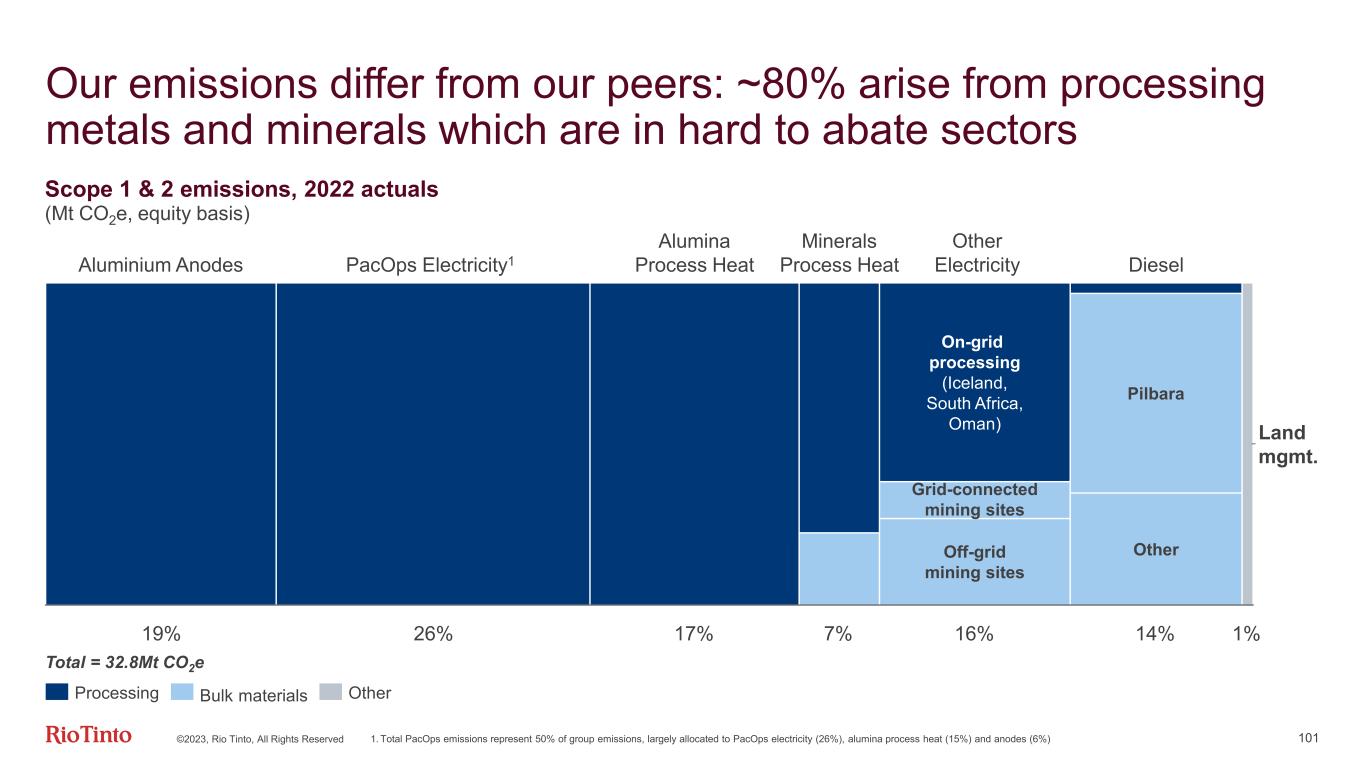
©2023, Rio Tinto, All Rights Reserved 101 Our emissions differ from our peers: ~80% arise from processing metals and minerals which are in hard to abate sectors Total = 32.8Mt CO2e Aluminium Anodes PacOps Electricity1 Alumina Process Heat Minerals Process Heat On-grid processing (Iceland, South Africa, Oman) Grid-connected mining sites Off-grid mining sites Pilbara Other Diesel Land mgmt. Scope 1 & 2 emissions, 2022 actuals (Mt CO2e, equity basis) 26% 16%19% 17% 14%7% 1% Processing Bulk materials Other Other Electricity 1. Total PacOps emissions represent 50% of group emissions, largely allocated to PacOps electricity (26%), alumina process heat (15%) and anodes (6%)
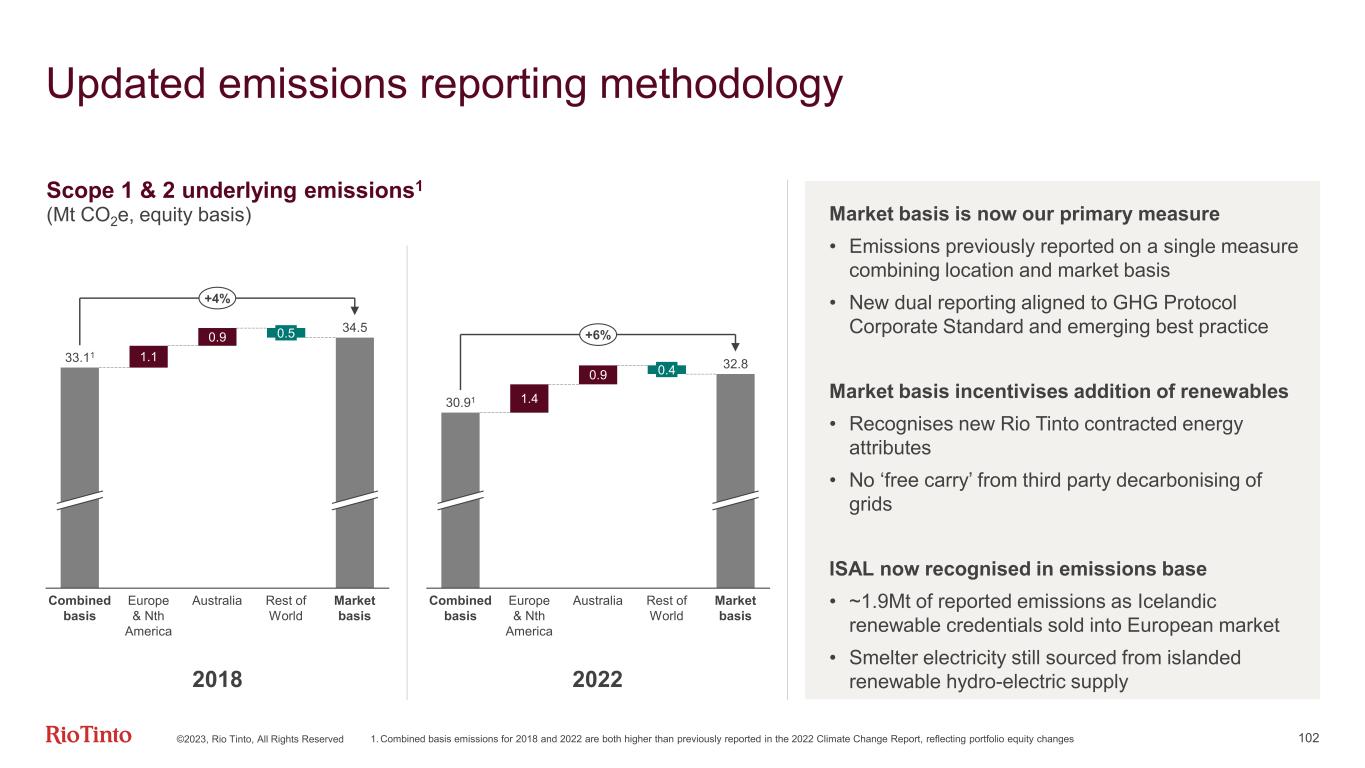
©2023, Rio Tinto, All Rights Reserved 102 Updated emissions reporting methodology 1.1 0.9 Combined basis Europe & Nth America Australia 0.5 Rest of World Market basis 33.11 34.5 +4% 1.4 0.9 Combined basis Europe & Nth America Australia 0.4 Rest of World Market basis 30.91 32.8 +6% Market basis is now our primary measure • Emissions previously reported on a single measure combining location and market basis • New dual reporting aligned to GHG Protocol Corporate Standard and emerging best practice Market basis incentivises addition of renewables • Recognises new Rio Tinto contracted energy attributes • No ‘free carry’ from third party decarbonising of grids ISAL now recognised in emissions base • ~1.9Mt of reported emissions as Icelandic renewable credentials sold into European market • Smelter electricity still sourced from islanded renewable hydro-electric supply2018 2022 Scope 1 & 2 underlying emissions1 (Mt CO2e, equity basis) 1. Combined basis emissions for 2018 and 2022 are both higher than previously reported in the 2022 Climate Change Report, reflecting portfolio equity changes

©2023, Rio Tinto, All Rights Reserved 103 500,000+ hectares of land committed to high integrity nature-based solutions globally by 2025 Sourcing and investing in high-quality nature-based solutions projects to meet compliance requirements (e.g. Safeguard Mechanism) or complement our development portfolio Developing long-term partnerships that provide additional support to projects and guarantee credits offtake Developing nature- based solutions in our operating regions Building nature-based solutions partnerships Developing high integrity projects in Guinea, Madagascar and South Africa Aiming for 1 Mtpa development portfolio by 2030 – pilots advanced in Madagascar, opportunities to replicate in Guinea and South Africa in 2024 Addressing nature loss, climate change and community challenges Financing urgent nature protection and restoration Generating high quality carbon credits to complement our decarbonisation efforts

©2023, Rio Tinto, All Rights Reserved 104 In May 2023, our Boron operation became the world’s first open pit mine to go 100% biofuel – reducing up to 45kt of CO2e per annum Biofuels approach • Electrification will be the most efficient and cost-effective pathway to our zero-emission end state for diesel we believe, with meaningful effect post 2030. In the interim, we need to develop and deploy alternative abatement solutions available today, such as biofuels. • Biofuels critical to our transition and pivotal in supporting our near-term emission reduction commitments (2030). It is technically feasible with successful trials at Boron and Kennecott Copper operations. • Key challenge is access to sustainable non-edible feedstock at acceptable product premiums – we must consider the GHG impact across full life cycle of the biofuel (both scope 1 and scope 3). • In current markets, this is challenging and results in product costs higher than diesel fuels and we expect sustainable biofuels will likely continue to be relatively expensive outside subsidised regions. • The pragmatic pursuit of biofuels as an interim decarbonisation solution serves multiple benefits: - Protects us against carbon tax scenarios; - Enables a response to carbon penalties or subsidy opportunities; and - Affords time for suppliers, markets, supply chains and regulators to mature future zero-emission electrification technologies and ensure safe deployment in our operations. • We are exploring opportunities to support the development of the biofuel value chain, influence the type of biofuel feedstock and build scale. Above: Neste MY Renewable Diesel is a Hydrotreated Vegetable Oil (HVO) made from 100% sustainably sourced renewable raw materials – used at Boron Below: Biofuel powered truck at our Boron operations in California Boron case study • In May, we fully transitioned to renewable biofuel at Boron in the U.S, reducing up to 45kt of CO2-e per year. • Boron is the first open pit mine globally to fully transition to renewable biofuel. • Trial conducted in 2022 in partnership with Neste and Rolls-Royce to use Neste MY Renewable Diesel™ - 100% renewable raw materials such as used cooking oil and animal fat waste. • Trial showed trucks with renewable diesel delivered similar performance and reliability to conventional diesel. • Important first step and will lead to further opportunities to decarbonise our operations with biofuels and an excellent example of what can be achieved when partners (State of California, Neste and Rolls-Royce) collaborate toward a carbon reduction goal.

©2023, Rio Tinto, All Rights Reserved 105 The transition to renewable power generation in our Pilbara iron ore business will deliver additional value Rio Tinto and Yindjibarndi Energy Corporation (YEC) have signed a memorandum of understanding (MOU) to explore opportunities to collaborate on renewable energy projects on Yindjibarndi country in the Pilbara Case Study Simon Trott with Yindjibarndi Aboriginal Corporation chief executive Michael Woodley Initial development of 75 – 150MWAC solar PV Gas displacement of 2.5 – 5.0PJ from existing gas- fired power stations per annum Carbon savings of 130 – 260kt CO2e per annum Gas displacement Approximately 600 – 700MW of renewable power generation is estimated to be required to displace up to 80% of gas consumption for our Pilbara iron ore operations. The proposed renewable portfolio to displace the majority of gas usage is value accretive. Partnerships We are exploring a number of innovative solutions to accelerate decarbonisation, such as use of existing land access and post-mine closure land for future renewable developments. This includes collaboration with Traditional Owner groups in the region. Progressing studies We are continuing to study and negotiate the development of the proposed coastal solar farm. We are also pursuing additional opportunities to decarbonise our operations by advancing studies on other sites adjacent to our network (including additional solar/wind and battery solutions). Potential coastal solar site being studied Accelerated schedule with first operations starting from 2027 - 2030 Close proximity to operations, reducing transmission infrastructure spend “This will strengthen our existing partnership and provide long term benefits for our community, while also ensuring that we can protect and preserve the areas of cultural, spiritual and environment significance within our Ngurra.” Michael Woodley, YEC chief executive

©2023, Rio Tinto, All Rights Reserved 106 Iron & Titanium has advanced breakthrough decarbonisation options – creating optionality to adjust to a changing environment Rio Tinto and Aymium have worked together over the past two years to develop a biocarbon product that has demonstrated exceptional efficacy in ilmenite smelting during internal trials at the Iron and Titanium Quebec Operations facilities in Sorel-Tracy, Quebec. Our recently strengthened partnership marks a significant milestone in our joint efforts to accelerate the transition away from fossil-based energy sources, with the objective of producing renewable biocarbon at scale to help Rio Tinto achieve its 2030 emission reduction targets. Technology and Critical Minerals Centre in Sorel-Tracy Biocarbon A drop-in/short-term opportunity to implement a proven technology in Canada – to produce sustainable biocarbon a strategic raw material essential to achieve Rio Tinto's decarbonisation commitments within several of our business units. BlueSmelting™ A technological change combining mature pre-reduction technology from an existing smelter gas-based process, with advanced hydrogen-based technologies under development. Minerals processing decarbonisation – Rio Tinto Technology and Critical Minerals Centre The concept was to develop a portfolio of fast pace and agile options in order to accelerate and de-risk future projects and meet decarbonisation targets. Several of them have been delivered safely in record time, drawing on the skills and experience of the teams based in Canada and globally. “We are delighted to work with Aymium to develop and trial this renewable biocarbon product that has real potential as an alternative, low carbon source for our processes. We are investing to deepen our partnership, as part of our commitment to finding better ways to decarbonise our operations and the supply chains we are part of.’’ Sinead Kaufman, Chief Executive Minerals Accelerated development schedule 2022-2024 Significant emissions reduction potential across all business units of Rio Tinto in Canada Successful full-scale trials in May 2023 at RTIT Quebec Operations Biocarbon Case Study – Aymium partnership Learnings from BlueSmelting™ development and construction project

NutonTM ©2023, Rio Tinto, All Rights Reserved 107

% o re e xt ra ct io n Nuton Up to 85% Conventional heap leach chemistry 25-35% NutonTM expected to deliver exceptional recovery Up to 85% recovery from primary copper sulphides, compared to 25-35% from traditional heap leach Lower CO2 emissions, TMM1 and friendly ore to 99% cathode process A broad range of applications (brownfield, greenfield and reclamation) Efficient water consumption and no tailings Carbon intensity (CO2/t) % extractions from primary copper mineralogy Time (days) % o re e xt ra ct io n Modelled copper extraction Margin of error Actual 1 TMM = Total Material Movement.©2023, Rio Tinto, All Rights Reserved 108 Actual test results have supported our modelling work Nuton delivers leading ESG performance

A Rio Tinto venture Asset/ company Current investment/agreement Key terms/ Nuton rights Johnson Camp Mine, AZ Excelsior Mining Inc. (TSX) Nuton Collaboration Agreement and option to JV Agreement Agreement with full pathway on demonstration and deployment • Testing programme underway • Option to earn-in up to 49% at the asset level with 100% marketing rights Yerington, NV Lion Copper & Gold (TSX) Option to Earn-in Agreement Stage 2 in progress • Option to earn up to 75%, with operating and marketing rights Cactus Mine, AZ Arizona Sonoran (ASCU) (TSX-V) Own 7.2% ASCU Investor Rights Agreement Testing Agreement • Testing programme underway • Nuton exclusivity • Tech Committee rep Los Azules, Argentina McEwen Copper (MEC) (Private) Own 14.5% McEwen Copper (Private), Nuton Collaboration Agreement • Testing programme underway • MEC Board seat • Nuton collaboration committee representative • Exclusivity over heap-leach technologies until Feb 2025 AntaKori, Peru Regulus Resources (REG) (TSX-V) Own 16% Regulus Investor Rights Agreement • Testing programme underway • REG Board seat, Tech Committee representative The NutonTM portfolio today ©2023, Rio Tinto, All Rights Reserved 109

©2023, Rio Tinto, All Rights Reserved 110 Common acronyms $ United States dollar CuEq Copper equivalent km kilometre PNG Papua New Guinea Calculated abatement carbon price The levelised marginal cost of abatement at a zero carbon price Calculation: Discounted sum of all abatement costs over time at a zero carbon price / Discounted sum of all abated emissions over time Discounted at the hurdle rate RT uses for all investment decisions AIFR All Injury Frequency Rate CDA Co development agreement Kt Kilo tonnes PPA Power Purchasing Agreement Al Aluminium dmtu Dry Metric Tonne Unit Ktpa Kilo tonnes per annum QAL Queensland Alumina Limited AUD Australian dollar DR Direct Reduction KUC Kennecott Utah Copper R&D Research and Development B2O3 Boric oxide DRI Direct Reduction Iron LHS Left hand side RBM Richards Bay Minerals BF Blast furnace DWT Deadweight tonnage Li Lithium REC Renewable Energy Certificate bn Billion E&E Exploration and Evaluation LME London Metal Exchange RHS Right hand side BOF Blast Oxygen Furnace EAF Electric Arc Furnace M&A Mergers and Acquisitions RMB Renminbi BSL Boyne Smelter Limited EBITDA Earnings Before Interest, Taxes, Depreciation and Amortisation MAC Marginal Abatement Cost RT Rio Tinto Bt Billion tonnnes ESG Environmental, Social, and Governance MENA Middle East and North Africa RT Share Rio Tinto Share C Celcius EU European Union Mlb Million pounds RTIT Rio Tinto Iron and Titanium c/lb US cents per pound F Forecast Mt Million tonnes RTM Rio Tinto Marines CAGR Compound annual growth rate Fe Iron Mtpa Million tonnes per annum SPS Safe Production System Capex Capital expenditure FOB Free on board MW Megawatt tCO2 Tonne of carbon dioxide CBAM Carbon Border Adjustment Mechanism GDP Gross Domestic Product MWh Megawatt hour tCO2 e Tonne of carbon dioxide equivalent CCS Carbon Capture and Storage GHG Greenhouse gas Ni Nickel TSV Transhipment vessel CCUS Carbon capture, utilisation and storage GJ Gigajoules NPV Net present value UG Underground CFR Cost and freight H2 Hydrogen OEM Original Equipment Manufacturer US United States CIOH Chinalco Iron Ore Holdings Consortium HBI Hot briquetted iron OT Oyu Tolgoi USD United States dollar CO2 Carbon dioxide HSSEC Health Safety Security Environment and Community OTFS20 Oyu Tolgoi Feasibility Study 2020 VPPA Virtual power purchase agreement CO2e Carbon dioxide equivalent HMS Heavy mineral sands P&L Profit and loss WCS Winning Consortium CSP Communities and Social Performance IOC Iron Ore Company of Canada PacOps Rio Tinto Pacific Operations YoY Year on Year CTG Compagnie du TransGuinéen IRR Internal rate of return PDR People's democratic republic YTD Year to date Cu Copper JV Joint Venture PGE Platinum group elements Definitions
